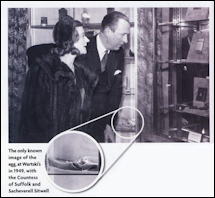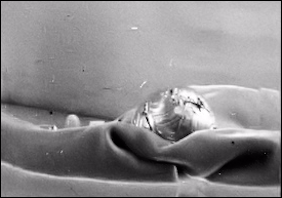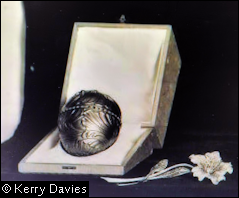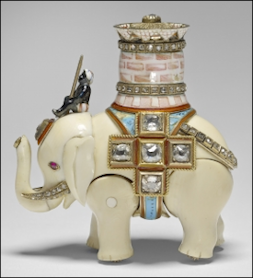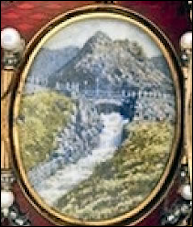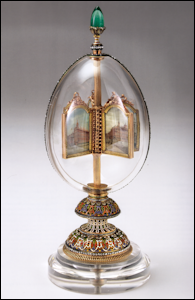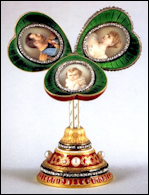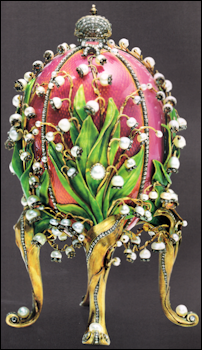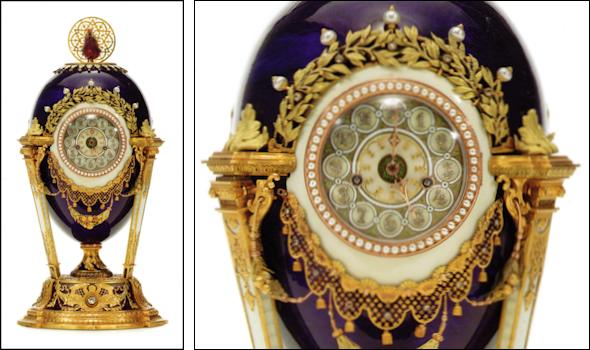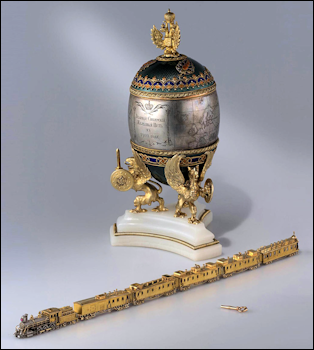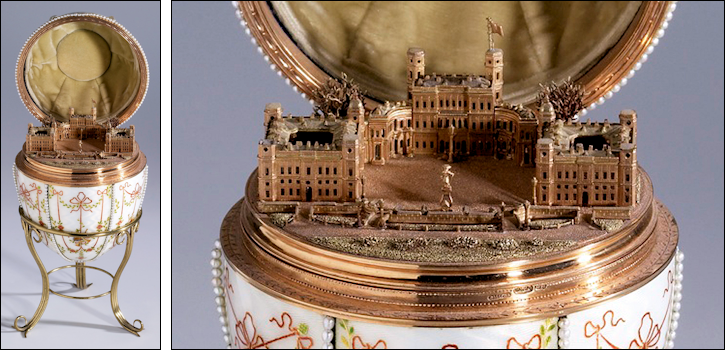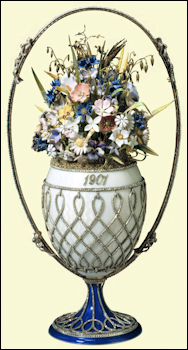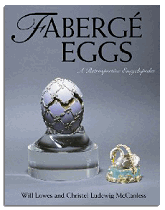
Lowes & McCanless, 2001
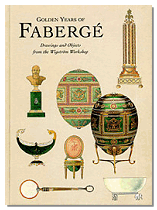
Tillander-Godenhielm, 2001
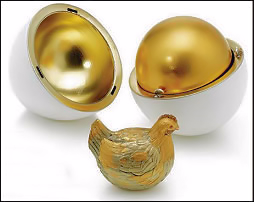
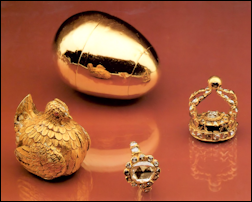
First Fabergé Imperial Egg and a Possible Prototype – Saxon Royal Egg, Collection
of Augustus the Strong (1670-1733)
(Courtesy Fabergé Museum, St. Petersburg, Russia; Géza von Habsburg)
However, Fabergé, Proler, & Skurlov reported in Fabergé Imperial Easter Eggs (London, 1997), an exchange of letters between Tsar Alexander III and his brother, the Grand Duke Vladimir Alexandrovich, which settles the issue beyond doubt.
In a letter dated March 21 (OS), 1885, Grand Duke Vladimir Alexandrovich advises Alexander III that:
The letter goes on to describe in detail how the egg and its various surprises should be correctly opened. Alexander III replied the same day from Gatchina Palace:
Obviously the tsarina was delighted, for a tradition had begun that would become the zenith of the decorative arts in the Western world. While these letters explain when the tradition started, the reason why is still not known. The last sentence of the tsar’s letter suggests there was a specific reason for the gift.
H. C. Bainbridge was adamant that Fabergé approached the tsar with the idea (Presentation of Imperial Russian Easter Gifts by Carl Fabergé (New York), and Hammer Galleries exhibition catalog, September 8 – November 30, 1939). Mogens Bencard in the exhibition catalog, Maria Feodorovna, Empress of Russia (Copenhagen, 1997), believes there was a meeting between Fabergé and the tsarina (and not the tsar) before the egg was made. Suggestions have been made that Armand Hammer took the Tsar Imperial First Hen Egg out of Russia. Indeed, Hammer himself claimed to have done so. However, the egg Hammer purchased was sold to Matilda Geddings Gray and is still in the Gray Foundation Collection. It is not the egg sold at the Christie’s auction in London on March 15, 1934, which is the first Tsar Imperial egg. Further detail can be found under ‘Crown Egg’ in the first two citations listed above.
A. Kenneth Snowman pointed out a similar egg exists in the Danish Royal Collection, which may well have been known to Marie, formerly the Danish Princess Dagmar. Fabergé made a number of other eggs similar to the First Hen Egg. Géza von Habsburg in “Fabergé’s Imperial Eggs – Their Inspirations and Prototypes” (Fabergé Research Newsletter, Fall 2013) discusses several prototypes for this egg.
- March 24 (OS), 1885. Would have been presented to Marie Feodorovna, a gift from Alexander III; cost 4,151 rubles, 75 kopecks. Housed in the Anichkov Palace
- September 16-20 (OS), 1917. One of forty or so eggs sent to the Armoury Palace of the Kremlin in Moscow by the Kerensky Provisional Government for safekeeping
- ca. 1920s. Bought by dealer, Derek (Editor’s note: Frederick?) Berry, London, probably from Russian officials in Berlin or Paris
- March 15, 1934. Lot 55 sold by Christie’s (London) from the Derek (Editor’s note: Frederick?) Berry Collection, UK, for £85; $430, to Mr. R. Suenson-Taylor, UK
- June 1955. Owned by Lord Grantchester, barrister and financier. Sir Alfred Suenson-Taylor was created first Baron Grantchester, June 30, 1953
- 1961. Owned by Mamie Suenson-Taylor, Lady Grantchester, UK
- 1976. Owned by estate of Lord and Lady Grantchester. They died within months of each other
- Acquired by A La Vieille Russie, New York
- January 16, 1978. Sold by A La Vieille Russie to the Forbes Magazine Collection, New York, for $126,250
- February 2004. Sold privately as part of the Forbes Magazine Collection, New York, to Viktor Vekselberg, Moscow, for just over $100 million, according to the purchaser
- November 19, 2013. Fabergé Museum, St. Petersburg, Russia
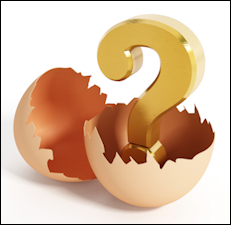
Fabergé made the hen of gold, set with rose-cut diamonds, arguing that it would look like bronze otherwise and would not be beautiful. The sapphire egg was held loosely in the hen’s beak, and the wicker basket was made of gold and apparently decorated with rose-cut diamonds. The whole consisted of one sapphire egg costing of 1800 rubles out of 2,986 rubles, 50 rose-cut diamonds 8/32, 60 rose-cut diamonds 14/32, 400 rose-cut diamonds 5¼; gold, and two cases. Diamond weights are given in the old systems used by European jewelers. Was the egg possibly dismantled for the value of its stones?
- April 5 (OS), 1886. Sent to Tsarskoe Selo by courier and presented to Tsar Alexander III
- April 13 (OS), 1886. Would have been presented to Marie Feodorovna, a gift from Alexander III; cost 2,986 rubles, 25 kopeks. Housed in the Anichkov Palace
- September 16-20 (OS), 1917. One of forty or so eggs sent to the Armoury Palace of the Kremlin in Moscow by the Kerensky Provisional Government for safekeeping
- 1922. May have been transferred to the Sovnarkom, the Council of People’s Commissars
- 2015. Whereabouts unknown. There is no known illustration of it.
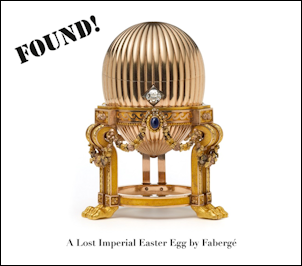
(Courtesy Wartski)
The Russian State Historical Archives material cited by Marina Lopato (Apollo, January 1984) describes the egg as an …Easter egg with a clock, decorated with brilliants, sapphires and rose diamonds – 2160 rubles. In March 2014, Wartski’s website noted research by Tatiana Muntian on the record of transfer in September 1917 from the Anichkov Palace to the Moscow Kremlin Armoury: …Art. 1548. ˜A lady’s gold watch, opened and set into a gold egg with one diamond. The latter on a gold tripod pedestal with three sapphires.’ Number 1644. Muntian’s research cited in von Solodkoff, Fabergé: Juweiler des Zarenhofs (Hamburg, 1995), yielded another description of this egg. The 1919 inventory of confiscated Imperial treasure describes it as a …Gold egg with clock with a circle of brilliants, gold stand, with three sapphires and diamond roses. And the 1922 transfer documents of confiscated valuables from the Anichkov Palace to the Sovnarkom says: …Gold egg with clock with diamond pushpiece, on gold pedestal with 3 sapphires and rose-cut diamonds roses.
However, on July 6, 2011, Anna and Vincent Palmade reported at the Fabergé Forum in Richmond they had discovered a very good picture and detailed description of the missing 1887 Egg in the Parke Bernet auction catalogue for their New York sale of March 6-7, 1964 (lot 259). Although there were no mention of Fabergé in the catalogue description, they were able to match the picture and descritpion with the picture of the missing Egg in the von Dervis 1902 exhibition which they had found in November 2007, and which Annemiek Wintraecken was able to associate with the 1887 missing Egg in her revised timeline (November 2008). The description in the catalogue matches perfectly the description for the 1887 missing Egg in the archival documents (especially the references to the watch and the three sapphires):
It is the reference to the Vacheron & Constantin watch in the catalogue description which eventually led to the discovery of the Egg. In effect, the unsuspecting owner of the Egg once Googled the terms “egg” and “Vacheron Constantin” and found the article from the British newspaper “The Telegraph” (13 August 2011) referring to the discovery of the picture and description of the missing 1887 Egg in the 1964 Parke Bernet catalogue.
Then in March 2014, the London Fabergé dealer Wartski announced the Egg had been found. Wartski released the first color photographs of the Egg on its website, which describes the Egg thus:
Wartski advised they had purchased the Egg and sold it to an undisclosed bidder. In a flurry of word-wide newspaper articles, more specific details came to light. The first one written by Anita Singh for The Telegraph newspaper in London on March 18, 2014, based on an interview with Kieran McCarthy of Wartski carried the headline, The £20m Fabergé Egg That Was Almost Sold for Scrap.
An Internet publication, ecommercebytes.com reported on April 6, 2014:
In early 2015, thanks to two Russian scholars Drs. Galina Korneva and Tatiana Cheboksarova, an archival letter was found which had been written on May 4 (OS), 1887 by Modest Feopemtovich Solovyev, the Governor of the Office of Grand Duke Vladimir’s Court from 1881 to 1899, to Nikolai Stepanovich Petrov (1833-1913), who in 1887 was the Head of Cabinet of Alexander III. It reads:
By order of H.I.H. Grand Duke Vladimir Alexandrovich an Easter egg with a clock and a stand in the style of Louis XVI was commissioned to the jeweler Fabergé. This egg is finished and was delivered to the Emperor. Today Fabergé sent an invoice of 2,160 rubles which H.I.H. commanded me to send to Your excellence. M. Solovyev.
Grand Duke Vladimir Alexandrovich had been heavily involved in the creation of the First Hen Egg.
Kieran McCarthy of Wartski in a public lecture in English and Russian on June 4-5, 2015 at the Fabergé Museum, St. Petersburg, Russia, gave his first-hand account of the rediscovery of the 1887 Third Imperial Easter.
- April 5 (OS), 1887. Would have been presented to Marie Feodorovna, a gift from Alexander III; cost 2,160 silver rubles. Housed in the Anichkov Palace
- September 16-20 (OS), 1917. One of forty or so eggs sent to the Armoury Palace of the Kremlin in Moscow by the Kerensky Provisional Government for safekeeping
- Between February 17-March 24, 1922. Transferred to the Sovnarkom, the Council of People’s Commissars, possibly bought by Hammer Galleries, New York
- March 6-7, 1964. Offered by Mrs. Rena Clark of New York at Parke-Bernet’s (New York) auction. Sold to a female buyer from the deep south of the US for $2,450
- ca. 2004. Bought for $14,000 by a scrap-metal dealer in the mid-west of the US
- 2014. Sold by this dealer to Wartski London and bought from them by an identified buyer for an undisclosed sum, estimated by market observers at about £20 million
Third Imperial Easter Egg by Fabergé Found! A Research Chronology compiled by Christel Ludewig McCanless, and published in Fabergé Research Newsletter, Summer 2014, summarized the history of the egg since 1887.
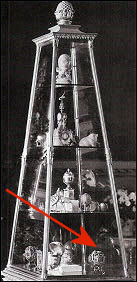
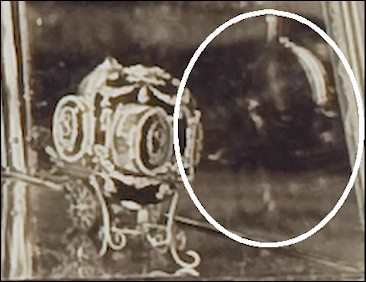
Maria Feodorovna Vitrine in von Dervis 1902 Exhibition with Egg and Its Reflection
(Archival Photographs)
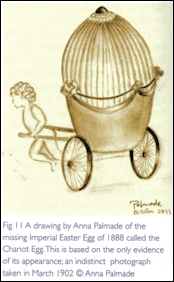
Anna Palmade Drawing and
Possible Prototype
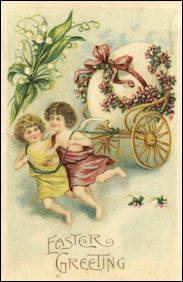
Cherub Egg with Chariot
(1888)
(Munn, Geoffrey, “Unscrambled Eggs”, Antique Collecting (UK), June 2015, 44)
Tatiana Muntian, in her article in von Solodkoff, Fabergé: Juwelier des Zarenhofes (Hamburg, 1995) cites the inventories made in 1917 and 1922 of confiscated Imperial treasure. The 1917 list includes the following: “… gold egg, decorated with brilliants, a sapphire; with a silver, golded [sic] stand in the form of a two-wheeled wagon with a putto.” Muntian claims 1885 as the date the egg was made, but in the opinion of these authors, it must surely be the 1888 egg. It may be significant that neither of these descriptions mentions a clock.
In November 2007, Anna and Vincent Palmade discovered the Egg in a picture of the von Dervis 1902 exhibition. The Egg had been unnoticed because it was hiding behind the Caucasus Egg in the picture. It was revealed through its blurry reflection in the vitrine.
- April 24 (OS), 1888. Would have been presented to Marie Feodorovna, a gift from Alexander III; cost 2,100 silver rubles
- March 1902 Shown in von Dervis exhibition (see illustrations above)
March 28 (OS), 1891. Housed at the Gatchina Palace - September 16-20 (OS), 1917. One of forty or so eggs sent to the Armoury Palace of the Kremlin in Moscow by the Kerensky Provisional Government for safekeeping
- February-March 1922. Transferred to the Sovnarkom, the Council of People’s Commissars
1930s. Possibly sold to Victor & Armand Hammer - September 26-27, 1941. Possibly part of lot 258 sold by Parke Bernet (New York) from the Collection of Mrs. Ethel Gunton Douglas of New York City, to an unknown buyer for $22.50 [sic]
- 2015. Whereabouts unknown
Pearl egg* – gold, rose-cut diamonds | Ring – gold, pearl
On page 3 of the file, dated February 22 (OS), 1889, a small egg-shaped leather case for the Easter egg is ordered, and on page 5, an account details one egg, one pearl 7.24/32 carats, five rose-cut diamonds, gold and double case, total cost 981 rubles, 20 kopeks. This figure of 981 rubles has been added in pencil to the bottom of the handwritten list of the Imperial Easter eggs from 1885 to 1890, made by N. Petrov, the assistant manager to the Cabinet of His Imperial Majesty. The list was found in the Russian State Historical Archives in St. Petersburg by Marina Lopato, and quoted in Apollo, January 1984 but these detailed descriptions do not agree with the invoice Fabergé sent to the Tsar on May 4 (OS), 1889, which details “1 Louis XV Nécessaire egg 1900 rubles”. (Fabergé, Proler, & Skurlov, Fabergé Imperial Easter Eggs, London, 1997)
Tatiana Muntian says in von Solodkoff, Fabergé: Juwelier des Zarenhofes (Hamburg, 1995) that she found the following descriptions in the 1917 inventory of confiscated Imperial treasure: “gold egg/nécessaire, decorated with multi-colored stones and with brilliants, rubies, emeralds and sapphires.” Her fellow researcher, Valentin Skurlov, dated the egg at 1889, and the 1922 inventory of confiscated Imperial treasure concurs.
Tatiana Muntian says in her research published in von Solodkoff, Fabergé: Juwelier des Zarenhofes (Hamburg, 1995) the Resurrection Egg has no place in the list of Imperial Easter eggs presented by the Tsar. Her argument is convincing, especially in light of the Fabergé invoice, the inventory of confiscated Imperial treasure, and yet another description, noted when Marie Feodorovna took the egg from the Gatchina Palace to Moscow: “One item in the form of an egg, decorated with stones, containing ladies’ toilet articles, 13 pieces. Taken by the valet Ivoshkin when Their Majesties travelled to Moscow.” (Fabergé, Proler, & Skurlov, Fabergé Imperial Easter Eggs, London, 1997)
This coincides almost precisely with the description of item number 20 in the Loan Exhibition of the Works of Carl Fabergé, which opened at Wartski London on November 8, 1949. Lent anonymously, the piece is described as “a Fine Gold Egg, richly set with diamonds, cabochon rubies, emeralds, a large colored diamond at top and a cabochon sapphire at point. The interior is designed as an Etui with thirteen gold and diamond set implements.” It would be the most extraordinary coincidence if these two eggs are not the same item, especially as Alexander III had stipulated there were to be no repetitions.
In March 2008, Kieran McCarthy of Wartski published material he had found in his employer’s files relating to lot 20 in the 1949 Wartski exhibition. The etui, which could well be the Nécessaire Egg, is partially shown on the bottom shelf of a display cabinet in a photograph taken at the exhibition. (Country Life, March 20, 2008, 60-61, excerpted in Fabergé Research Newsletter, The Missing Nécessaire Egg, April 2008 Anniversary Edition, and in Royal Russia, Annual no. 3, 2011, 92-93. McCarthy goes on to explain the item was lent anonymously for the exhibition and then in 1952 bought by Wartski’s who sold it the same year for £1200 to “a stranger.” McCarthy believes the purchaser was almost certainly British and that the current owners are unaware of its probable Imperial provenance.
There is as yet, no explanation regarding the original Pearl Egg*. The authors are of the view that the Pearl Egg, or the Pearl Egg pendant, as it is described by Fabergé, Proler, & Skurlov in Fabergé Imperial Easter Eggs (London, 1997) was not the annual Easter gift from Alexander III to Marie Feodorovna. Apart from questions of dating arising with the Petrov list, Fabergé makes no mention of the egg pendant in his Easter bill to the Tsar. It seems possible initial plans were for the Pearl Egg to be the Easter gift, but that something happened which required the making of a second present, namely, the Nécessaire Egg. It should be noted both items were relatively inexpensive when compared with the cost of past and future Tsar Imperial Easter eggs.
- March 16 (OS), 1889. Pearl Egg presented to Alexander III at Gatchina Palace; cost 981 rubles, 20 copecks
- April 9 (OS), 1889. Nécessaire Egg would have been presented to Marie Fedorovna, a gift from Alexander III; cost 1,900 silver rubles
- March 28 (OS), 1891. Nécessaire Egg housed at the Gatchina Palace
- September 16-20 (OS), 1917. One of forty or so eggs sent to the Armoury Palace of the Kremlin in Moscow by the Kerensky Provisional Government for safekeeping
- February – March 1922. Transferred to the Sovnarkom, the Council of People’s Commissars
- Sold to a UK buyer
- June 19, 1949. Transferred from Wartski Llandudno, Wales, to Wartski, London, sold the same day to “a stranger” for £1,250
- 2015. Whereabouts of both eggs unknown; the Nécessaire Egg is possibly in a bank vault in the north of England
- December 2017. An amateur Fabergé sleuth, Kellie Bond found online the best image yet found of the Nécessaire Egg. See Daily Mail December 30, 2017, p. 3
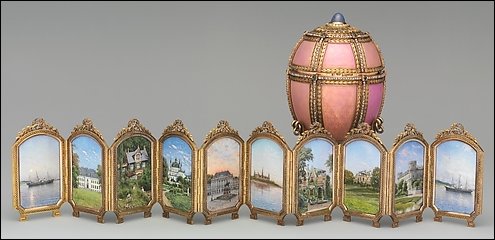
(Keefe, John W., Masterworks of Fabergé:
The Matilda Geddings Gray Foundation Collection, 2008, 88-89)
- Imperial yacht Polar Star
- Bernsdorff Palace, Copenhagen
- Kejserens Villa in Fredensborg Park
- Fredensborg Palace from the Marble Garden
- Schack Palace in the Amaliensborg Palace complex
- Kronborg Castle, Elsinore
- Two views of the Cottage Palace, Alexandreskii Park, Peterhof
- Gatchina Palace, near St. Petersburg
- Imperial yacht Tsarevna
The egg retains its original velvet case; the stand is modern.
And yet, existing literature dated the egg at 1895, probably because that date had been written in ink on the velvet case. We know from the memoirs of François Birbaum in von Habsburg & Lopato, Fabergé: Imperial Jeweller (London, 1993) Tsar Alexander III had laid down broad rules relating to the eggs: that the egg shapes continue, but that there be no repetitions. With this in mind, there surely cannot be two eggs in pink enamel in the Louis XVI style, especially within five years of each other. The date 1895 was probably written on the egg’s case during the 1922 inventory of confiscated Imperial treasure. It seems the real 1895 gift, the Blue Serpent Clock Egg, was not among the eggs listed in this inventory or that of 1917, and an assumption regarding the egg was made at that time. Proof that the Danish Palaces Egg was made before 1895 is available from a list made when the Imperial couple traveled, taking with them items from Gatchina Palace: “Egg consisting of 10 pieces (small folding screen). His Majesty took it to Petersburg on 31 December (OS), 1891, and returned it on 28 March (OS), 1892.” (Fabergé, Proler, & Skurlov, Fabergé Imperial Easter Eggs, London, 1997) It is definitely identified in the 1917 inventory of confiscated Imperial treasure and possibly in the inventory made in 1922.
A 1932 scrapbook belonging to the Hammer Galleries further confuses the history of this egg by describing the egg as having twelve panels, not ten, and a cut and re-glued photograph shows the egg sitting in a wooden box, not in the original velvet case (Hammer Galleries Book I, 1932). The twelve-panel description is repeated in Compleat [sic] Collector, April 1943. To complicate matters further, the Hammer Galleries exhibition of 1939 has a photograph showing only ten frames, and showing the frames as the surprise for this egg. Despite all these varying descriptions, it now seems clear only ten miniatures ever existed. The scenes depicted on the miniatures were places familiar to Marie Feodorovna, and the yachts she used to travel in. For many years, the third panel of the Egg was wrongly identified as the estate of Hvidøre. Russian scholars Galina Korneva and Tatiana Cheboksarova identified in their publication, Empress Maria Feodorovna’s Favorite Residences in Russia and in Denmark (St. Petersburg, 2006) the palaces in the order listed above. Danish Fabergé enthusiast Christian Steener Eriksen had also noticed Marie Feodorovna and her sister Queen Alexandra of Great Britain had not bought the property until 1906, so a miniature of the residence could not have been included in an Easter gift made for 1890. On September 1, 1889, the New York Times reported:
In 2008 research by Annemiek Wintraecken and Steener Eriksen they found other documentation in which Alexander III expressed a wish in September 1885 to have his own residence in Fredensborg. Petrel’s Nest, a property in the palace gardens was bought, refurbished, and opened with a tea-party on October 1, 1889. Marie Feodorovna baptized the building and described it as ‘Our dear miniature Gatchina’. The house became known as the Kejserens Villa (Emperor’s Villa). In October 1980, the Egg was stolen while on exhibition at the Paine Art Center and Arboretum in Oshkosh, Wisconsin. It was recovered soon after, following a high-speed police pursuit, during which it was jettisoned with two other Tsar Imperial eggs, the 1893 Caucasus Egg and the 1912 Napoleonic Egg.
- March 30 (OS), 1890. Presented to Alexander III
- April 1 (OS), 1890. Would have been presented to Marie Feodorovna, a gift from Alexander III; cost 4,260 silver rubles
- January 31 (OS), 1893. Housed at the Gatchina Palace
- September 16-20 (OS), 1917. One of forty or so eggs sent to the Armoury Palace of the Kremlin in Moscow by the Kerensky Provisional Government for safekeeping
- February-March 1922. Probably transferred to the Sovnarkom, the Council of People’s Commissars
- June-July 1927. One of eight eggs returned by the Moscow Jewelers’ Union to the Armoury; given inventory no. 17553
- April 30, 1930. One of twelve eggs selected for export sale
- June 21, 1930. Transferred from the Armoury to the Antikvariat (Trade Department)
- 1930. One of ten Imperial eggs sold by the Antikvariat, Moscow, to Hammer Galleries, New York, for 1,500 rubles (ca. $750)
- ca. October 1935. Advertised by Hammer Galleries for $25,000
- February 1936. Advertised by Hammer Galleries
- November 1937-1953. Owned by Mr. & Mrs. Nicholas H. Ludwig, New York
- 1962. Private collection, United States
- June 8, 1971. Collection of the late Matilda Geddings Gray, oil heiress, Lake Charles and New Orleans, Louisiana
- 1972. Matilda Geddings Gray Foundation, New Orleans, Louisiana
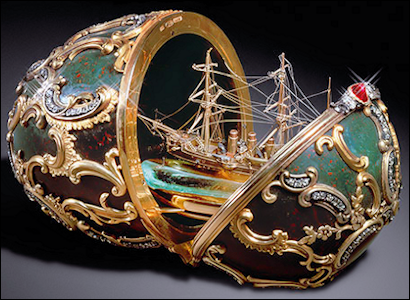
(Courtesy Armoury Museum, Moscow)
A second blow was parried by Prince George of Greece, the second son of King George I of Greece, who fended off the attack with his cane. George, a boyhood friend of Nicholas, had joined the eastern adventure in Athens, where the Russian princes stopped before traveling east. Nicholas told Marie Feodorovna: “I stopped and turned round and to see dear Georgie about ten paces from me, with the policeman, whom he had knocked to the ground with one blow of his cane, laying at his feet. Had Georgie not been in the rickshaw behind me, dearest Mama, perhaps I would never have seen you again!” Nicholas was left permanently scarred both physically and mentally, and the incident poisoned his view of the Japanese, whom he described in private as “monkeys.” The Ōtsu incident probably played a role in the Tsar’s ill-fated decision to go to war against the Japanese 13 years later. Blood from a handkerchief used to staunch the Tsesarevich’s wound was used 100 years later in the earliest DNA testing done to positively identify the body of Nicholas II.
Grand Duke George’s lung condition appeared to worsen, and he had already returned to Russia before Nicholas arrived in Japan. Tatiana Muntian has observed that “For people familiar with the unfortunate journey, the blood-red drops in the heliotrope and the bright red ruby of the knob had a sinister meaning”. (Muntian, et al. World of Fabergé, Moscow, 1996) Seven years later, she saw further symbolism in the egg:
The cruiser In Memory of the Azov was named in honor of the Azov, the first Russian battleship to be awarded the St. George flag. It won the honor for its role in the Battle of Navarino in 1827. A letter written by Eugène Fabergé on June 5, 1934, says the miniature was made “by the old (Editor’s note: August) Holmström, who especially put all his art into making the tiny ship as natural as possible so that the guns were movable and all the rigging exactly copied. Even the chains of the anchors were movable.” (Fabergé, Proler, & Skurlov, Fabergé Imperial Easter Eggs, London, 1997)
As stated above, this was one of the Tsar Imperial eggs which traveled from St. Petersburg and was returned to Gatchina Palace. In 1900, it was exhibited at the Exposition Internationale Universelle in Paris in 1900, along with the 1898 Lilies of the Valley, the 1899 Pansy, the 1897 Coronation, the 1900 Trans-Siberian Railway Eggs, and possibly the 1890 Danish Palaces Egg. But the 1891 Memory of Azov Egg did not impress the French judge, René Chanteclair:
Other judges, including Victor Champier and the noted enameller Louis Houillon, were more enthusiastic about Fabergé’s work. In any event, the Exposition brought Fabergé and his work to the notice of the world.
The Memory of Azov Egg is readily identifiable in both the 1917 and 1922 inventories of confiscated Imperial treasure. An expert valuation was made of this egg in 1927. Found by Fabergé, Proler, & Skurlov, the valuation noted the mast was damaged, one rose-cut diamond was missing, and there was “a noticeable crack in the jasper.” The egg’s worth was assessed at 8,880 rubles. With the 1902 Clover Leaf and 1906 Moscow Kremlin Eggs, this egg was scheduled for sale to the West. They were returned to the Armoury, following protests from workers and management within the Armoury.
- April 21 (OS), 1891. Would have been presented to Marie Feodorovna, a gift from Alexander III; cost 4,500 silver rubles
- November 27 (OS), 1891. Housed at the Gatchina Palace
- September 16-20 (OS), 1917. One of forty or so eggs sent to the Armoury Palace of the Kremlin in Moscow by the Kerensky Provisional Government for safekeeping
- February-March 1922. Transferred to the Sovnarkom, the Council of People’s Commissars
- June 17, 1927. One of sixteen eggs transferred from the Foreign Currency Fund of the Narkomfin (Finance Ministry) to the Armoury; given inventory no. 17536
- 1933. Was to be offered for sale at 20,000 rubles, but retained in the Armoury Museum, Moscow
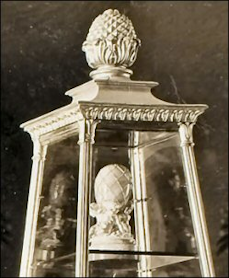
Diamond Trellis Egg in Maria Feodorovna’s
Exhibit Case, 1902 von Dervis Mansion Venue,
St. Petersburg, Russia
(Archival Photograph)
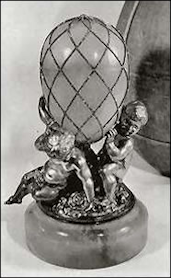
Egg Missing Its Surprise with Putti
Base, Sotheby’s London, 1960
(Archival Photograph)
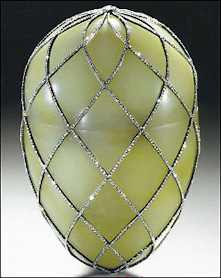
Egg Missing Its Surprise and Base
(Courtesy McFerrin Collection)
“The Egg is lined with white satin with a space for the figure of an elephant and a key for winding 1 Ivory figure of an elephant, clockwork, with a small gold tower; partly enameled and decorated with rose-cut diamonds, on its back; the sides of the figure bearing gold decorations in the form of two crosses, each with five precious stones. The elephant’s forehead is decorated with the same kind of stone. The tusks, trunk and harness are decorated with small rose-cut diamonds, and a black mahout is seated on its head.” (Fabergé, Proler, Skurlov, Fabergé Imperial Easter Eggs, London, 1997)
The elephant mentioned was the surprise inside the egg. At present, the egg exists alone in the Dorothy and Artie McFerrin Collection. The pedestal is either lost or survives elsewhere. The pedestal, but not the surprise, was still with the egg when it was sold by Sotheby’s London, on December 5, 1960. The catalog description includes the line …supported on the backs of three silver putti who are seated on a grassy mound ¦ There is an accompanying illustration of the egg with its pedestal of three silver putti. Toby Faber in Fabergé Eggs: The Extraordinary Story of the Masterpieces that Outlived an Empire (London, 2008) says the Diamond Trellis Egg was …subsequently separated from its genuine stand by Emanuel Snowman in [the] mistaken belief that this was a later addition. The elephant appears on the coat of arms of the Danish Royal family, and Marie, of course, was a Danish princess. The reference to the elephant being …clockwork suggests it was the first automaton used by Fabergé in a Tsar Imperial egg.
On October 10, 2015, the Curator of Queen Elizabeth II’s Fabergé collection, Caroline de Guitaut confirmed to the Lapidary Art Symposium at the St. Petersburg Fabergé Museum that an ivory automaton elephant in the Royal Collection matches the known descriptions of the Diamond Trellis Egg’s surprise. In consultation with Dorothy and Artie McFerrin, it was determined the miniature elephant fits the Diamond Trellis Egg. Ms. de Guitaut explained: “A fragment of the elephant’s turret was lost. It seems it had just fallen off due to the aged metal. Yet as a result, it was possible to look into the foundation of the figure. When we removed the top part of the turret, my heart nearly stopped beating: It contained the Fabergé hallmark! That is how we found the proof of the discovery’s authenticity.” She continued: “The newly discovered automaton surprise is almost identical to the badge of the Danish Order of the Elephant, the most senior order of chivalry in Denmark, except that it is made of ivory rather than white enamel and that it incorporates a mechanism. The elephant is wound with a watch key through a hole hidden underneath the diamond cross on one side of the elephant. It walks tentatively on ratcheted wheels and lifts its head up and down.” (See Royal Collection Trust video)
Apart from being the first known automaton surprise used in a Tsar Imperial Easter Egg, this mechanical elephant is seemingly among the first automata made by Fabergé. In comparison with the mechanical devices used in the 1906 Swan and 1908 Peacock Eggs, this automaton is almost primitive. But it is yet another example of Fabergé and his workforce trying something new and which, over time would be extensively and exquisitely refined. The automaton elephant this theme would be repeated eight years later in the 1900 Pine Cone Egg made for Barbara Kelch, neé Bazanova ,was the daughter of an extremely wealthy Moscow merchant family. In 1894, she married Alexander Ferdinandovich Kelch, a titled gold magnate and industrialist. In the years from 1898 to 1904, Kelch presented to his wife eggs quite on a par with their Imperial counterparts.
Tatiana Muntian’s research in von Solodkoff, Fabergé: Juwelier des Zarenhofes (Hamburg, 1995) quotes the 1917 inventory of confiscated Imperial treasure as including the …brilliant grill (-work/trellis) egg of 1892 – an egg of nephrite in gold setting, with a brilliant-covered net, base of nephrite with three silver putti. The 1922 inventory of confiscated Imperial treasure includes as a separate entry, …Ivory model of an elephant in gold setting with rose-cut diamonds and diamonds. According to Caroline de Guitaut, the newly discovered automaton surprise is almost identical to the badge of the Danish Order of the Elephant, the most senior order of chivalry in Denmark, except it is made of ivory rather than white enamel and incorporates a mechanism. The elephant is wound with a watch key through a hole hidden underneath the diamond cross on one side of the elephant. It walks on ratcheted wheels and lifts its head up and down.
It is possible the Diamond Trellis Egg is one of two Fabergé eggs referred to in an article by Alexander Mosyakin, …The Sale: Our Country’s Great Loss, in the Moscow newspaper Ogonyok, No. 7, February 1989. Mosyakin refers to two eggs both of …jadeite (sic) with dozens of brilliants being sold for $450 each. This sparse comment could be a rough description of the Diamond Trellis Egg. The description probably should refer to rose-cut diamonds, not brilliants. However, it is difficult to see how an egg with …dozens of brilliants could be worth only $450.
- April 5 (OS), 1892. Would have been presented to Marie Feodorovna, a gift from Alexander III; cost 4,750 silver rubles
- 1893? Housed at the Gatchina Palace
- September 16-20 (OS), 1917. One of forty or so eggs sent to the Armoury Palace of the Kremlin in Moscow by the Kerensky Provisional Government for safekeeping
- February-March 1922. Transferred to the Sovnarkom, the Council of People’s Commissars
- ca. 1927. Probably sold to Michel Norman of the Paris-based Australian Pearl Company or his associate Norman Weisz, by officials of the Antikvariat (Trade Department)
- Sold to Emanuel Snowman of Wartski, London
- 1929. Transferred from Wartski, Llandudno, Wales to Wartski, London, having been purchased for £125
- October 19, 1929. Bought from Wartski by T. B. Kitson, UK for £260
- December 5, 1960. Lot 92 sold by Sotheby’s London from the Collection of the late T. B. Kitson, UK, to buyer’s agent, Drager, for £2,400, $6744
- 1962-77. Private collection, UK
- May 1983. Private collection, London
- 1985. Private collection, US
- April 11, 2003. Lot 101 offered by Christie’s New York from a private American collection, passed at $1,300,000
- 2012. Dorothy & Artie McFerrin Collection, Houston Museum of Natural Science, Texas
Elephant Surprise:
- 1927-29: With Wartski; likely purchased separately from the Egg
- 1935. Sold to King George V, London, and possibly a gift for Queen Mary
- 2015. The Royal Collection, London
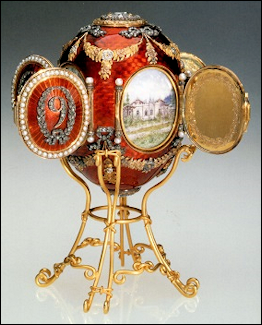
Caucasus Egg
(Keefe, Masterpieces of Faberge: The Matilda
Gray Foundation Collection, 2008, 84)
Early research suggested the images were of the Imperial Hunting Lodge, and this view was accepted through the 20th century. However, new and diligent research by Fabergé sleuth Annemiek Wintraecken indicates there was no Imperial hunting lodge per se in Abastuman, Georgia. The miniatures represent two houses especially built for Grand Duke George Alexandrovich when Abastuman was chosen as the place for him to live because of his tuberculosis, a water fall, and tents. Her archival research on the miniatures has discovered:
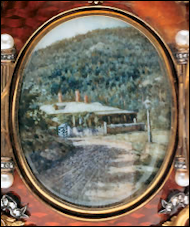
“1” House
(Keefe, Masterworks of Fabergé:
The Matilda Geddings Gray
Foundation Collection, 2008, 82)
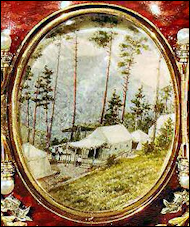
“9” Tents
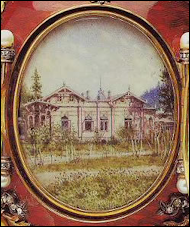
“3” House
(Keefe, Masterpieces of Fabergé:
The Matilda Geddings Gray Foundation Collection, 1993, 130)
Miniature ‘8’ illustrates the ‘spa-like’ nature of the area. In 1886, an electro-therapy facility with two bathrooms was opened with water coming directly from one of the three wells in the village. The Remmert Bridge over the waterfall depicted on one of the miniatures is named after Dr. Adolf Alexandrovich Remmert, born 1835 in St. Petersburg and buried 1902 in Abastuman.
Miniature ‘9’ shows some tents in the woods. They were probably in use in 1891 when Krijitski painted the miniature. The tents puzzled me until I read about the ‘open air treatment’ for tuberculosis, since there was at the time no cure for this illness. Although Robert Koch (1843-1910), German physician and microbiologist, had identified the cause for tuberculosis in 1882, only in the next century did drugs became available for treatment. In the interim it was generally believed fresh air, rest, and sunshine were the major components in treating tuberculosis and a tent was the closest thing to living outside.
Miniature ‘3’ shows the ‘Summer Palace’ in its early state with only one floor. Later the house was modified and a second floor was added. George’s presence in Abastuman made the resort more popular and many nobles visited the Georgian village, including all members of the Tsar’s family, including his mother Marie Feodorovna and Tsar Nicholas II himself.
The Caucasas Egg is supported on a faux-bentwood scrolled gold stand which is not original. In 1938, the egg retained its original white velvet case, marked with its Armoury inventory number.
After the sudden death of Alexander III in 1894, Nicholas II ascended the throne. At the time, he had no male heir, so his younger brother George Alexandrovich became the heir and Tsesarevich. Grand Duke George was outgoing, like his mother Marie Feodorovna, and considered the cleverest of the Imperial children. A naval career was planned, before he contracted tuberculosis in 1890. In the same year, Tsar Alexander III and Marie Feodorovna sent Grand Duke George on a nine-month Asian tour, as a companion to his brother, the Tsesarevich Nicholas. But signs of ill-health in India forced George to return home. The Empress was told he had a fever, but in fact, he had contracted acute bronchitis. He was sent to Abastuman to recover. In 1895, during a rare trip away to visit his mother’s relatives in Denmark his condition deteriorated.
George died on August 9 (OS), 1899. Despite his doctors’ orders, he had been out alone on his motor-cycle and some hours later, when he failed to return, his worried staff sent out a search party. A peasant woman had discovered him collapsed at the side of the road, blood oozing from his mouth as he struggled to breathe. She supported him in her arms until he died. Marie Feodorovna spent hours interrogating the woman. The Dowager Empress sent a telegram to Queen Victoria saying: “My poor dearest son passed away quite alone. Am heartbroken.”
The Caucasus Egg is listed in the 1917 inventory of confiscated Imperial treasure: “Gold egg, covered with red enamel and diamond decorations in medallions with pearl and diamonds.” The 1922 inventory of confiscated Imperial treasure lists “1 gold egg with 2 (portrait) diamonds and rose-cut diamonds, covered with portraits and landscapes”, which is probably the Caucasus Egg. An expert valuation was made of this egg in 1927. Found by Fabergé, Proler, & Skurlov (Fabergé Imperial Easter Eggs, London, 1997), the valuation noted the enamel was chipped in three places and one rose-diamond setting was empty. The valuation assessed the egg’s worth at 9,906 rubles.
The Egg was stolen while on exhibition at the Paine Art Center and Arboretum in Oshkosh, Wisconsin, in October 1980. It was recovered soon after, following a high-speed police pursuit, during which it was jettisoned with two other Tsar Imperial eggs, the 1890 Danish Palaces Egg and the 1912 Napoleonic Egg. The Caucasus Egg sustained some enamel damage, which has since been expertly repaired.
- March 28 (OS), 1893. Would have been presented to Marie Feodorovna, a gift from Alexander III; cost 5,200 silver rubles. Housed in the Anichkov Palace
- September 16-20 (OS), 1917. One of forty or so eggs sent to the Armoury Palace of the Kremlin in Moscow by the Kerensky Provisional Government for safekeeping
- February-March 1922. Transferred to the Sovnarkom, the Council of People’s Commissars
- June 17, 1927. One of sixteen eggs returned by the Foreign Currency Fund of the Narkomfin (the Finance Ministry) to the Armoury; given inventory no. 17537
- April 30, 1930. One of twelve eggs selected for export sale
- June 21, 1930. Transferred from the Armoury to the Antikvariat (Trade Department)
- 1930. One of ten Imperial eggs sold by the Antikvariat, Moscow, to Hammer Galleries, New York, for 5,000 rubles (ca. $2,500)
- April 1937. Advertised by Hammer Galleries
- November 22, 1937. First public showing in the United States, in New York
- Early 1940s. Advertised by Hammer Galleries for $35,000
- April 1943. Displayed in Hammer Galleries, New York
- 1947. Owned by Hammer Galleries, New York
- 1950s. Possibly owned by Jack & Belle Linsky, stapler fortune, New York
- ca. 1959. Bought by Matilda Geddings Gray, oil heiress, Lake Charles and New Orleans, Louisiana
- June 8, 1971. In Collection of the late Matilda Geddings Gray
- 1972. Matilda Geddings Gray Foundation, New Orleans, Louisiana
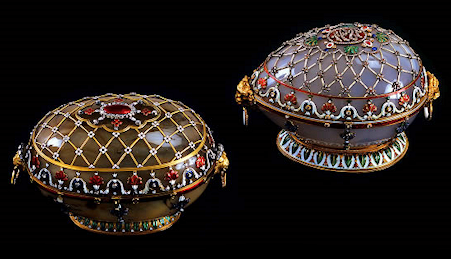
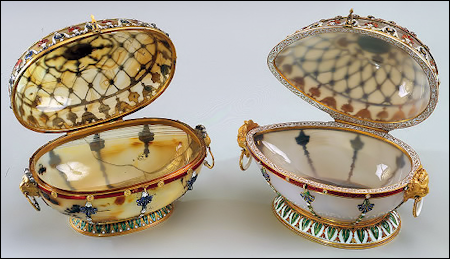
LEFT EGG: 18th Century Casket by LeRoy | RIGHT EGG: Fabergé Renaissance Egg (Fabergé Museum, St. Petersburg, Russia)
(LEFT PICTURE: Photograph © Géza von Habsburg | RIGHT PICTURE: Courtesy Green Vault, Dresden, Germany)
- April 17 (OS), 1894. Would have been presented to Marie Feodorovna, a gift from Alexander III; cost 4,750 silver rubles. Housed in the Anichkov Palace
- September 16-20 (OS), 1917. One of forty or so eggs sent to the Armoury Palace of the Kremlin in Moscow by the Kerensky Provisional Government for safekeeping
- February-March 1922. Probably transferred to the Sovnarkom, the Council of People’s Commissars
- June-July 1927. One of eight eggs returned by the Moscow Jewelers’ Union to the Armoury; given inventory no. 17552
- April 30, 1930. One of twelve eggs selected for export sale
- June 21, 1930. Transferred from the Armoury to the Antikvariat (Trade Department)
- 1930. One of ten Imperial eggs sold by the Antikvariat, Moscow, to Hammer Galleries, New York, for 1,000 rubles (ca. $500)
- May 1937. Advertised by Hammer Galleries
- November 1937-1947. Owned by Henry Talbot de Vere Clifton, millionaire landowner, sportsman, and poet, UK
- November 1949. Owned by Jack & Belle Linsky, stapler fortune, New York
- 1958. Sold by Jack & Belle Linsky to A La Vielle Russie, New York
- March 1959. Advertised by A La Vieille Russie, New York for $50,000
- May 1960. Advertised by A La Vieille Russie, New York
- 1962. Owned by Alexander Schaffer of A La Vieille Russie, New York
- June 1, 1966. Sold by A La Vieille Russie, New York to Forbes Magazine Collection for $78,750
- February 2004. Sold privately as part of the Forbes Magazine Collection, New York, to Viktor Vekselberg, Moscow, for just over $100 million, according to the purchaser
- November 19, 2013. Fabergé Museum, St. Petersburg, Russia
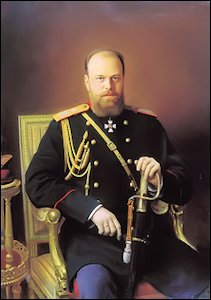
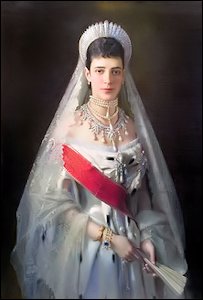
Tsar Alexander III (1845-1894) and His Consort Marie Feodorovna (1847-1928)
(Wiki)
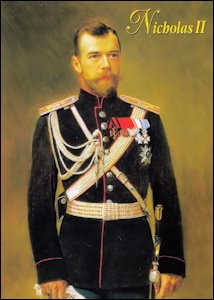
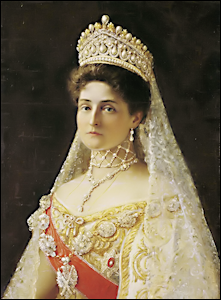
Tsar Nicholas II (1868-1918) and His Consort Alexandra Feodorovna (1872-1918)
(Source: Royal Russia News, Wiki)
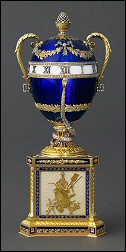
Blue Serpent Clock Egg
(Courtesy Cleveland
Museum of Art)


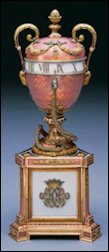
Duchess of
Marlborough Egg
(Courtesy Fabergé
Museum, St.
Petersburg, Russia)
- A. Kenneth Snowman, whose family company Wartski had had a long association with the Blue Serpent Clock Egg put its date at 1887.
- A handwritten list of the Imperial Easter eggs from 1885 to 1890 made by N. Petrov, the assistant manager to the Cabinet of His Imperial Majesty, and found in the Russian State Historical Archives in St. Petersburg, has a clock egg as the Imperial Easter gift for 1887.
- Marina Lopato, quoting the list in an article in Apollo (January 1984), thought these were one and the same. However, Lopato, in a later article in von Habsburg & Lopato, Fabergé: Imperial Jeweller (London, 1993), wrote that the Blue Serpent Clock Egg would have cost closer to 6,000 rubles, not the 2,160 silver rubles listed for the 1887 gift. She also believed the Blue Serpent Clock Egg was too sophisticated for this relatively early date. The gold markings of the latter limited its production to no later than 1898.
- 1992. Wartski exhibition, Fabergé from Private Collections includes the Blue Serpent Clock Egg, out of sight since 1972 was loaned by Prince Rainier III of Monaco.
- But Tatiana Muntian in von Solodkoff, Fabergé: Juwelier des Zarenhofes (Hamburg, 1995) aligned this egg with the descriptions for the 1887 gift. And Fabergé, Proler, & Skurlov in Fabergé Imperial Easter Eggs (London, 1997), confirmed the date as 1887.
- 2001. Lowes and McCanless in Fabergé Eggs: A Retrospective Encyclopedia also found it difficult to accept that the Easter egg series evolved from a simple hen egg to this elaborate gift in just two years.
- 2008. Blue Serpent Clock Egg unveiled through the joint efforts of the Cleveland (Ohio) Museum of Art and the Consulate General of Monaco in New York City. In the article, “The Fabergé Imperial Easter Eggs: New Discoveries Revise Timeline” by Annemiek Wintraecken, the author after a challenge by Dr. Ulla Tillander-Godenhielm reports on her discovery that the invoice of the 1895 Twelve Monogram Egg (now known as the 1896 Alexander III Portraits Egg) also fits the Blue Serpent Clock Egg. It reads: “Blue enamel egg, Louis XVI style, 4500 rubles.”
Highlights from Wintraecken’s research summary include:
- Tillander-Godenhielm confirming the Blue Serpent Clock Egg is in the Louis XVI style and, although the former Twelve Monogram Egg/now Alexander III Portraits Egg has elements of that style, the egg is not in the Louis XVI style.
- Marina Lopato in her 1993 essay, “A Few Remarks Regarding Imperial Easter Eggs”, states: “Neither the indicated price … nor the style corresponds to such an early date (i.e., 1887, now occupied by the Third Imperial Egg)” and “The gold markings of the Blue Serpent Clock Egg limit its production to no later than 1895/1896.”
Wintraecken began thinking about the amount of time Fabergé had to make this egg, in view of the death of Tsar Alexander III on November 1 [NS], 1894, and she concluded the Fabergé workshop probably started right after Easter in April 1894 on Marie Feodorovna’s egg. François Birbaum, Fabergé’s head workmaster, states in his memoirs: “The process of making these eggs usually took about one year. Work started soon after Easter, and they were only just ready for Holy Week of the following year”. She concluded, if one of the two 1895 eggs was to be a relatively simple one, it could not have been the Dowager Empress’ egg; it was the 1895 Rosebud Egg for Tsarina Alexandra Feodorovna for which there was barely half a year to make it. Based on the above, I concluded the Fabergé invoice of the 1895 could be the invoice of the Blue Serpent Clock Egg.”
Fabergé created a very similar egg for Consuelo Vanderbilt, the Duchess of Marlborough, in 1902. The latter egg, known as the Duchess of Marlborough Egg, is larger and has a lustrous pink enamel. Several inspirations and prototypes of the Blue Serpent Clock Egg have been suggested.
- April 2 (OS), 1895. Would have been presented to Marie Feodorovna, a gift from Alexander III; cost 4,500 silver rubles. Housed in the Anichkov Palace
- September 16-20 (OS), 1917. One of forty or so eggs sent to the Armoury Palace of the Kremlin in Moscow by the Kerensky Provisional Government for safekeeping
- February-March 1922. Probably transferred to the Sovnarkom, the Council of People’s Commissars
- ca. 1927. Bought by Michel Norman of the Paris-based Australian Pearl Company, probably from Russian officials of the Antikvariat
- October 2, 1950. Bought by Emanuel Snowman of Wartski, London, from the Australian Pearl Company for £3,750
- 1950-72. In collection of Messrs. Wartski, London
- December 23, 1972. Sold by Wartski to shipping magnate, Stavros Niarchos for £64,103
- May 7, 1974. Presented by Stavros Niarchos as a gift to Prince Rainier III to mark his 25th anniversary as Monaco’s sovereign prince
- 1992. Owned by Prince Rainier III of Monaco
- April 6, 2005. Inherited by Prince Albert II of Monaco
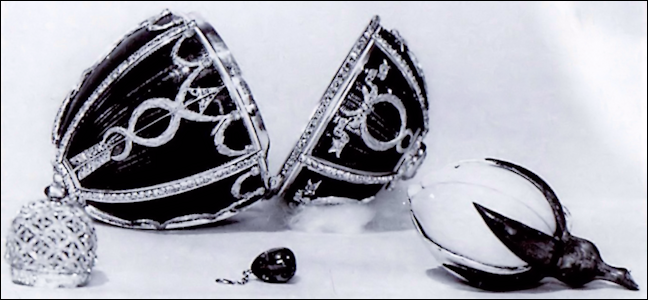
Archival Photograph
(Courtesy Wartski)
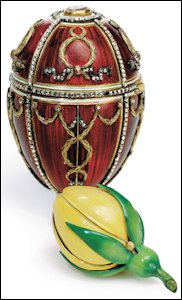
(Courtesy Fabergé Museum,
St. Petersburg, Russia)
The egg, lined with cream velvet, opens to reveal a gold-hinged rosebud of matt green and yellow enamel, which once contained two tiny surprises-a miniature replica of the Imperial crown set with diamonds and rubies, and a ruby pendant hanging within it. Tatiana Muntian (von Solodkoff, Fabergé: Juwelier des Zarenhofes, Hamburg, 1995) found the 1922 inventory of confiscated Imperial treasure included the following description: “gold egg with brilliants and diamond roses, inside a flower, crown out of diamond roses.”
Fabergé, Proler and Skurlov (1997) say the tsarina kept the egg at the Winter Palace, where it was displayed on the second shelf from the top in the corner showcase between the door leading into the bedroom and the window. They also cite the inventory of Imperial family’s private quarters by N. Dementiev, Inspector of Premises of the Imperial Winter Palace, made on April 10 (OS), 1909:
The egg was among Imperial property appropriated in 1917 and is listed in the 1922 inventory of items sent to the Sovnarkom: “1 gold egg with diamonds and rose-cut diamonds, containing a flower and a crown of rose-cut diamonds.” As with the 1885 Tsar Imperial First Hen Egg, the two smaller surprises, the replica of the Imperial crown and the ruby pendant, were separated from the host egg, probably in the late 1930s. These two surprises are known only from archival Fabergé photographs. The entry for this egg in the catalog for the Exhibition of Russian Art, held in Belgrave Square in 1935, says: “Enamel, diamond and gold, with rose-bud containing Imperial crown, which contains a drop ruby” indicating that at least one of the two smaller surprises was still in the egg at that time.
The egg was lost from public view for four decades, during which time rumors abounded it had been destroyed by its owner. In fact, the egg sustained some enamel damage when it was reputedly thrown during a marital dispute. It has since been expertly repaired.
- April 2 (OS), 1895. Would have been presented to Alexandra Feodorovna, a gift from Nicholas II; cost 3,250 silver rubles
- April 10 (OS), 1909. Housed in Alexandra Feodorovna’s study in the Winter Palace
- September 16-20 (OS), 1917. One of forty or so eggs sent to the Armoury Palace of the Kremlin in Moscow by the Kerensky Provisional Government for safekeeping
- February-March 1922. Transferred to the Sovnarkom, the Council of People’s Commissars
- ca. 1925. Transferred to the Antikvariat (Trade Department)
- ca. 1927. One of nine Imperial eggs sold by the Antikvariat, Moscow, to Emanuel Snowman of Wartski
- October 27, 1934. Sold by Wartski, London, to Charles Parsons for £525
- June 1935. Owned by Charles Parsons, London
- ca. 1937. Bought by Henry Talbot de Vere Clifton, millionaire landowner, sportsman, and poet, UK
- 1941-42. Sold in the US by Henry Talbot de Vere Clifton
- 1962. Whereabouts unknown
- August 15, 1985. Fine Art Society, London, negotiated sale to Forbes Magazine Collection, New York for $525,000
- February 2004. Sold privately as part of the Forbes Magazine Collection, New York, to Viktor Vekselberg, Moscow, for just over $100 million, according to the purchaser
- November 19, 2013. Fabergé Museum, St. Petersburg, Russia
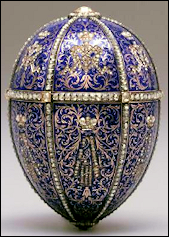
(Courtesy Hillwood Estate,
Museum and Gardens)
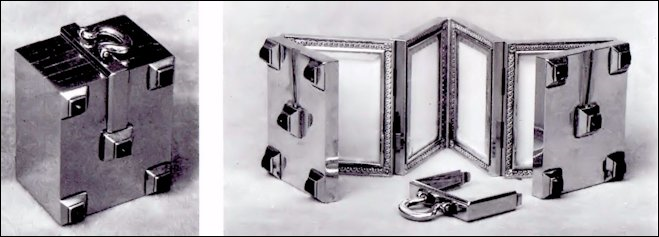
Missing Folding Miniature Frame Surprise Without Alexander III Miniatures by Zehngraf
(Snowman, A. Kenneth, Carl Fabergé, Goldsmith to the Imperial Court of Russia, 1979, 56)
The egg opens to reveal a velvet lining for the missing surprise. Fabergé’s invoice describes the Egg: “Blue enamel egg, 6 portraits of H.I.M. Emperor Alexander III, with 10 sapphires and rose-cut diamonds and mounting. (Fabergé, Proler, & Skurlov, Fabergé Imperial Easter Eggs, London, 1997) Christopher Forbes says the accompanying stand is modern. Another stand was made for the egg for the Russian Enamels: Kievan Rus to Fabergé exhibition in Baltimore, Maryland, November 17, 1996 – February 23, 1997.
This Egg is of relatively simple design, and may have been a deliberate calculation by Fabergé. The now Dowager Empress Marie Feodorovna was genuinely grief-stricken that her tall, immensely strong and determined husband, had died so young – he was 49. An elaborate memorial gift at this time would have only added to the young widow’s intense sorrow. Three more sophisticated memorial eggs to Alexander III would follow in future years.
Tatiana Muntian gives an insight into an incident involving the late arrival of the always much-anticipated Easter gifts: “In 1896, the Emperor – who was angry with the jeweler for he had delivered an Easter present late – in a letter to his mother who was in France, called him ‘foolish Fabergé’.” (Muntian, T.N., Fabergé Easter Gifts, Moscow, 2003) The Dowager Empress was attending her second son, George, in the south of France. Grand Duke George, suffering from tuberculosis, was staying at La Turbie, a picturesque village perched above Monte Carlo. Géza von Habsburg (Fabergé: Treasures of Imperial Russia, New York, 2004) expands on the incident, reporting the following exchange of letters between Nicholas II and Marie: “You will by post be receiving a little parcel – it is from me. That silly man Fabergé came too late to send it by courier.” From La Turbie, Marie replied:
Nicholas calmed down and, pleased with his mother’s response, he wrote back: “It was a great joy to me that you liked the egg – the miniatures of dear Papa are really successfully done and are good likenesses.” (Géza von Habsburg, in Fabergé: Treasures of Imperial Russia, New York, 2004). Two other eggs arrived late. In 1900, the Cockerel Egg was delivered to Marie’s Gatchina Palace outside St. Petersburg, when the Dowager Empress was in fact, in Moscow. And the 1909 egg was late arriving in London when Marie was staying at Buckingham Palace with her sister, Queen Alexandra.
There is no obvious reference to the Alexander III Portraits Egg in either the 1917 or 1922 inventories of confiscated Imperial treasure. Russian research indicates Alexandra Feodorovna actually helped pay for the cost of the egg. This was the only time she did this, and it was done before the two women became fully estranged. How the Egg found its way to the West remains unknown.
Fabergé researchers Anna and Vincent Palmade writing in the Fabergé Research Newsletter, Winter 2014, shared an exciting discovery – “1896 Alexander III Portraits Egg – Missing Surprise Identified in Photographs”. The frames, predictive of the ‘style moderne,’ were bought by Wartski for 420 guineas. Wartski images of the frames, which fold together into a neat ‘case’ with a handle above, are illustrated above. However, the portraits of the late Tsar in uniform had been removed, probably by the family before the item was offered at auction. The frames holding the miniatures are listed in the 1935 Belgrave Square exhibition catalog as being by Fabergé. Johannes Zehngraf, coincidentally, painted the miniatures for the Egg with Revolving Miniatures made in this year for Alexandra Feodorovna. Fabergé enthusiasts are searching for six miniatures (ca. 1.5 in. high x 1 in. wide) by Johannes Zehngraf of the ‘Emperor Alexander III in different uniforms’ which fit the folding frame surprise.
The Hillwood Museum staff tested a replica of the surprise inside the Alexander III Portraits Egg. The replica ‘chain’ of portrait miniatures was made using the dimensions and illustrations of the surprise. They fitted inside the egg so perfectly that they could barely move within their confines. The four top corners of the folded screen matched exactly the four marks on the velvet inside the upper part of the Egg. A news release (April 15, 2014) by the museum announced the re-dating to the egg which is now illustrated on the Hillwood Museum website in never-before-seen photographs.
- After March 24 (OS), 1896. Would have been presented to Marie Feodorovna, a gift from Nicholas II; cost 3,575 silver rubles. Housed in the Anichkov Palace. Probably sold to a Paris-based jeweler by Russian officials owned by Mrs. Andrea Bell Berchielly, Italy
- June 14, 1949. Bought by Marjorie Merriweather Post, General Foods heiress, as Mrs. Joseph E. Davies, from Mrs. Berchielly for the equivalent of $1739.13
- 1958. Owned by Mrs. Post as Mrs. Herbert May
- September 12, 1973. Collection of the late Marjorie Merriweather Post, at Hillwood Estates, Museum, and Gardens Washington (DC)
Twelve miniature paintings, ten signed by Johannes Zehngraf, are framed in chased gold guilloché. They revolve around a fluted gold shaft that passes vertically through the center of the egg when the cabochon emerald at the top is depressed and turned. At this time, a hook is lowered and engages the top of a miniature to revolve on the gold axis. The hook folds them back like the pages of a book, so two of the miniatures can be fully seen. Each miniature represents a place of significance in the tsarina’s life:
Kranichstein Castle in Hesse, Germany, where Alix spent some summer holidays in her youth.
Altes Palais (Editor’s note: Old Grand Ducal Palace) in Darmstadt, was the official residence of Alix’s father, Ludwig IV, Grand Duke of Hesse. It was here that Alix spent much of her childhood after her mother died when Alix was six.
Rosenau in Coburg, Germany. In April 1894, Alix’s brother, Ernest, the Grand Duke of Hesse, married Victoria Melita of Saxe-Coburg in the Palace Church of Coburg. The Tsesarevich Nicholas attended the wedding, and four days later Princess Alix accepted his proposal of marriage. The next day, they drove in a pony-cart to nearby Rosenau.
Alexander Palace at Tsarskoe Selo, twelve miles from St. Petersburg. This relatively modest palace became the couple’s favorite winter residence.
Anichkov Palace in St. Petersburg. After their marriage on November 14 (OS), 1894, the newlyweds lived in a suite of six small rooms, an extension of the new tsar’s bachelor quarters in this palace, a residence of the Dowager Empress Marie.
Winter Palace in St. Petersburg. It was in this vast and inhospitable palace that Nicholas and Alexandra were married. The miniature reflects the dull red color of the palace’s facade as it looked at this time. Originally painted turquoise and white, the facade in the early twenty-first century was sea-green and white.
Wolfsgarten, near Darmstadt, Germany. This villa was used as a hunting lodge and was visited by Alix on occasion during the summers of her youth. It was here that she received instruction before her conversion to Russian Orthodoxy, a necessary requirement for a future tsarina of Russia.
Palace Church in Coburg, Germany. See Rosenau above.
Windsor Castle, near London. Alix was a frequent visitor to the ancient castle at Windsor, the primary residence of her grandmother, Queen Victoria. Alix and Nicholas visited Queen Victoria at Windsor in July 1894.
Balmoral Castle, Scotland. Alix and her family made annual trips in her childhood to Britain. They would visit Queen Victoria at Balmoral during the shooting season. Nicholas and Alexandra visited Balmoral in October 1896.
Osborne House, the Isle of Wight. Nicholas visited Britain in the summer of 1894 and stayed with his fiancée and her grandmother at Osborne House in June of that year. The mansion, built in the 1840s, was a favorite residence of Queen Victoria (Lesley, 1976; Snowman, 1977).
Further details on the various locations see Faberge Research Newsletter, Spring and Summer 2017
The egg retains its original velvet case.
The egg was among those taken from the Imperial palaces in 1917. A note in the 1922 inventory of confiscated Imperial treasure says: “1 crystal egg with 1 emerald, containing gold folding frame.” (Fabergé, Proler, & Skurlov, Fabergé Imperial Easter Eggs, London, 1997) An expert valuation was made of this egg in 1927. Found by Fabergé, Proler, & Skurlov, the valuation noted that inside the egg, a corner of the crystal above one of the miniatures was chipped off. The valuation assessed the egg’s worth at 19,082 rubles. It was the last of the five Imperial Easter eggs bought by Lillian Thomas Pratt of Fredericksburg, Virginia, and is now at the Virginia Museum of Fine Arts, Richmond.
On March 1-2, 2017, the UK auction house, Bulstrodes, of Christchurch, Dorset, offered as lot 650, the family Bible of the Allen family of Cathcart House, Harrogate, in England, “…including handwritten letters from Carl Fabergé, dated October, 1895, asking for images of Cathcart House to be used in the 1896 Imperial egg.”
One letter says in part ‘His Majesty the Emperor has charged me to make a rich album containing views of all the places where Her Majesty lived in her youth. Would you be kind enough to send me a photo of your house in which the Princess lived in 1894.’
The lot was consigned by a direct descendant of the Allen Family. Further details on the egg can be found here.
- March 24 (OS), 1896. Would have been presented to Alexandra Feodorovna, a gift from Nicholas II; cost 6,750 silver rubles
- April 10 (OS), 1909. Housed in Alexandra Feodorovna’s study at the Winter Palace
- September 16-20 (OS), 1917. One of forty or so eggs sent to the Armoury Palace of the Kremlin in Moscow by the Kerensky Provisional Government for safekeeping
- February-March 1922. Transferred to the Sovnarkom, the Council of People’s Commissars
- June 17, 1927. One of sixteen eggs returned by the Foreign Currency Fund of the Narkomfin (Finance Ministry) to the Armoury; given inventory no. 15746
- April 30, 1930. One of twelve eggs selected for export sale
- June 21, 1930. Transferred from the Armoury to the Antikvariat (Trade Department)
- 1930. One of ten Imperial eggs sold by the Antikvariat, Moscow, to Hammer Galleries, New York, for 8,000 rubles (ca. $4,000)
- November 1939. Advertised by Hammer Galleries for $55,000
- April 1943. Displayed in Hammer Galleries, New York
- ca. 1945. Bought by Lillian Thomas Pratt, wife of General Motors executive, Fredericksburg, Virginia
- July 21, 1947. In Collection of the late Lillian Thomas Pratt, willed to Virginia Museum of Fine Arts, Richmond
CLICK THESE IMAGES FOR LARGER VIEWS
1897 Mauve Egg Surprise (3 1/4 in., 8.3 cm.)
(Forbes, Christopher, and Robyn Tromeur-Brenner,
Fabergé: The Forbes Collection, 1999, 42-45)
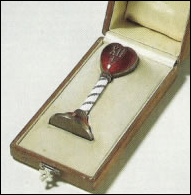
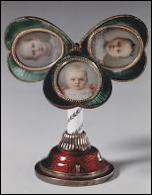
1896 Fabergé Miniature (4 1/2 in., 11.5 cm.) in a 1997
Stockholm Exhibition
(Welander-Berggren, Elsebeth, Carl Fabergé: Goldsmith to the Tsar,
1997, 161, Photographs © Erik Cornelius, Nationalmuseum Stockholm)
The surprise was a heart-shaped frame. There is a strong suggestion that it may be the heart-shaped frame of strawberry enamel on a guilloché field formerly in the Forbes Magazine Collection and now in Viktor Vekselberg’s Link of Times Collection located in the Fabergé Museum, St. Petersburg. It is set with the date 1897 in rose-cut diamonds and opens as a three-leaf clover with each leaf holding a rose diamond-encircled photograph: Nicholas II, Alexandra Feodorovna, and their firstborn, Grand Duchess Olga. The stem is of opaque, white enamel laurel leaves, and the base is of strawberry enamel, with circles of rose-cut diamonds and decorated with pearls. A spring mechanism in the shaft is triggered by pushing the central pearl in the base, which causes the trefoil of miniatures to snap shut, leaving only the heart displayed.
It is difficult to believe that Fabergé would have ignored such a major event as the arrival of the firstborn child of a ruling Tsar, with its implications for the Romanov dynasty and the nation as a whole. The Imperial family was no doubt hoping for a boy, following Tsar Paul’s edict after the death of his mother, Catherine the Great, that no female could in future inherit the throne. While probably personally disappointed the child was a girl, the Imperial family nevertheless rejoiced in her safe arrival on November 3, 1895 (OS). The Tsar recorded in his diary: “At exactly 9 we heard a child’s squeak, and we all breathed freely! A daughter sent by God, in prayer we named her Olga.” Seventeen months later, on March 7 (OS), 1897, the Dowager Empress Marie wrote to her father, King Christian IX: “Nicky’s [daughter] is an exceptionally large baby, unbelievably sturdy and fat and so heavy that one can really hardly carry her.”
Fabergé, Proler, & Skurlov in Fabergé Imperial Easter Eggs (London, 1997) correct the amount paid by the Tsar for this egg from 3,500 silver rubles to 3,250 silver rubles. There is no mention of this egg in either the 1917 or 1922 inventories of confiscated Imperial treasure. This suggests the egg had been removed before 1917, perhaps by Marie Feodorovna herself, or, if displayed in the Gatchina Palace, destroyed by vandals.
There is a possibility this may be the “Easter Egg; miniature of the Empress Alexandra and the Grand Duchess Olga inserted. Lent by H.I.H. the Grand Duchess Xenia of Russia, Windsor (Editor’s note: Xenia was a sister of Tsar Nicholas II).” This brief description appears for item no. 563 in the catalog of the Exhibition of Russian Art at Belgrave Square in London in June 1935. The description does not mention the third miniature, namely, Nicholas II, and the Olga mentioned could be Xenia’s sister Olga Alexandrovna, not her niece. The egg is included under the exhibition heading: “Ornaments by Fabergé.”
Fabergé researcher Annemiek Wintraecken in the article, “1897 Mauve Egg Surprise” in the Fabergé Research Newsletter, Summer 2014, questions the long-held belief that the frame (first two illustrations above) is indeed the surprise for the 1897 Mauve Egg. She “wonders if the strawberry red or scarlet color of the frame really blends with the mauve enamel Egg description, and if the suggested surprise frame is indeed part of the lost egg”, and even more puzzling is, “Would Fabergé have repeated a similar design concept in a smaller version (last two illustrations above) for the Mauve Egg presented to the Empress in 1897?”
- April 13 (OS), 1897. Would have been presented to Marie Feodorovna, a gift from Nicholas II; cost 3,250 silver rubles, possibly sold to a UK buyer
- 2015. Whereabouts unknown
Possible Heart Surprise
- 1962. Lady Lydia Deterding, Paris
- April 26, 1978. Lot 381 sold by Christie’s Geneva to the Forbes Magazine Collection, New York, for SFr 40,000; £11,019
- February 2004. Sold privately as part of the Forbes Magazine Collection, New York, to Viktor Vekselberg, Moscow, for an undisclosed sum
- 2015. Fabergé Museum, St. Petersburg, Russia
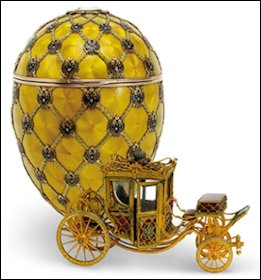
(Courtesy Fabergé Museum, St. Petersburg, Russia)
The surprise concealed inside this elaborate shell is an exact replica of the Imperial coach used to carry Alexandra Feodorovna to her coronation in Moscow on May 26 (OS),1896. In yellow gold and translucent strawberry-colored enamel, the coach, one of the most splendid achievements of the goldsmith’s art, is surmounted by the Imperial crown in rose-cut diamonds and six double-headed eagles on the roof; it is fitted with engraved rock crystal windows and platinum tires and is decorated with a diamond-set trellis in gold and an Imperial eagle in diamonds on either door. It is perfectly articulated in all its parts, even to the two steps that may be let down when the doors are opened, and the whole chassis is correctly slung. The interior is enameled with pale blue curtains behind the upholstered seats and footstool, and has a daintily painted ceiling with a turquoise-blue sconce and hook set in the center. The hook may have once held a tiny egg-shaped, briolette-cut emerald pendant, which is now missing. The meticulous chasing of this astonishing piece was carried out with the naked eye without even the aid of a loupe. The yellow and black shell of the egg is a reference to the sumptuous Cloth of Gold robe worn by the tsarina at her coronation. The date is inscribed beneath a smaller portrait diamond at the bottom of the egg (Snowman, 1977).
A 1909 inventory of items in the Imperial family’s apartments at the Winter Palace adds that the egg was supported on a silver gilt stand. The inventory says the pendant was a briolette-cut yellow diamond. It also says the coach was housed separately “on a rectangular jadeite pediment with a silver-gilt rim and is contained in a glass case with silver-gilt edging. Silver-gilt Imperial crowns are placed at each of the four corners of the case. (Fabergé, Proler, & Skurlov, Fabergé Imperial Easter Eggs, London, 1997) This case is visible in photographs taken of the Fabergé Tsar Imperial eggs display at the von Dervis Mansion charity exhibition in St. Petersburg in 1902. Fabergé’s invoice does not mention the tiny diamond pendant, but it does list an “emerald pendant egg with diamonds” costing 1,000 rubles. This may have been a separate gift. The invoice also lists the “beveled glass case with jadeite stand,” which was obviously meant to show off the coronation coach. The cost, 150 rubles, should be included in the total cost of this Imperial Easter gift.
The miniature coach exactly replicates the original, built in St. Petersburg by Johann K. Buckendahl in 1793, which carried the new tsarina to her coronation. The coach is extant today, having undergone no fewer than five restorations, the latest in 1992-3. Indeed, images of the Fabergé miniature coach were used as a reference point in the most recent restoration. A. Kenneth Snowman (Fabergé: 1846-1920, London, 1977) provides an intimate profile of one of the men who worked on this Easter gift:
Stein told Snowman the cost of the miniature coach alone would have been 2250 rubles – half the amount Fabergé charged the Tsar. In conversation with Snowman, Stein also said that he used the money he received for making the miniature coach to buy a far less grand form of transport-a bicycle!
The 1922 inventory of confiscated Imperial treasure indicates that a “pear-shaped diamond” was still with the Coronation Egg at that time.
- April 13 (OS), 1897. Would have been presented to Alexandra Feodorovna, a gift from Nicholas II; cost 5,650 silver rubles (included the cost for a display case billed at 150 silver rubles)
- April 10 (OS), 1909. Housed in Alexandra Feodorovna’s study at the Winter Palace
- September 16-20 (OS), 1917. One of forty or so eggs sent to the Armoury Palace of the Kremlin in Moscow by the Kerensky Provisional Government for safekeeping
- February-March 1922. Transferred to the Sovnarkom, the Council of People’s Commissars
- ca. 1925. Transferred to the Antikvariat
- ca. 1927. One of nine Imperial eggs sold by the Antikvariat, Moscow, to Emanuel Snowman of Wartski
- 1934. Transferred from Wartski, Llandudno, Wales, to Wartski, London, having been purchased for £600.
- May 19, 1934. Bought by Charles Parsons, London for £1,500
- Before June 8, 1935. Sold back to Wartski, London, by Charles Parsons
- June 8, 1935. Sold to Arthur E. Bradshaw, London, for £1,900
- 1939. Sold back to Wartski after Bradshaw’s death
- March 29, 1979. Sold by Wartski to Forbes Magazine Collection, New York for £532,000
- February 2004. Sold privately as part of the Forbes Magazine Collection, New York, to Viktor Vekselberg, Moscow, for just over $100 million, according to the purchaser
- November 19, 2013. Fabergé Museum, St. Petersburg, Russia
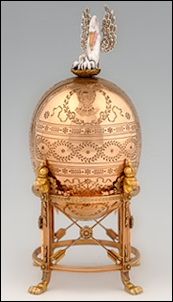
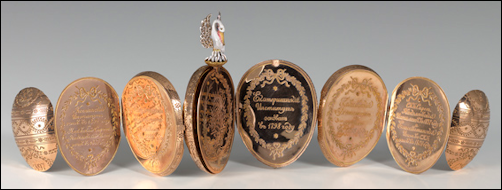
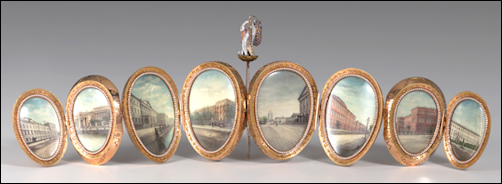
Virginia Museum of Fine Arts, Richmond. Bequest of Lillian Thomas Pratt.
(Photo by Katherine Wetzel © Virginia Museum of Fine Arts)
Painted by court miniaturist Johannes Zehngraf (1857-1908) on ovals of ivory, each scene is carefully graded in size to match the diminishing size of the panels. In the center between the fourth and fifth panels, a gold oval pond acts as an easel and supports the pelican. It is decorated with engraved symbols of science and the arts. On the back of the second to seventh panels are listed the institutions portrayed, the second and seventh panels listing two, the remainder, one each. The enameled pelican is not an integral part of the egg but has been attached to its support as an afterthought, to reinforce the engraved symbolism and the text. When closed, the panels fit so well together that the surprise miniatures are effectively concealed. The egg is supported on a varicolored gold, four-legged stand, decorated with crowned heads of eagles, crossed arrows, and other classical ornaments (Snowman, 1962; Lesley, 1976). There was much confusion over these buildings, finally settled by the painstaking research of Fabergé sleuth, Annemiek Wintraecken.
The first pictorial miniature is of the Elisabeth Institute, founded in St. Petersburg in 1808, and is engraved in Cyrillic: Elisabeth Inst. in SPB (St. Petersburg) founded in the year 1808. The engraving is on the back of the second miniature since the first miniature itself is not engraved, because the first and last gold ovals form the front and back of the closed Egg. The St. Petersburg Elisabeth Institute was initially founded by the wife of a Colonel Gavrilov as the ‘House of Diligence’ for girls – orphaned daughters of junior officers. It was handed over to the Imperial Philanthropic Society, under the custody of Empress Elisabeth Alexeievna (1779-1826) in December 1808. The Institute was informally named after Elisabeth Alexeievna, and later, after her death in 1826, it was formally named in her honor.
The second pictorial miniature is of the St. Petersburg Nicholas Institute founded in 1837, and is engraved in Cyrillic: St. Petersburg Orphanage Nikolaevski Inst. founded in 1837. Tsar Nicholas I in 1834 had ordered the construction of the St. Petersburg Orphanage (a branch of the Moscow Orphanage) on the Moika river embankment in the former palace of Count K.G. Razumovsky. The building opened in 1837, and in 1856 after the death of Nicholas I (1796-1855), the institute was given the name Nicholas. Today the building is used by the Herzen State Pedagogical University of Russia (РГПУ), one of the largest universities in Russia, which operates 20 faculties and more than 100 departments. Significantly, the university entrance building has, as its historical emblem, the Pelican Feeding its Young. This image has an immediate and personal connection with Marie Feodorovna, wife of Alexander III
The third pictorial image is of the St. Petersburg Catherine Institute founded in 1798 and is engraved in Cyrillic: Catherine Institute founded in 1798. Wintraecken advises a two-story building known as the Italian Palace was built on a piece of land given by Peter the Great to his daughter Anna in 1711. After Anna’s death the building was demolished and a new palace was erected under the supervision of the Italian architect Giacomo Quarenghi, Catherine the Great’s court architect. He had also been responsible for the Smolny Institute. Empress Marie Feodorovna (wife of Paul I) in 1798 founded a school for girls in the new palace, the St. Catherine Institute. The institute was named after St. Catherine the Great Martyr, also known as St. Catherine of Alexandria. In 2010, the building was being used by the Russian National Library.
The fourth pictorial image is of the St. Petersburg Pavlovski Institute is engraved in Cyrillic: Pavlovski Institute founded in 1798. The Pavlovski Institute was built in the year of its founding by decree of Paul I as a military orphanage for children of officers and soldiers who died in battle. The focus was on the education of boys, and a division for girls was only supplementary. When Alexander I came to power, he ordered separate wards. In September 1806, a girls’ division was opened and renamed the Pavlovski Women’s Institute in 1829. The military orphanage at the same time was renamed for the Pavlovski Cadet Corps. In 1829, the College was taken into The Office of Institutions of Empress Marie, receiving a new status and became known as the Pavlovski Institute for ‘nobles’ (the daughters of nobility, staff and senior officers) and ‘soldiers’ (the daughters of the lower ranks and non-commissioned officers). The students lived in separate quarters, ate in different dining rooms, walked separately, and attended church at different times. The building depicted on the miniature was built in the 1840’s. In 1918 the Institute was reorganized into a unified labor school, used as a hospital during the Great Patriotic War (1940-1945), and later returned to a school again. Today it is part of the Herzen State Pedagogical University of Russia.
The fifth pictorial image is engraved in Cyrillic: Smolny Institute founded in 1764. Wintraecken reports the Smolny Institute is the large building on the right of the image. In the background is the church of the Smolny Convent. Empress Elizabeth I (1709-1762), daughter of Peter the Great, ordered her favorite court architect, Bartolomeo Rastrelli, to build a convent where she wished to spend the rest of her days. Russian tradition required that churches and cathedrals be erected on a riverbank, so Rastrelli chose to place the convent in a bend of the Neva River previously allotted for the Smolnoi dvor (the tar-yard for the needs of the Admiralty). The convent’s official name was the Resurrection Novodevichy Convent, but it was known as the Smolny Convent among the citizens, since ‘tar’ is ‘smola’ in Russian. The construction of the Convent began in 1748 and continued for an extended period. Empress Elizabeth did not live to see it completed.
Catherine II in 1764 opened a boarding school for ladies on land of the Smolny Convent. The school became known as the Smolny Boarding School for Young Ladies of Noble Birth, an educational establishment for the elite. After Catherine’s death in 1796, Empress Marie Feodorovna (wife of Paul I) took over the institute and made changes that set the Smolny’s course for the rest of its existence. Throughout the 19th century, the Smolny maintained its reputation as the most elite educational institution for girls and was regarded as synonymous with high cultural standards, manners, and poise. The many references to Smolny in the Russian literature of the 18th and 19th centuries attest to the school’s cultural significance. In October 1917, Vladimir Lenin and the Bolsheviks appropriated the Smolny Institute and made it their headquarters until March 1918. Since then, the Smolny campus has continued to be used for government purposes, eventually becoming home to the St. Petersburg Duma. Several rooms have been preserved as a museum honoring the Institute’s past.
The sixth pictorial image is engraved in Cyrillic: Patriotic Institute founded in 1827. In the 18th century a wooden structure on Vasilevski Island was purchased for the Women’s Patriotic Society. In this building in 1812, a school was established for girls (daughters of officers), whose fathers had been killed during the Napoleonic war. In 1827, the school received the status of institute and in 1828 it was rebuilt with two side wings. In the years 1831-1834, the Russian writer Nikolai Gogol, now considered the father of modern Russian realism, worked there as a teacher of history. After the 1917 Revolution, the buildings of the Patriotic Institute were handed over to the Women’s Polytechnic Institute, later named the Second Polytechnic. The building today houses the Energy College (Power Engineering College) of the State University – Higher School of Economics.
The seventh pictorial image is engraved in Cyrillic: Xenia Institute founded in 1895. It was situated in the Nicholas Palace, the palace of Grand Duke Nicolai Nicolaevich the elder (1831-1891), son of Emperor Nicholas I and brother of Tsar Alexander II. When the Grand Duke died, his wife took the veil and the palace passed into the Treasury. The St. Petersburg Xenia (Kseniinski) Institute for girls from the nobility was established by decree of Tsar Alexander III on July 25, 1894, to commemorate the marriage of his daughter Grand Duchess Xenia Alexandrovna (1875-1960). It was opened in March 25, 1895, in the presence of Tsar Nicholas II. In 1918, the building was transferred to the Petrograd Council of Trade Unions and renamed the Palace of Labor. Currently the building is used by the Council of Trade Unions of St. Petersburg city and the region. It is also used for commercial purposes.
Annemiek Wintraecken says earlier sources believed all the institutions depicted on the Pelican miniatures were located in St. Petersburg, yet the inscription on the back of the eighth and final miniature reads Московский Сирот. Николаевский Инст. основ. вь 1837 году, which translates as Moscow Orphanage Nicolaievski Institute founded in 1837. After an exhaustive internet search Ms. Wintraecken located images of the building which exactly replicated the building on the eighth and final miniature pictorial surprise contained within the Pelican Egg. She reports: …In 1812 Moscow was hit by a great fire and although the Moscow Orphanage was saved thanks to local police, half of the city and almost half of all the schools were destroyed. They were restored and in the 1830’s and 40’s new schools opened. In 1837 the Nicholas Orphanage was opened in the Orphanage building, in the western wing. The Bolsheviks disbanded the Orphanage immediately after the Revolution. The main building was used by Soviet trade unions, followed by a Military Academy and a long succession of state institutions. During Stalin’s reconstruction of old Moscow (1937), several Orphanage buildings were torn down to make way for a new bridge. The right wing of the Orphanage was topped out by June 1941, but the project was not completed until after World War II. Viewed from the outside, this later addition is only marginally different from the left wing, to which the top floor was added at about the same time. The main building now conforms quite closely to the original designs of architect Karl Blank. The buildings of the Orphanage today house the Academy of Missile Forces and the Russian Academy of Medical Sciences. Future plans are to use the complex as the main seat of the Russian Parliament.
The egg retains its original red velvet case, the only time this color was apparently used for a Tsar Imperial Easter egg.
The Russian newspaper Novoie Vremia, reporting that the egg was part of the charity exhibition held at the von Dervis Mansion in March 1902, mentions the pelican was Marie Feodorovna’s personal symbol. The egg is listed in the 1917 inventory of confiscated Imperial treasure. An expert valuation was made of this egg in 1927. Found by Fabergé, Proler, & Skurlov, the valuation noted two rose-cut diamonds were missing, the miniatures and hinge were loose, and the enamel on the pelican was damaged. The valuation assessed the egg’s worth at 4,565 rubles.
- April 5 (OS), 1898. Would have been presented to Marie Feodorovna, a gift from Nicholas II; cost silver 3,600 rubles. Housed in the Anichkov Palace
- September 16-20 (OS), 1917. One of forty or so eggs sent to the Armoury Palace of the Kremlin, Moscow by the Kerensky Provisional Government for safekeeping
- February-March 1922. Transferred to the Sovnarkom, the Council of People’s Commissars
- June 17, 1927. One of sixteen eggs returned by the Foreign Currency Fund of the Narkomfin (Finance Ministry) to the Armoury; given inventory no. 17538
- April 30, 1930. One of twelve eggs selected for export sale
- June 21, 1930. Transferred from the Armoury to the Antikvariat (Trade Department)
- 1930. One of ten Imperial eggs sold by the Antikvariat, Moscow, to Hammer Galleries, New York, for 1,000 rubles (ca. $500)
- March 1936-May 1938. Purchased by Lillian Thomas Pratt, Fredericksburg, Virginia
- July 21, 1947. Collection of the late Lillian Thomas Pratt, willed to Virginia Museum of Fine Arts, Richmond
The surprise consists of three oval miniatures of Nicholas II in military uniform and the Grand Duchesses Olga and Tatiana, his first two children. It rises from the top of the egg by means of a geared mechanism and spreads into a fan when a gold-mounted pearl button at the side is turned. A turn in the opposite direction automatically folds and returns the miniatures back to the interior of the egg. The Julian date, April 5, 1898, is engraved on the reverse of the miniatures which were painted on ivory by Johannes Zehngraf (Snowman, 1977; Brezzo et al., 1989). The egg retains its original fitted velvet case.
This egg and indeed the Lilies of the Valley basket, were shown at the Exposition Internationale Universelle in Paris in 1900, as were the 1891 Memory of Azov Egg, the 1899 Pansy Egg, the 1897 Coronation, the 1900 Trans-Siberian Railway Egg, and possibly the 1890 Danish Palaces Egg.
The French judge René Chanteclair was not overly impressed. He admired the leaves and blooms of the Lilies-of-the-Valley egg … as being “of delicate taste,” but criticized them as “too closely adhering to the egg.” He would have preferred “three feet, instead of four, leaves not terminated in banal scrolls, and that the egg should be set in assymetrical [sic] sprays.” (von Habsburg & Lopato, Fabergé: Imperial Jeweller, London, 1993) This egg is apparently not listed in either the 1917 or 1922 inventories of confiscated Imperial treasure. The Lilies of the Valley Egg is the first known Tsar Imperial egg in which the surprise springs from the top. This idea would gain its fullest expression in the 1900 Cockerel Egg.
- April 5 (OS), 1898. Would have been presented to Alexandra Feodorovna, a gift from Nicholas II; cost 6,700 silver rubles
- April 10 (OS), 1909. Housed in Alexandra Feodorovna’s study at the Winter Palace
- ca. 1927. One of nine Imperial eggs sold by the Antikvariat, Moscow, to Emanuel Snowman of Wartski
- 1934. Transferred from Wartski, Llandudno, Wales to Wartski, London, having been purchased for £700
- May 19, 1934. Bought by Charles Parsons, London, for £2,000
- June 8, 1935 sold back to Wartski by Charles Parsons
- Bought by Mr. Hirst, London
- July 1, 1948. Sold back to Wartski by Mr. Hirst for £1,500
- March 29, 1979. Sold by Wartski for £300,000 to Forbes Magazine Collection, New York
- February 2004. Sold privately as part of the Forbes Magazine Collection, New York, to Viktor Vekselberg, Moscow, for just over $100 million, according to the purchaser
- November 19, 2013. Fabergé Museum St. Petersburg, Russia
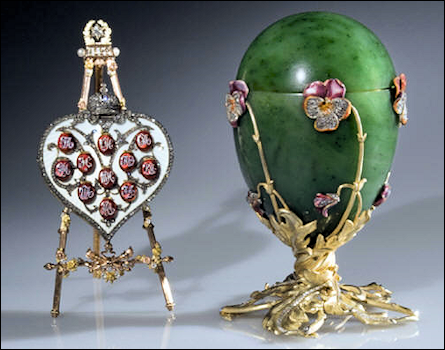
(Courtesy Matilda Geddings Gray Foundation Collection, New Orleans, Louisiana)
Eleven tiny translucent strawberry-enameled gold covers, each bearing its own monogram, are connected by a large diamond M to form a decoration for the front of this plaque. When a tiny knob at the bottom point of the heart is depressed, the enameled covers open simultaneously to reveal eleven miniatures of the immediate Imperial family.
In the second row are: Tsar Nicholas II and Princess Irina Alexandrovna, subsequently Princess Youssoupov, daughter of Grand Duke Alexander Michailovich and Grand Duchess Xenia Alexandrovna.
In the third row are: Grand Duchess Olga Nicolaievna, the first child of the tsar and tsarina, Grand Duchess Tatiana Nicolaievna, their second child, and Grand Duke Michael Alexandrovich, youngest brother of the tsar.
In the fourth row are: The tsarina and Prince Andrew Alexandrovich, brother of Princess Irina.
In the fifth row are: Grand Duchesses Olga Alexandrovna and Xenia Alexandrovna, sisters of the tsar (Snowman, 1977). The heart miniature is backed with mother of pearl. The egg has a wooden carrying case, which is probably not original.
Henri Havard, writing in the Revue de l’Art Ancien et Moderne, Vol. 7, June 10, 1900, also singled out the Pansy Egg among the “divers objets charmants” (Editor’s note: Various charming objects) exhibited by Fabergé at the exposition.
The Pansy Egg is the second known example of Fabergé’s use of the art nouveau style and amply demonstrates his workmasters’ supreme skills in carving, enameling, and chasing. Its surprise is another example of Fabergé’s move toward the inclusion of mechanical devices as part of the Imperial Easter gifts. It is one of the few significant Imperial Eggs to remain in a private collection.
The Pansy Egg is noted in the 1917 inventory of confiscated Imperial treasure: “Jasper egg, with gold mounting, decorated with diamonds; containing a small heart-shaped gold screen under a crown, decorated with diamond monograms in red enamel medallions.” (Fabergé, Proler, & Skurlov, Fabergé Imperial Easter Eggs, London, 1997) An expert valuation was made of this egg in 1927. Found by Fabergé, Proler, & Skurlov, the valuation noted the edges of two of the miniatures were damaged. The lid had been torn off one, and the enamel was chipped on the other. The valuation assessed the egg’s worth at 15,422 rubles. The Pansy Egg is seldom seen publicly.
- April 18 (OS), 1899. Would have been presented to Marie Feodorovna, a gift from Nicholas II; cost 5,600 silver rubles. Housed in the Anichkov Palace
- September 16-20 (OS), 1917. One of forty or so eggs sent to the Armoury Palace of the Kremlin in Moscow by the Kerensky Provisional Government for safekeeping
- February-March 1922. Transferred to the Sovnarkom, the Council of People’s Commissars
- June 17, 1927. One of sixteen eggs returned by the Foreign Currency Fund of the Narkomfin (Finance Ministry) to the Armoury; given inventory no. 17539
- April 30, 1930. One of twelve eggs selected for export sale
- June 21, 1930. Transferred from the Armoury to the Antikvariat (Trade Department)
- 1930. One of ten Imperial eggs sold by the Antikvariat, Moscow, to Hammer Galleries, New York, for 7,500 rubles (ca. $3,750)
- November 1936. Advertised by Hammer Galleries, New York
- April 1943. Displayed in Hammer Galleries, New York
- 1947. First egg bought from Hammer Galleries by Matilda Geddings Gray, oil heiress, of Lake Charles and New Orleans, Louisiana. Given to her niece, Mrs. Matilda Gray Stream of New Orleans, Louisiana, as a first wedding anniversary present
By now, the earlier constraints Fabergé had suffered at the hands of the Imperial bureaucracy had vanished, and his creative endeavors were allowed full reign. The static miniatures, such as Alexandra Feodorovna’s first Imperial Egg, were largely a design technique of the past. Fabergé was looking for more exotic innovations, such as moving forms, be they clocks, or automatons, soon to become another classic feature of the Fabergé oeuvre. One is awed by the skill of the Russian gem-cutters who adroitly crafted delicate semi-open buds and fully open flowers with curvaceous and semi-transparent petals. (Muntian, T.N., Fabergé Easter Gifts, Moscow, 2003) The 1922 inventory of confiscated Imperial treasure includes “One gold clock in the form of a vase with rose-cut diamonds.” (Fabergé, Proler, & Skurlov, Fabergé Imperial Easter Eggs, London, 1997) The description could be of this egg.
- April 18 (OS), 1899. Would have been presented to Alexandra Feodorovna, a gift from Nicholas II; cost 6,750 silver rubles
- April 10 (OS), 1909. Housed in Alexandra Feodorovna’s study at the Winter Palace
- September 16-20 (OS), 1917. One of forty or so eggs sent to the Armoury Palace of the Kremlin in Moscow by the Kerensky Provisional Government for safekeeping
- February-March 1922. Transferred to the Sovnarkom, the Council of People’s Commissars
- Transferred to the Moskovskoye Yuvelirnoye Tovarishchestvo (Moscow Jewelers’ Union, or M.Y.T.)
- July 27, 1927. One of eight eggs returned from the M.Y.T. to the Armoury; given inventory no. 17554
- Retained in the Armoury Museum of the Kremlin, Moscow
When a button at the rear of the egg is depressed, the circular pierced gold grille opens and an automaton singing bird rises, crowing, on a gold platform, while moving its wings and beak. When the crowing finishes, it descends again into the egg, and the grille closes down. On the top of the grille, the date 1900 is inscribed beneath a diamond. (Sotheby’s New York, 1985)
Tatiana Muntian quotes Fabergé’s bill for this egg: “The Easter Egg of violet enamel with the cock and a clock, one flat (table) diamond, 188 roses (rose diamonds) and two rubies, 6,500 roubles.” (von Solodkoff, Fabergé: Juwelier des Zarenhofes, Hamburg, 1995) The bill was submitted late, probably because Fabergé was away at the Exposition Internationale Universelle in Paris. It was paid January 13 (OS), 1901.
Muntian has also found references to this egg in both the 1917 and 1922 inventories of confiscated Imperial treasure. The 1917 description reads: “Clock in the form of an egg with lilac enamel on three feet decorated with pearls and brilliants.” And the 1922 Gokhran list says: Gold egg/clock with three diamonds, roses and pearls. (von Solodkoff, Fabergé: Juwelier des Zarenhofes, Hamburg, 1995)
An archival black and white photograph indicates a drop pearl used to hang from a small suspension ring on the bottom of the open-work apron under the dial. (Fabergé, Proler, & Skurlov, Fabergé Imperial Easter Eggs, London, 1997). They also believe this egg was inspired by the cockerel which is part of the famous Peacock Clock in the Winter Palace, created in the 18th century by Englishman James Cox. Fabergé drew inspiration from the same timepiece to create the 1908 Tsar Imperial Peacock Egg for the Dowager Empress Marie Feodorovna.
There was a mix-up in the delivery of this egg to the Dowager Empress. A letter from Nicholas II to his mother, dated April 5 (OS), 1901, and cited by Géza von Habsburg in Fabergé: Treasures of Imperial Russia (New York, 2004), indicates Fabergé sent the egg to Marie’s Gatchina Palace, when in fact, she was in Moscow. Consequently, the egg did not arrive on time. Nicholas II’s letter says, in part – “Forgive me, dear Mama, for not sending you anything for Easter, but Fabergé did not send the present here, as he thought that you would be returning to Gatchina …”
- After April 9 (OS), 1900. Would have been presented to Marie Feodorovna, a gift from Nicholas II; cost 6,500 rubles. Housed in the Anichkov Palace
- September 16-20 (OS), 1917. One of forty or so eggs sent to the Armoury Palace of the Kremlin in Moscow by the Kerensky Provisional Government for safekeeping
- February-March 1922. Transferred to the Sovnarkom, the Council of People’s Commissars
- ca. 1925. Transferred to the Antikvariat (Trade Department)
- ca. 1927. One of nine Imperial eggs sold by the Antikvariat, Moscow, to Emanuel Snowman of Wartski, Llandudno, Wales
- February 1932. Transferred from Wartski, Llandudno, to Wartksi, London, having been purchased for £150
- January 17, 1934. Sold to Mrs. Isabella S. Low for £350
- November 1949. Owned by Mrs. Isabella S. Low, UK
- January 31, 1953. Sold back to Wartski
- April 24, 1970. Sold by Wartski to Robert H. Smith, a developer of Washington (DC)
- November 20, 1973. Lot 355 sold by Christie’s (Geneva) from the Collection of Robert H. Smith, developer of Washington (DC) to Kenneth Snowman of Wartski, London, bidding for Bernard C. Solomon, president of Everest Records, Los Angeles, for SFr 620,000; $207,000; £82,666, plus 10 percent buyer’s premium
- June 11, 1985. Lot 478 sold by Sotheby’s (New York) as part of a divorce settlement between Bernard and Donna Solomon of Los Angeles, to Forbes Magazine Collection, New York, for $1,760,000; £1,375,000, plus 8 percent sales tax. Presale estimate $1,000,000 or more
- February 2004. Sold privately as part of the Forbes Magazine Collection, New York, to Viktor Vekselberg, Moscow, for just over $100 million, according to the purchaser
- November 19, 2013. Fabergé Museum, St. Petersburg, Russia
The egg is supported by three griffins cast in gold-plated silver, each brandishing a sword and shield. The stepped base is of white onyx in the form of a triangle with concave sides and rounded corners. A gold-plated silver plait is inlaid into the base. A faithful folding miniature replica of the Trans-Siberian Express is contained in the egg, in three sections. It consists of a platinum clockwork locomotive with a ruby lantern and rosette headlights and five gold coaches with windows of rock crystal. The coaches are marked “mail,” “for ladies only,” “smoking,” and “nonsmoking,” with the last coach designated “chapel.” The chapel has miniature bells at the rear, which are unique as an addition to a Tsar Imperial egg. The train is wound with a golden key (Snowman, 1979; Brezzo et al., 1989).
There was some early confusion about the year of presentation of this egg, but records show it was among those chosen to represent Fabergé at the Exposition Internationale Universelle in Paris in 1900, so it must have been presented in that year. This is confirmed by Fabergé’s bill: “Easter Egg in green enamel with the Siberian train, rubies, pearls and rose diamonds … 7,000 roubles. (Fabergé & Skurlov, History of the House of Fabergé, St. Petersburg, 1992) The bill was not presented to the tsar until January 1901. Fabergé, Proler, & Skurlov, in Fabergé Imperial Easter Eggs (London, 1997) believe the delay in the invoice’s presentation was probably because Fabergé was away at the Exposition Internationale Universelle in Paris.
The magazine Capital and Country Estate (Ed. note: Cited elsewhere in various publications as Town and Country) pointed out that this model was virtually a “photostatic copy” of the original Trans-Siberian train. Those who visited … Paris in 1900 had the rare opportunity to compare a real life-size carriage in working condition, specially shipped to France for the occasion, with a miniature copy made by Fabergé’s workmen. (Muntian, T.N., Fabergé Easter Gifts, Moscow, 2003)
It is not known where the pearls listed in the invoice were used on the egg. Perhaps they identified the railway stations along the route. This egg is described in the 1922 inventory of confiscated Imperial treasure. An expert valuation was made of this egg in 1927. Found by Fabergé, Proler, & Skurlov, the valuation noted that the egg was accompanied by a key. It also noted that the enamel was chipped in one place. The valuation assessed the egg’s worth at 18,788 rubles.
- April 9 (OS), 1900. Would have been presented to Alexandra Feodorovna, a gift from Nicholas II; cost 7,000 rubles
- April 10 (OS), 1909. Housed in Alexandra Feodorovna’s study at the Winter Palace
- September 16-20 (OS), 1917. One of forty or so eggs sent to the Armoury Palace of the Kremlin in Moscow by the Kerensky Provisional Government for safekeeping
- February-March 1922. Transferred to the Sovnarkom, the Council of People’s Commissars
- June 17, 1927. One of sixteen eggs transferred from the Foreign Currency Fund of the Narkomfin to the Armoury; given inventory no. 17540
- Retained in the Armoury Museum of the Kremlin, Moscow
When the velvet-lined egg is opened, a detailed model of the Gatchina Palace near St. Petersburg is revealed. The replica is faithful to the last detail. Executed in four colors of gold, the model includes trees, bridges, cannon, turrets (a flag even flies from one), as well as the graveled courtyard and walkways. The Walters Art Museum of Baltimore, Maryland, advises that the miniature palace is fixed inside the egg and cannot be removed from it, unlike the 1908 Tsar Imperial Alexander Palace Egg, which Fabergé would make seven years later for Alexandra Feodorovna.
The egg reflects accurately the interests of the Dowager Empress Marie Feodorovna. An outgoing, witty person, she actively supported the arts, and Gatchina was the palace her husband, Alexander III, preferred as his usual home, thirty miles southwest of St. Petersburg. Despite Gatchina’s grandeur and its 900 rooms, Alexander III kept a strict and Spartan regime of cold showers and simple food, and his family was obliged to follow suit. The dowager empress retained Gatchina as her winter home after Alexander III’s death in November 1894, even though she did not share her husband’s enthusiasm for the palace. Indeed, on March 29 (OS), 1881, she wrote to her mother, Queen Louise of Denmark: “to leave my beloved, cozy home at Anichkov for the large, uninhabited, empty, palace in the middle of winter cost me many tears, but hidden ones, for poor Sacha (Editor’s note: Alexander III) was so happy at the thought of getting away from the city.” (Muntian, Tatiana, et al., 1997) Obviously, Marie Feodorovna’s distaste for Gatchina either faded over the next 20 years or remained a well-kept secret. Fabergé would certainly have not created this egg otherwise.
Along with Alexandra Feodorovna’s 1907 Rose Trellis Egg, the Gatchina Palace Egg was purchased by agents of the wealthy Baltimore, Maryland, railway baron and art collector, Henry Walters, from a former court official at the Gatchina Palace, Alexander Polovtsov. He had fled Russia in 1921 and set up an antique shop in Paris. Polovtsov also wrote a book, Les Trésors d’Art en Russie sous le Régime Bolcheviste (Editor’s note: Art Treasures of Russia under the Bolshevik Regime, Société Française d’Imprimerie et de Libraire, Paris, 1919). The book does not explain how Polovtsov acquired the two Tsar Imperial Easter eggs. However, the anonymous author of The Russian Diary of an Englishman, Petrograd 1915-1917 (London, 1919) has a mid-1917 entry which says that “Alexander Polovtsov is making an inventory of everything in the palace of Gatchina. … Polovstov is working for the (Kerensky) Government, who are cataloguing the contents of all the Imperial Palaces.” The author, reputedly an official of the British Red Cross (and now known to be Albert Stopford) was on friendly terms with Polovtsov and his wife. This list is almost certainly the one published by Preben Ulstrup in Russian Empresses Mode and Style (Moscow, 2013). Ulstrup says the list was compiled in July 1917. As German troops advanced, precious items were selected for evacuation to safety. Item seven is described thus: “Gold egg covered in enamel with diamonds and pearls, inside [a] relief view [model?] of Gatchina Palace.”
The Walters Art Museum advises that on Henry Walters’s death in 1931, there were 243 crates of unopened art in the basement of the building. The box with the two Tsar Imperial Easter eggs was among them. The eggs were featured in a special vitrine in 1936, but the museum’s earliest display of its Fabergé collection was in 1952.
Fabergé created an egg very similar to the Gatchina Palace Egg just two years later when he made the 1903 Bonbonnière Egg for presentation to Barbara Kelch.
- April 1 (OS), 1901. Would have been presented to Marie Feodorovna, a gift from Nicholas II; cost 5,000 rubles. Housed in the Anichkov Palace
- ca.1920. Acquired by Alexander Polovtsov, a Russian émigré who settled in Paris, probably from Russian officials of the Antikvariat (Trade Department)
- 1930. Sold by Polovtsov, together with the 1907 Rose Trellis Egg, to agents of Henry Walters of Baltimore, Maryland
- 1936. Displayed in the Walters Art Museum, Baltimore, Maryland
- 1952. On permanent exhibition, Walters Art Museum, Baltimore, Maryland
The 1902 photograph of the egg at the von Dervis Mansion shows the entire body of the egg in white enamel. Fabergé, Proler, & Skurlov, in Fabergé Imperial Easter Eggs (London, 1997), continue:
Fabergé’s invoice for the Flower Basket Egg puts the issue of who made it beyond doubt, but it also raises another query: “Easter egg, white enamel. Basket with bouquet of wild flowers, with 4176 rose-cut diamonds and 10 pearls.” (Fabergé, Proler, & Skurlov, Fabergé Imperial Easter Eggs, London, 1997)
Yet there is no sign of the pearls on the basket, and significantly, they were not mentioned by N. Dementiev, the inspector of premises of the Winter Palace, when he made a detailed inventory in 1909 of articles in the Imperial family’s private apartments. Dementiev’s descriptions are by far the most comprehensive of the early Russian lists made of various Tsar Imperial Easter eggs. The egg is included in the 1922 inventory of confiscated Imperial treasure.
- April 1 (OS), 1901. Would have been presented to Alexandra Feodorovna, a gift from Nicholas II; cost 6,850 rubles
- April 10 (OS), 1909. Housed in Alexandra Feodorovna’s study at the Winter Palace
- September 16-20 (OS), 1917. One of forty or so eggs sent to the Armoury Palace of the Kremlin in Moscow by the Kerensky Provisional Government for safekeeping
- February-March 1922. Transferred to the Sovnarkom, the Council of People’s Commissars
- Transferred to the Moskovskoye Yuvelirnoye Tovarishchestvo (Moscow Jewelers’ Union, or M.Y.T.)
- July 27, 1927. One of eight eggs returned from the M.Y.T. to the Armoury; given inventory no. 17555
- Transferred to the Antikvariat (Trade Department)
- 1933. Sold by the Antikvariat to an unrecorded buyer, possibly Emanuel Snowman of Wartski or Michel Norman of the Australian Pearl Company, for 2,000 rubles (ca. $1000) after an earlier Armoury valuation of 15,000 rubles
- 1933. Acquired by Queen Mary, UK, probably as a gift
- 1953. Inherited by Queen Elizabeth II

The second is Fabergé’s bill to the Imperial Cabinet, which reads: “Egg in ‘Empire’ style, of nephrite with gold, two diamonds and miniature. (von Solodkoff, Fabergé: Juwelier des Zarenhofes, Hamburg, 1995) and a “nephrite egg with rose-cut diamonds” is mentioned in the 1922 inventory of confiscated Imperial treasure.
It is possible this is one of two Fabergé eggs referred to by Alexander Mosyakin in an article, “The Sale: Our Country’s Great Loss,” in the Moscow newspaper Ogonyok, No. 7, February 1989. Mosyakin says two eggs “of jadeite with dozens of brilliants” were sold for $450 each. This description might also fit the Diamond Trellis Egg. It is assumed the two previous descriptions of the Alexander III Medallion Egg omit certain elements because of their brevity. The newspaper description is also suspect because an object with “dozens of brilliants” would most certainly be worth more than $450, even in the 1920s or 1930s. Entry 553 for the Exhibition of Russian Art held in Belgrave Square, London, in June 1935 reads: “The Emperor Alexander III. Miniature by Zehngraf, in nephrite frame. Lent by H.I.H. the grand Duchess Xenia of Russia, Windsor.”
Was this the surprise from the now lost 1902 Alexander III Medallion Egg? The frame is by Fabergé. Johannes Zehngraf specialized in miniature portraits of the royal families of Europe. His work appears in the 1896 Egg with Revolving Miniatures, the 1898 Pelican Egg, and the 1898 Lilies of the Valley Egg.
- April 14 (OS), 1902. Would have been presented to Marie Feodorovna, a gift from Nicholas II; cost 6,000 rubles. Probably housed in the Anichkov Palace
- September 16-20 (OS), 1917. One of forty or so eggs sent to the Armoury Palace of the Kremlin in Moscow by the Kerensky Provisional Government for safekeeping
- February-March 1922. Probably transferred to the Sovnarkom, the Council of People’s Commissars
- 2015. Whereabouts unknown

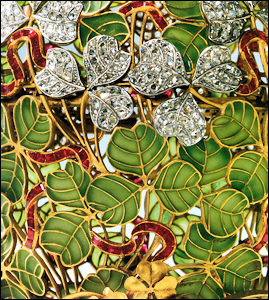
Muntian, T. (Tatiana) N. Fabergé. Easter Gifts, 2003, 36-39.
The 1909 inventory of items in the private apartments of the Imperial family at the Winter Palace, supplies a detailed account of the Clover Leaf Egg, but not the surprise. It can be assumed, therefore, the surprise had already been removed. This egg is included in the 1922 inventory of confiscated Imperial treasure – “Gold egg with green transparent enamel, approx. 1,178 rose-cut diamonds, approx. 232 rubies, 1 large ruby, gold and platinum.” (Fabergé, Proler, & Skurlov, Fabergé Imperial Easter Eggs, London, 1997) The surprise is not described, suggesting it was still apart from the host egg when the inventory was made. Due to the egg’s fragility, it does not travel outside Russia.
- April 14 (OS), 1902. Would have been presented to Alexandra Feodorovna, a gift from Nicholas II; cost 8,750 rubles
- April 10 (OS), 1909. Housed in Alexandra Feodorovna’s study at the Winter Palace
- September 16-20 (OS), 1917. One of forty or so eggs sent to the Armoury Palace of the Kremlin in Moscow by the Kerensky Provisional Government for safekeeping
- February-March 1922. Transferred to the Sovnarkom, the Council of People’s Commissars
- Transferred to the Moskovskoye Yuvelirnoye Tovarishchestvo (Moscow Jewelers’ Union, or M.Y.T.)
- July 27, 1927. One of eight eggs returned by the M.Y.T. to the Armoury; given inventory no. 17556
- 1933. Was to be sold but retained in the Armoury Palace of the Kremlin, Moscow
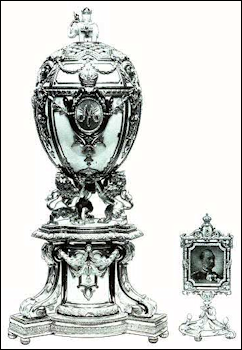
(Courtesy Tatiana Fabergé)
Fabergé, Proler, & Skurlov say the Dowager Empress Marie was in her native Denmark at Easter, 1903. Her son, Tsar Nicholas II wrote to her: “I am sending you a Fabergé Easter present. I hope it will arrive safely. There are no secrets in it-the egg simply opens from the top.” Marie must have brought the Egg back to Russia on her return from Denmark because in July 1917, as German troops advanced towards Gatchina Palace, a list of treasures it contained was compiled before being evacuated to safety. Details of this inventory are given by Preben Ulstrup in Russian Empresses’ Mode and Style (2013). Item three is described as “Egg with blue and white enamel, in a gold mount, on columns of lions, an elephant on the top; in the middle, a portrait of the King and Queen of Denmark, decorated with precious stones.” In charge of these valuables was court official, Alexander Polovtsov. See the entry for the 1901 Gatchina Palace Egg for details about him and his later dealings with Fabergé eggs. Both the 1901 Gatchina Palace Egg and the 1907 Rose Trellis Egg were sold through him in Paris in the early 1920s.
Two quite opposite themes appear to have dominated Fabergé’s thinking when it came to Easter eggs for the dowager empressat the beginning of the twentieth century. The gifts were likely to be either family-related pieces such as this egg, the 1902 Empire Nephrite Egg, the 1909 Alexander III Commemorative Egg, and the 1910 Alexander III Equestrian Egg, or luxurious flights of fantasy, such as the 1906 Swan Egg, the 1908 Peacock Egg, and the 1911 Orange Tree Egg.
- April 6 (OS), 1903. Would have been presented to Marie Feodorovna, a gift from Nicholas II; cost 7,535 rubles.
- For some time, possibly housed at the Anichkov Palace
- 2015. Whereabouts unknown
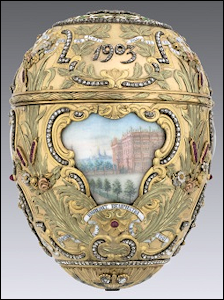
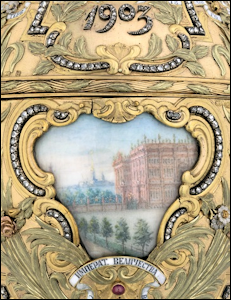
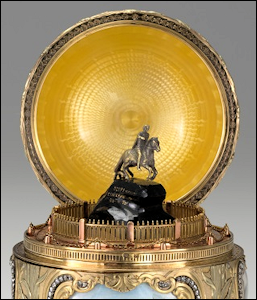
Miniature of the Winter Palace in 1903 (Size: 1 9/16 in. High)
Miniature of Falconet Statue of Peter the Great
(Virginia Museum of Fine Arts, Bequest of Lillian Pratt, Photo: Katherine Wetzel © Virginia Museum of Fine Arts)
The body of the egg is covered with an interwoven medley of laurel leaves (triumph and eternity), roses (victory, pride, and heavenly joy), and bulrushes. These plants symbolize the faithful multitude by the source of the living waters. To the inhabitants of St. Petersburg, the River Neva was a counterpart of the Jordan. Every year, in the first week of January, the waters of the Neva were blessed; hence the bulrushes also denote the source of salvation.
When the egg is opened, a mechanism within it raises a miniature replica in bronze, on a pedestal of sapphire, of Falconet’s monument on the Neva of Peter the Great on horseback. Catherine the Great had commissioned the monument from French sculptor Étienne Falconet in 1766. It depicts Peter charging up a boulder on horseback, his right hand extended in blessing, and his horse trampling the serpent of evil. The tiny, removable bronze model by Georgii Malychev, is surrounded by a carved gold railing, which is itself encircled by chains and posts pinned to an engraved gold pavement within a raised gold bezel in the form of a wall. (Editor’s note: A similar miniature replica in varicolored gold on a pedestal of emerald is in the Hillwood Museum, Washington, D.C.) The inside of the lid of the egg is enameled translucent yellow on a guilloché field of concentric circles, making the surprise even more effective (Snowman, 1962; Lesley, 1976).
The 1909 inventory of items in the private apartments of the Imperial family noted that the egg rested on a stand made of “red silver-gilt wire.” N. Dementiev, the inspector of premises of the Winter Palace, who made this inventory, described the miniature statue as being of “chased gold,” while he regarded the rock as being of “black stone” (Fabergé, Proler, & Skurlov, Fabergé Imperial Easter Eggs, London, 1997). Fabergé’s invoice is of no help in this regard, it only says: “Gold egg with monument to Emperor Peter 1.” (Fabergé, Proler, & Skurlov, Fabergé Imperial Easter Eggs, London, 1997)
Fabergé may have been taking a calculated risk in producing this egg. The ultra-conservative Nicholas II regarded the forward-looking Peter the Great with more than a degree of distaste –
“I recognize my ancestor’s great merits, but … he is the ancestor who appeals to me least of all. He had too much admiration for European culture …” Nicholas II to A.A. Mossolov, head of the Court Chancellory 1900-1916, cited by Mossolov in his memoirs At The Court of the Last Tsar (London, 1935). However, Fabergé could hardly have ignored the importance of St. Petersburg’s 200th anniversary, and Nicholas II is likely to have understood this.
The Peter the Great Egg was probably the penultimate Imperial Easter egg purchased by Lillian Thomas Pratt, and certainly among the most expensive. Alexander Schaffer of A La Vieille Russie, New York, recounted how Mrs. Pratt was so keen to buy the egg that she would not be deterred, even when he told her the asking price was ten times what he had paid for it (Paul Schaffer in von Habsburg & Lopato, Fabergé Imperial Jeweller, London, [1993]). Alexander Schaffer regarded the Peter the Great Egg as the most important piece of Fabergé he ever handled. The egg is readily identifiable in the 1922 inventory of confiscated Imperial treasure. An expert valuation was made of this egg in 1927. Found by Fabergé, Proler, & Skurlov, the valuation noted one rose-cut diamond setting was empty. The valuation assessed the egg’s worth at 16,008 rubles.
- April 6 (OS), 1903. Would have been presented to Alexandra Feodorovna, a gift from Nicholas II; cost 9,760 rubles
- April 10 (OS), 1909. Housed in Alexandra Feodorovna’s study at the Winter Palace
- September 16-20 (OS), 1917. One of forty or so eggs sent to the Armoury Palace of the Kremlin in Moscow by the Kerensky Provisional Government for safekeeping
- February-March 1922. Transferred to the Sovnarkom, the Council of People’s Commissars
- June 17, 1927. One of sixteen eggs returned by the Foreign Currency Fund of the Narkomfin (Finance Ministry) to the Armoury; given inventory no. 17541
- Transferred to the Antikvariat (Trade Department)
- 1933. Sold by the Antikvariat to an unrecorded American buyer for 4,000 rubles (ca. $2,000) after an initial Armoury valuation of 20,000 rubles. Unclaimed at U.S. Customs
- 1930s. Purchased by Alexander Schaffer of A La Vieille Russie, New York, after paying import duty of $1,000-1,500
- November 1936. Shown by Schaffer publicly for first time in the United States
- February 2, 1942-December 1, 1944. Bought by Lillian Thomas Pratt, Fredericksburg, Virginia, in installments, for $16,500
- July 21, 1947. Collection of the late Lillian Thomas Pratt, willed to Virginia Museum of Fine Arts, Richmond
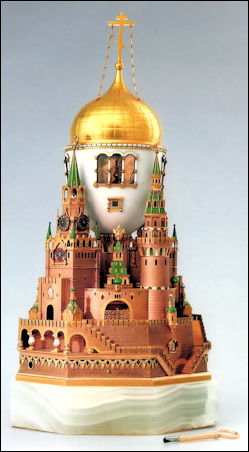
(Muntian, Fabergé Easter Gifts, 2003, 40)
Marks: Fabergé, dated 1904 (further details below)
Materials: Onyx, quatre-couleur gold, silver, opalescent white and translucent guilloché green enamel, glass, oil painting
Dimensions: Height of egg – 361 mm. (14 3/8 in.) | Base of egg – 185 mm. x 185 mm. (7 1/4 in. x 7 1/4 in.)
Description: This, the most ambitious and tallest of the known Imperial Easter eggs, represents the Uspenski (Dormition) Cathedral where the tsars of Russia were crowned. Based on a cup attributed to the Nüremberg copper and silversmith Sebastian Lindenast, the elder (ca. 1460-1526), the walls, towers, and staircases are clustered around the central, opalescent white enamel egg, the top of which takes the form of a graceful yellow gold cupola. The turrets of the Kremlin are fashioned in red gold and the roofs are enameled translucent light green. There are musical chimes in two of the towers, the decorative clock dials measuring about half an inch (12 mm.) in diameter. The Spasskaia Tower, which is duplicated, bears the coat of arms of the Russian Empire and of Moscow. Through the glass windows of the egg can be seen a minutely accurate representation of the interior of the cathedral, with its rich carpets, decorations, and High Altar, shown on an oval glass plate.
Two Cherubim chants, traditional triumphal Easter hymns, are played when a mechanism is wound up by a gold key two and a half inches (63 mm.) long. Tiny enameled icons of Our Lady of Kazan and Christ Pantocrator decorate the walls of the cathedral. The egg, which rests on an octagonal white onyx base, is consciously designed as a pyramid and is built up of other smaller pyramids. Engraved at the foot of the model in white enamel on a round gold plate is the date, 1904 (Snowman, 1979; Fabergé, Proler, & Skurlov, 1997). Fabergé’s bill for the egg says:
The bill is signed by A. (Editor’s note: Alexander) Fabergé for C. Fabergé and dated St. Petersburg, June 7 (OS), 1906. The egg can be removed from the towers, which hold it in place.
Background Notes: This somewhat startling egg marked the Imperial couple’s return to Moscow in 1903. They had tended to avoid the capital following a disastrous incident during the celebrations to mark their coronation. Hundreds of Muscovites died, crushed to death, when a crowd ran amok in Khodynka Meadow. Many Russians took the tragedy as a bad omen for the reign of the new tsar. Indeed, Nicholas II’s first cousin, Marie Pavlovna, Grand Duchess of Russia, recalled:
Tatiana Muntian in von Solodkoff, Fabergé: Juwelier des Zarenhofes (Hamburg, 1995) redates this egg to 1906, even though the egg itself has 1904 on its base. Writing in the World of Fabergé (Moscow, 1996) catalog, Muntian says the egg was to have been presented in 1904, but there was a delay, probably because of the Russo-Japanese War. This issue is discussed further in the introduction to the chapter entitled “Encyclopedia of Who’s Who in the House of Fabergé.” (Lowes and McCanless, Fabergé Eggs: A Retrospective Encyclopedia, 2001)
Muntian also observes in Fabergé, Proler, & Skurlov, Fabergé Imperial Easter Eggs (London, 1997), that another disaster was connected with this egg. Nicholas II’s favorite uncle and brother-in-law, Grand Duke Sergei Alexandrovich, was assassinated in the Kremlin by a socialist-revolutionary terrorist early in 1905. This was the first and only time a member of the ruling dynasty was murdered in the ancient citadel of the Moscow tsars. This may have delayed presentation of the egg for a second year. Nicholas II did not receive the Moscow Kremlin Egg to give to Alexandra Feodorovna until 1906, and the bill of sale was not presented until that year.
Despite these sad associations, the Moscow Kremlin Egg held the most prominent position in Alexandra Feodorovna’s display cabinet in the Mauve Sitting Room of the Alexander Palace. This is not surprising; the tsarina was deeply religious and became more so with age. Tsar Nicholas II had remarked in 1903 how much he enjoyed the Cherubim chants of Kastelskii during Easter services in the Uspenski Cathedral. Muntian says in Fabergé, Proler, & Skurlov, Fabergé Imperial Easter Eggs (London, 1997) this is most likely why the music was included in this egg.
An archival Fabergé photograph of this egg would indicate that some of the chain work that decorated the cross at the egg’s apex, is now missing. The cost of 11,800 rubles made it the most expensive Tsar Imperial Easter egg to date. The egg is readily identifiable in the 1922 inventory of confiscated Imperial treasure. An expert valuation was made of this egg in 1927. Found by Fabergé, Proler, & Skurlov, the valuation noted that, “The article is badly damaged, many domes broken, two chains missing from the cross. Cupola dented, one window broken, another missing. One eagle and two flags missing. Various small parts dented. Key broken.”
Despite all this damage, the valuation assessed the egg’s worth at 46,400 rubles-the highest of the sixteen eggs valued in the list.
Amidst the troubles of 1905, Nicholas II and Alexandra Feodorovna moved from the Winter Palace in St. Petersburg to the Alexandra Palace at Tsarskoye Selo, 25 kilometers south-west of the capital, feeling they and their family would be safer there. From this point on, all Alexandra’s Easter eggs would be housed at the Alexander Palace, with the exception of the 1907 Rose Trellis Egg. Alexandra left all her other earlier Easter eggs behind at the Winter Palace.
Provenance:
- April 2 (OS), 1906. Would have been presented to Alexandra Feodorovna, a gift from Nicholas II; cost 11,800 rubles
- 1913-1916. Housed in Alexandra Feodorovna’s Mauve Sitting Room at the Alexander Palace
- September 16-20 (OS), 1917. One of forty or so eggs sent to the Armoury Palace of the Kremlin in Moscow by the Kerensky Provisional Government for safekeeping
- February-March 1922. Transferred to the Sovnarkom, the Council of People’s Commissars
- June 17, 1927. One of sixteen eggs transferred from the Foreign Currency Fund of the Narkomfin to the Armoury; given inventory no. 17542
- Retained in the Armoury Museum of the Kremlin, Moscow
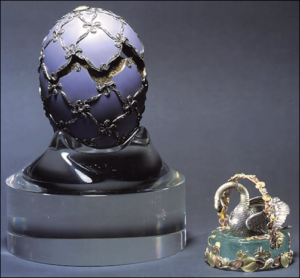
(Lowes and McCanless, Fabergé Eggs: A Retrospective Encyclopedia, 2001, Cover)
Marks: 56, kokoshnik, Y. L., initials of Inspector Yakov Lyapunov of St. Petersburg Standard Board
Materials: Egg – gold, matt opaque mauve enamel, rose-cut diamonds, portrait diamonds | Miniature swan – quatre-couleur gold, silver-plated gold, aquamarine
Dimensions: Height of egg – 100 mm. (3 7/8 in.) | Width of egg – 73 mm. (2 7/8 in.) | Length of swan: 55 mm. (2 3/16 in.)
Description: This gold egg is covered with matt mauve enamel within a twisted ribbon trellis of rose-cut diamonds, with a four-looped bow at each intersection. The top, carefully designed to conceal the division when closed, is surmounted by a large portrait diamond covering the year; another is set in the base where the recipient’s monogram probably once appeared. Lifted from the egg by a handle formed of water lilies in four colors of gold, a miniature lake is revealed composed of a large aquamarine, also richly decorated with water lilies, upon which rests a superbly chased silver-plated gold swan. When wound up under one wing, chased gold feet guide the bird along its course; it wags its tail characteristically. The head is raised and the wings are opened and spread to display each feather separately (Snowman, 1979). In 1954, the egg retained its original cream-colored velvet case.
Background Notes: It had been suggested Alexandra Feodorovna must have received this egg, as mauve was known to be her favorite color. Indeed, she had a veritable passion for the hue, with her famous sitting room decorated almost entirely in the color; it was known as the Mauve Sitting Room. The belief that the egg was presented to Alexandra appears to have stemmed from the catalog of the 1939 Hammer New York exhibition. Much of the information contained in that catalog has since proven to be incorrect, as a casual glance at it will verify.
Fabergé, Proler, & Skurlov, in Fabergé Imperial Easter Eggs (London, 1997), ended the debate when they located Fabergé’s invoice. Not only does it reveal that the Dowager Empress Marie Feodorovna received the Swan Egg but it also indicates that the miniature swan is made of silver-plated gold, not silver or platinum as originally believed:
The miniature swan is modeled after James Cox’s Silver Swan in the Bowes Museum, Barnard Castle, County Durham, England. Fabergé may have seen the Cox Swan when it was displayed at the 1867 Paris Exposition Internationale Universelle. However, given that the Tsesarevich Blue Constellation Egg of 1917 may also be based on an item in the Bowes Museum collection, it is conceivable that Fabergé himself visited the museum at Barnard Castle. If he did, he seems not to have signed the Castle’s visitors’ book.
Fabergé’s miniature swan is another testament to the unsurpassed skills of his workshops. Indeed, Robert C. Williams in Russian Art and American Money (Cambridge, Massachusetts, 1980) says that by 1940, the “mechanical swan on an aquamarine lake” was so highly regarded that it was quoted as being worth $100,000. Both the 1917 and 1922 inventories of confiscated Imperial treasure list the Swan Egg and its surprise.
Provenance:
- April 2 (OS), 1906. Would have been presented to Marie Feodorovna, a gift from Nicholas II; cost 7,200 rubles. Housed in the Anichkov Palace
- September 16-20 (OS), 1917. One of forty or so eggs sent to the Armoury Palace of the Kremlin in Moscow by the Kerensky Provisional Government for safekeeping
- February-March 1922. Transferred to the Sovnarkom, the Council of People’s Commissars
- ca. 1925. Transferred to the Antikvariat (Trade Department)
- ca. 1927. One of nine eggs sold by the Antikvariat, Moscow, to Emanuel Snowman of Wartski, London
- September 25, 1933. Sold to Charles Parsons, London
- November 1933. Displayed at Wartski, London
- October 1934. Displayed in London
- Displayed in Hammer Galleries, New York
- July 1935. Advertised by Hammer Galleries
- 1938. Advertised by Hammer Galleries on behalf of Charles Parsons for $25,000
- December 1939. Sold by Hammer Galleries on behalf of Charles Parsons to King Farouk, Egypt
- March 10, 1954. Lot 166 sold by Sotheby’s (Cairo) at King Farouk Dispersal Sale for £Egyptian 5,800; £6,400 Sterling; $18,500, plus 5 percent premium, total $19,400 to Alexander Schaffer of A La Vieille Russie, New York
- Sold by A La Vieille Russie to Dr. Maurice Sandoz, chemicals magnate, Switzerland
- June 1958. In Collection of the late Dr. Maurice Sandoz, Switzerland
- December 1977. Collection of Edouard and Maurice Sandoz, Switzerland
- December 1995. Fondation Edouard et Maurice Sandoz, Lausanne, Switzerland
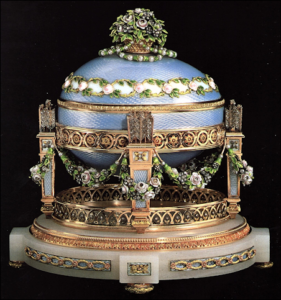
(Fabergé, Proler, and Skurlov, The Fabergé Imperial Easter Eggs, 1997, 175)
Marks: Fabergé, H. W., 56, kokoshnik
Materials: Egg – varicolored gold, translucent pale blue and green enamel, opalescent oyster enamel, diamonds, rubies, pearls, white onyx, silk-lining | Missing easel surprise – white enamel, ruby, pearls, rose-cut diamonds, watercolor (possibly on ivory), probably gold
Dimensions: Height of egg – 146 mm. (5 3/4 in.)
Description: A gold egg in the Louis XVI style, enameled translucent pale blue over a guilloché ground, decorated with an elaborate band composed of painted enamel roses and translucent emerald green enameled leaves and panels of opalescent oyster enamel, and further bands of scrolls and acanthus chased in colored golds. It is surmounted by a pierced basket in colored golds of enameled roses among foliage set with rose-cut diamonds and hung with pearl swags. The interior is lined in silk with a hollow of about 24 mm. x 31 mm. (1 in. x 1 1/4 in.), which originally held the surprise. The egg is supported in a gold cradle by four columns modeled as love trophies in the form of quivers enameled pale blue and containing Cupid’s sets of arrows set with diamonds. Heavy swags of enameled roses and leaves set with rose-cut diamonds and pearls link each column. The whole is supported on a carved oval white onyx base inlaid with pale blue enamel panels, overlaid by chased trails of laurel in green gold with red gold rosettes, and stands on four bun feet in chased colored golds (Snowman, 1979; Sotheby’s [New York], 1992).
Fabergé’s invoice, quoted by Fabergé, Proler, & Skurlov, in Fabergé Imperial Easter Eggs (London, 1997), says:
Background Notes: This egg, seen only infrequently since being brought to the West, was a source of controversy for fifty years. Debate had raged over who received it and when and what the surprise was. The egg’s appearance at the 1989 San Diego Exhibition settled one question; the gold marks proved it was made before hallmarking changes in 1908. So, the egg had been made as an Easter gift to mark the arrival of the long-awaited heir: the Tsesarevich Alexei had been born on July 30 (OS), 1904.
Fabergé scholars were divided over for whom this egg was made. But the evidence provided by Fabergé, Proler, & Skurlov, in Fabergé Imperial Easter Eggs (London, 1997), proves it was made in 1907 and for the Dowager Empress Marie Feodorovna. The question of the surprise is vexing. François Birbaum, in his 1919 recollections, discovered by Valentin Skurlov and reported by Marina Lopato in Apollo, February 1991, wrote the following:
Later research by Lopato published in von Habsburg & Lopato, Fabergé: Imperial Jeweller (London, 1993) led her to surmise that while Birbaum had the description of the egg correct, he confused the surprise with that of the Rose Trellis Egg, given to Alexandra Feodorovna in the same year:
A. Kenneth Snowman, in Carl Fabergé-Goldsmith to the Imperial Court of Russia (London, 1979), believed the surprise was a gold and enamel heart-shaped frame with a strut in the form of the signature “Nikki.” The heart-shaped frame is illustrated as plate 333 in Snowman, Art of Carl Fabergé (London, 1953), but the painting it contained is missing. The official invoice confirms the surprise was a miniature of all the Imperial children.
In 2013, in his book Russian Empresses’ Mode and Style, Preben Ulstrup published a list of valuables evacuated from Gatchina Palace, because of an advance by German troops. Item 2 is described as “Gold Egg with blue enamel, decorated with diamonds and garlands, lying inside a portrait of the children of the Tsar (1907), one a marble [sic], stand.”
How this egg came to the West has yet to be documented. It is not listed in either the 1917 or 1922 inventories of confiscated Imperial treasure. It is possible the Egg came into the possession of Alexander Polotsov, the court official in charge of the evacuation described above. See the Gatchina Palace Egg entry for details. Equally, Hammer Galleries or its associates may have acquired this egg in the late 1930s through Anastas Mikoyan, the Soviet trade minister.
Provenance:
- April 22 (OS), 1907. Would have been presented to Marie Feodorovna, a gift from Nicholas II; cost 9,700 rubles Housed in the Gatchina Palace
- 1917-21. Possibly acquired by Alexander Polovtsov and sold in Paris
- Late 1930s. Possibly acquired by Hammer Galleries or associates
- 1930s-62. Whereabouts unknown
- 1989. Private collection, United States
- June 10, 1992. Lot 291 sold by Sotheby’s (New York) from a private U.S. collection to Robert M. Lee, millionaire sporting goods retailer, author and conservationist, of Reno, Nevada, for $3,190,000. Presale estimate $3,000,000 or more
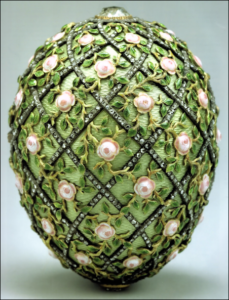
(Tillander-Godenhielm, Fabergén suomalaiset mestarit, 2011, 131)
Marks: H. W., 56, Fabergé
Materials: Egg – gold, translucent pale green enamel, opaque green enamel, opaque light and dark pink enamel, portrait diamonds, rose-cut diamonds, satin lining | Missing chain surprise – diamonds, watercolor on ivory | Missing stand – silver-gilt wire
Dimensions: Height of egg – 77 mm. (3 1/16 in.) | Diameter of egg – 58 mm. (2 5/16 in.)
Description: This gold Easter egg in translucent pale green enamel is latticed with rose-cut diamonds and decorated with opaque light and dark pink enamel roses and translucent emerald green leaves. A portrait diamond is set at either end of this very charming egg, the one at the base covering the date; unfortunately the monogram has disappeared from beneath the other. An oval jeweled locket was originally concealed in the egg, but now only its impression on the satin lining remains (Snowman, 1977). Fabergé’s bill provides the following description:
Further research indicates the surprise was “a diamond chain with medallion and miniature of H.I.H., the Grand Duke Tsesarevich Alexei Nicolaievich; the portrait of the Tsesarevich being painted on ivory.” (von Habsburg & Lopato, Fabergé: Imperial Jeweller, London, 1993)
This description appeared in an album of Tsar Imperial eggs given to the Tsarina Alexandra Feodorovna between 1907 and 1916, which was located by Marina Lopato.
Background Notes: Research in the Russian State Historical Archives in Moscow by Marina Lopato (Apollo, February 1991), has confirmed that Alexandra was the recipient of this egg. Lopato located a photograph album of the Tsarina’s Easter gifts from 1907 onward, and while the pictures have been removed, captions with significant details remain. Again there is a discrepancy between Fabergé’s bill and the egg as it is today. The Rose Trellis Egg has a portrait diamond at either end, yet there is only one portrait diamond listed in the invoice. It would seem there is an error in the bill.
The 1909 inventory of items in the private apartments of the Imperial family in the Winter Palace by N. Dementiev, lists this egg. Dementiev describes two portrait diamonds, but does not mention the surprise. It can be concluded, therefore, that the surprise at this time was kept separate from the host egg. Dementiev says the egg rested on a silver-gilt wire stand.
This is one of the few years – when the Dowager Empress Marie Feodorovna’s egg cost more than the Tsarina Alexandra Feodorovna’s Easter gift. The other years when this is known to have occurred are:
- 1895, when the Blue Serpent Clock Egg (4,500 rubles) cost more than the Rosebud Egg (3,250 rubles)
- 1910, when the Alexander III Equestrian (14,700 rubles) cost more than the Colonnade Egg (11,600 rubles)
- 1913, when the Winter Egg (24,600) cost more than the Romanov Tercentenary Egg (21,300 rubles).
This egg is possibly listed in the 1922 inventory of confiscated Imperial treasure – “1 gold egg with rose-cut diamonds and pearls, containing portrait.” (Fabergé, Proler, & Skurlov, 1997)
With Marie Feodorovna’s 1901 Gatchina Palace Egg, the Rose Trellis Egg was purchased by agents of the wealthy Baltimore, Maryland, railway baron and art collector Henry Walters, from a former court official at the Gatchina Palace, Alexander Polovtsov. He had fled Russia in 1921 and set up an antique shop in Paris. Polovtsov also wrote a book, Les Trésors d’Art en Russie sous le Régime Bolcheviste (Editor’s note: Art Treasures of Russia under the Bolshevik Regime, Société Française d’Imprimerie et de Libraire, Paris, 1919). The book does not explain how Polovtsov acquired the two Tsar Imperial Easter eggs.
However, an entry by the anonymous author of The Russian Diary of an Englishman, Petrograd 1915-1917 (London, 1919) has a mid-1917 entry which says “Alexander Polovtsov is making an inventory of everything in the palace of Gatchina … Polovstov is working for the (Kerensky) Government, who are cataloguing the contents of all the Imperial Palaces.”
The author, reputedly an official of the British Red Cross and now known to be Albert Stopford, was on friendly terms with Polovtsov and his wife.
For some unknown reason, the Rose Trellis Egg was held in Alexandra’s study in the Winter Palace. For reasons of safety, Nicholas II, his wife and their children, had moved to the Alexander Palace at Tsarskoye Selo, 25 kilometers southwest of St. Petersburg, in 1905. All the empress’ Easter eggs before 1905 remained at the Winter Palace. The Walters Art Gallery advises that on Henry Walters’s death in 1931, there were 243 crates of unopened art in the basement of the building. The box with the two Tsar Imperial Easter eggs was among them. The eggs were featured in a special vitrine in 1936, but the gallery’s earliest display of its Fabergé collection was in 1952.
Provenance:
- April 22 (OS), 1907. Would have been presented to Alexandra Feodorovna, a gift from Nicholas II; 8,300 rubles
- April 10 (OS), 1909. Housed in Alexandra Feodorovna’s study at the Winter Palace
- September 16-20 (OS), 1917. Possibly one of forty or so eggs sent to the Armoury Palace of the Kremlin in Moscow by the Kerensky Provisional Government for safekeeping
- February-March 1922. Possibly transferred to the Sovnarkom, the Council of People’s Commissars
- 1920s. Acquired by Alexander Polovtsov, a Russian émigré who settled in Paris, probably from Russian officials of the Antikvariat (Trade Department)
- 1930. Sold by Polovtsov, with the 1901 Gatchina Palace Egg, to agents of Henry Walters of Baltimore, Maryland
- 1936. Displayed in Walters Art Gallery, Baltimore, Maryland
- 1952. On permanent exhibition, Walters Art Gallery, Baltimore, Maryland
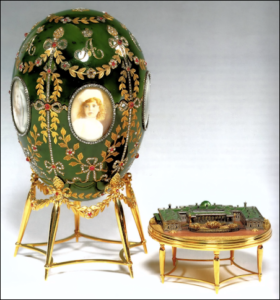
(Muntian, Fabergé Easter Gifts, 2003, 44)
Marks: Fabergé in Cyrillic, H. W., 72, kokoshnik, Y. L., initials of Yakov Lyapunov, inspector of the St. Petersburg Standard Board
Materials: Egg – gold, portrait diamonds, rose-cut diamonds, rubies, nephrite, watercolor on ivory | Miniature palace – tinted gold, silver, varicolored gold, rock crystal, light green enamel, wood, glass
Dimensions: Height of egg – 110 mm. (4 5/16 in.) | Diameter of egg – 68 mm. (2 11/16 in.) | Miniature palace – 30 mm. (1 3/16 in.) x 65 mm. (2 9/16 in.)
Description: This nephrite egg is adorned with five miniature portraits of the children of Tsar Nicholas II and contains a replica of the Alexander Palace at Tsarskoe Selo. The upper and lower sections of the egg are set with triangular diamonds bearing the initials AF (Editor’s note: Alexandra Feodorovna) and the date 1908. Each diamond is surrounded by an inlaid wreath of golden leaves, and flowers composed of rubies and diamonds. The remainder of the egg’s surface is divided by five vertical lines, studded with diamonds and connected with one another by gold garlands inlaid with rose-cut diamond and ruby flowers.
In the space between the vertical lines are five miniature oval portraits of the children of Tsar Nicholas II, executed in watercolor on ivory and framed in diamonds. Above each portrait is a crowned diamond monogram, the first initial of the child represented. Two gold branches tied into a bow rest beneath each child’s portrait. Inside the egg, on the reverse side of each portrait, is engraved the birth date of the person represented, framed by two branches tied into a bow:
- Olga-November 3, 1895
- Tatiana-May 29, 1897
- Maria-June 4, 1899
- Anastasia-June 5, 1901
- Alexei-July 30, 1904 (Editor’s note: These dates are all OS.)
The replica of the Alexander Palace and its adjoining gardens is concealed within the egg. Executed in tinted gold and silver, with rock crystal windows and a light green enamel roof, the model is mounted on a gold table with five high, narrow legs. Vari-colored gold is used for different aspects of the palace gardens. For example, green gold is used for the shrubbery, and granulated red gold for the driveway. The inscription “The Palace at Tsarskoe Selo,” enclosed in a laurel wreath, is engraved on the base (Brezzo et al., 1989).
The stand is modern, having been made in 1989 at the Moscow Experimental Jewelry Factory. The original stand is lost. The velvet base of the egg’s original carrying case is preserved and for many years was used as the stand for it.
Background Notes: Another shrewd choice by Fabergé. This was the Imperial family’s preferred residence at Tsarskoe Selo, and their favorite home, apart from the rather more informal palace Nicholas II would shortly (1909-11) build at Livadia in the Crimea. In relation to other palaces, both in St. Petersburg and in Moscow, the Alexander Palace was quite modest. Fabergé had used the favored-residence theme seven years earlier in the 1901 Gatchina Palace Egg for Marie Feodorovna.
The Alexander Palace had been built by the Italian architect, Giacomo Quarenghi in the late 18th century for Catherine the Great’s favorite grandson, Grand Duke Alexander Pavlovich, who would become Tsar Alexander I.
Pierre Gillard spent more than a decade at the Imperial court, being hired in the spring of 1905 to teach the Imperial children French. He wrote a memoir Thirteen Years at the Russian Court (London, 1921) and his impressions of the Tsar’s four daughters are worth recording. The eldest, Olga Nicolaïevna
Tatiana Nicolaïevna
Marie Nicolaïevna
The youngest daughter, Anastasia Nicolaïevna was, said Gilliard
Fabergé’s bill, paid May 3 (OS), 1908, read in part:
The 1922 inventory of confiscated Imperial treasure lists “1 nephrite egg with gold ornamentation, 2 diamonds and rose-cut diamonds, containing a model of the Tsarskoselskii (Alexander) Palace.” (Fabergé, Proler, & Skurlov, Fabergé Imperial Easter Eggs, London, 1997)
Tatiana Muntian describes the hardstone as “jade” (Editor’s note: Nephrite) and of “a deep, rich green hue … variegated and beautiful in its shading, and free from cracks” (Muntian, T.N. Fabergé Easter Gifts, Moscow, 2003). She adds that Carl Fabergé himself was partial to green, calling it “the color of hope.”
An expert valuation was made of this egg in 1927. Found by Fabergé, Proler, & Skurlov, the valuation noted that three rose-cut diamonds were missing. The egg was valued at 20,712 rubles.
Provenance:
- April 13 (OS), 1908. Would have been presented to Alexandra Feodorovna, a gift from Nicholas II; cost 12,300 rubles
- 1913-1916. Housed in Alexandra Feodorovna’s Mauve Sitting Room in the Alexander Palace
- September 16-20 (OS), 1917. One of forty or so eggs sent to the Armoury Palace of the Kremlin in Moscow by the Kerensky Provisional Government for safekeeping
- February-March 1922. Transferred to the Sovnarkom, the Council of People’s Commissars
- June 17, 1927. One of sixteen eggs returned to the Armoury from the Foreign Currency Fund of the Narkomfin (Finance Ministry); given inventory no. 17543
- Retained in the Armoury Museum of the Kremlin, Moscow
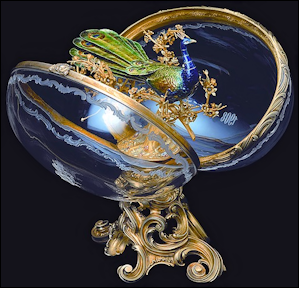
Peacock Egg
(Courtesy Sandoz Foundation Collection)
Marks: Fabergé in Cyrillic, 91, H. W., illegible kokoshnik
Materials: Egg – rock crystal, silver-gilt | Peacock surprise – varicolored gold, varicolored enamel, precious stones
Dimensions: Height of egg – 190 mm. (7 7/16 in.) | Diameter of egg – 165 mm. (6 7/16 in.) | Length of miniature – 110 mm. (4 5/16 in.)
Description: This rock crystal Easter egg in Louis XV taste, engraved with the crowned monogram of Marie Feodorovna and the date, each within a border of scrolls, is supported on a silver-gilt scrolling base. Within the egg, a mechanical gold enameled peacock, one of Fabergé’s most ingenious creations, is perched in the branches of an engraved gold tree with flowers in enamel and precious stones.
When opened at the top by means of a clasp, the egg falls into halves, each with a heavily chased silver-gilt rococo mount. The peacock, when lifted from the branches, wound up, and placed on a flat surface, struts proudly about, moving its head and, at intervals, spreading and closing its varicolored enamel tail. Eugène Fabergé wrote in a letter dated March 19, 1952, “Of the many clever craftsmen I would single out Dorofeev [sic], a self-taught mechanic. It was he who made the mechanical peacock for a rock crystal egg. It took him three years to make it.” (Snowman, Fabergé: 1846-1920, London, 1977)
Background Notes: The concept for this egg is derived from the famous Peacock Clock in ormolu by the English eighteenth-century clock maker James Cox, which is in the State Hermitage Museum in St. Petersburg. The clock had been a present to Catherine the Great from Count Grigorii Aleksandrovich Potemkin (1739-91), the statesman who originally helped Catherine gain the throne. The clock is enclosed in a case the size of a miniature room and was originally housed in the Winter Palace.
While the style is derivative, this magnificent Fabergé egg again highlights the creative imagination of Fabergé’s establishment. The relatively simple egg encloses a treasure of astonishing skill and charm. Dorofeiev probably made a number of models in a base metal, gradually reducing them in size until the correct scale-model was achieved. He also made a smaller version of the same peacock. As with other derivative eggs such as the 1894 Renaissance Egg and the 1911 Orange Tree Egg, Fabergé has improved on the original, giving his version better style, balance, and harmony. The Peacock Egg is seldom seen publicly.
Fabergé, Proler, & Skurlov, in Fabergé Imperial Easter Eggs (London, 1997), report:
Could this be the first peacock made by Dorofeiev? Fabergé’s bill, paid on May 3 (OS), 1908, reads in part:
Provenance:
- April 13 (OS), 1908. Would have been presented to Marie Feodorovna, a gift from Nicholas II; cost 8,300 rubles. Housed in the Anichkov Palace
- September 16-20 (OS), 1917. One of forty or so eggs sent to the Armoury Palace of the Kremlin in Moscow by the Kerensky Provisional Government for safekeeping
- February-March 1922. Transferred to the Sovnarkom, the Council of People’s Commissars
- ca. 1925. Transferred to the Antikvariat (Trade Department)
- ca. 1927. One of nine Imperial eggs sold by the Antikvariat, Moscow, to Emanuel Snowman of Wartski, London
- October 1934. Advertised by Wartski, London
- June 1935. Owned by Mr. Hirst, c/o Wartski, London
- September 12, 1947. Sold by Wartski, London to W. Magalow for £6,000
- November 1949. Owned by Dr. Maurice Sandoz, Switzerland
- June 1958. In Collection of the late Dr. Maurice Sandoz, Switzerland
- December 1977. Collection of Edouard and Maurice Sandoz, Switzerland
- December 1995. Fondation Edouard et Maurice Sandoz, Lausanne, Switzerland
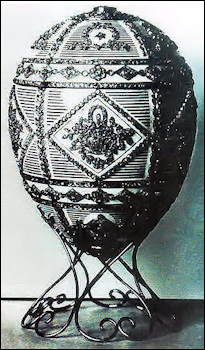
(Courtesy Tatiana Fabergé)
The Alexander III Commemorative Egg – like Marie’s 1896 and 1900 presents – was late reaching the Dowager Empress, who was visiting her sister, Queen Alexandra, in London. On March 26 (OS), 1909, Nicholas wrote to his mother “I am very sorry that I can’t send you an Easter egg today, but unfortunately Fabergé has not managed to have it finished, and I will send it to you in a week’s time. I ask you to forgive this involuntary lack of precision.” (von Habsburg, Fabergé: Treasures of Imperial Russia, New York, 2004). Presumably the egg reached Marie Feodorovna in England, before she set off for a Mediterranean cruise with King Edward VII and Queen Alexandra.
The egg has been out of public view since before the October Revolution of 1917. It does not seem to appear in either the 1917 or 1922 inventories of confiscated Imperial treasure. See the 1903 Royal Danish Egg for comments on what may have happened to it.
- After March 29 (OS), 1909. Would have been presented Marie Feodorovna, a gift from Nicholas II; cost 11,200 rubles. Apparently housed in the Anichkov Palace
- 2015. Whereabouts unknown
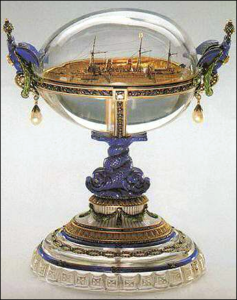
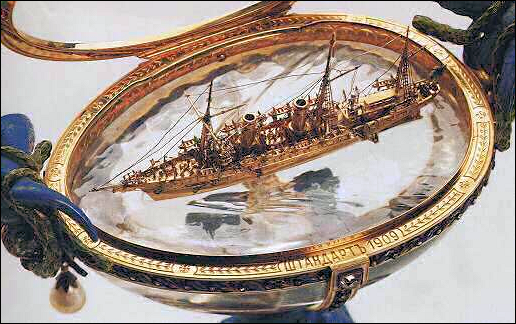
Imperial Standart Egg and the Imperial Yacht Standart
(Muntian, Faberge Easter Eggs, 2003, 51, 54)
Marks: K. Fabergé, H. W., 72, kokoshnik, Y. L., initials of Yakov Lyapunov, inspector of the St. Petersburg Standard Board
Materials: Egg – gold, diamonds, rose-cut diamonds, drop pearls, lapis lazuli, rock crystal, green and opaque white enamel | Miniature ship – gold, platinum, enamel
Dimensions: Height of egg – 153 mm. (6 in.) | Miniature – 20 mm. (13/16 in.) x 75 mm. (2 15/16 in.)
Description: The Renaissance style rock crystal egg is horizontally mounted in gold and bears the inscription Standart 1909 on the edge of the mount. A gold band, with inlaid leaves of green enamel and small diamonds, lines the perimeter of the egg. The top half of the egg has been hollowed out, but the bottom half is solid, the rock crystal having been carved in undulating waves to represent water. The bottom half is decorated with a vertical gold band with inlaid designs. A crowned eagle of lapis lazuli is perched on either side of the egg; a pear-shaped pearl hangs from each of them. The shaft consists of two lapis lazuli dolphins with intertwined tails. The oval base is of rock crystal with a wide band of white enamel inlaid with laurel garlands and bands of small diamonds with laurel branches in green enamel. An exact replica in gold and platinum of the yacht Standart rests inside the egg on a sea of carved rock crystal (Brezzo et al., 1989).
Background Notes: A. Kenneth Snowman in Art of Carl Fabergé (London, 1962), says the Renaissance-style design is derived from the Nüremberg goldsmith Jürg Ruel’s sixteenth-century nautical shell masterpiece formerly in the Grüne Gewölbe (Editor’s note: Green Vault) Museum in Dresden, Germany. A working drawing of the model of the Standart for this egg is extant in a private collection and was reproduced on page 166 of Snowman, Fabergé: Lost and Found (London, 1993).
Fabergé, Proler, & Skurlov, in Fabergé Imperial Easter Eggs (London, 1997), quote a letter from Eugène Fabergé to H. C. Bainbridge, dated Paris, June 5, 1934, in which he says that the miniature ship was executed “by the old (Editor’s note: August) Holmström, who especially put all his art into making the tiny ship as natural as possible so that the guns were movable and all the rigging exactly copied. Even the chains of the anchors were movable.”
However, Holmström died in 1903. Eugène Fabergé is confusing the Standart miniature with that made for the 1891 Tsar Imperial Memory of Azov Egg. The 5,480-ton yacht Standart was commissioned by Alexander III in Copenhagen at a cost of 3,964,300 rubles. It was launched in February 1895, three months after the Tsar’s death. It was 116 meters long, making it the largest yacht in the world at that time. Painted black with gold decorations on the bow and stern, the Standart had 300 crew and servants. It had thirty rooms, with a stable in the hold that had room for a cow. This ensured fresh milk daily for the Imperial children. The Standart took the Imperial family on frequent sorties along the Baltic and Finnish coasts.
Eugène Fabergé put the date of this egg at 1908. It may well have been made to commemorate the part played by the tsarina when, on August 29th (OS), 1907, the yacht struck a reef and appeared to be sinking fast and, as Baroness Sophie Buxhoeveden recalled in her Life and Tragedy of Alexandra Feodorovna, Empress of Russia (London, 1928):
The yacht did not sink, and all aboard were rescued although Tatiana Muntian notes “the royal lifeboat carrying the heir to the throne was fired on and nearly sunk by the coastguards. By a miracle, Tsesarevich Alexei escaped. (Fabergé, Proler, & Skurlov, Fabergé Imperial Easter Eggs [London, 1997]).”
The Standart resumed Imperial duties about eighteen months later. The 1909 invoice describes a “Rock crystal egg on rock crystal pediment, with two lapis lazuli dolphins, decorations of gold and enamel with 2 pearls, 4 diamonds and 1029 rose-cut diamonds, containing a model of the yacht ‘Standard’ [sic] in gold, platinum and enamel.”
Earlier descriptions of the miniature had suggested silver had been used in its construction. The Egg is listed in the 1922 inventory of confiscated Imperial treasure.
An expert valuation was made of this egg in 1927. Found by Fabergé, Proler, & Skurlov, the valuation noted the following damage – “ship clock broken, head of lazurite (Editor’s note: Lapis lazuli) eagle stuck back, crown loose and one small separate part wrapped in paper. Ten missing rose-cut diamonds.”
The egg was valued at 16,836 rubles.
Yuri Osipov, a charming and young Russian artisan who accompanied the egg on its 1996 Australian tour in The World of Fabergé exhibition, told Will Lowes he had had the honor of repairing the damaged lapis lazuli dolphin. He inscribed a copy of the exhibition catalog ‘To the man who knows the best of Fabergé from a man who did the best for Fabergé.’
After the October Revolution of 1917, the Standart was renamed Vosemnadtsat Marta and used for training purposes. In 1932, she was refitted and used to lay mines. After World War Two she was again refitted, renamed The Oka, and once more used for training. The former Imperial yacht was finally scrapped in Estonia in 1963.
Provenance:
- March 29 (OS), 1909. Would have been presented to Alexandra Feodorovna, a gift from Nicholas II; cost 12,400 rubles
- 1913-1916. Housed in Alexandra Feodorovna’s Mauve Sitting Room in the Alexander Palace
- September 16-20 (OS), 1917. One of forty or so eggs sent to the Armoury Palace of the Kremlin in Moscow by the Kerensky Provisional Government for safekeeping
- February-March 1922. Transferred to the Sovnarkom, the Council of People’s Commissars
- June 17, 1927. One of sixteen eggs returned to the Armoury from the Foreign Currency Fund of the Narkomfin (Finance Ministry); given inventory no. 17544
- Retained in the Armoury Museum of the Kremlin in Moscow
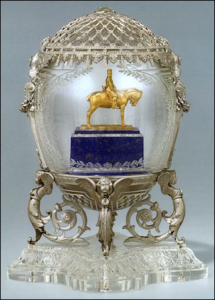
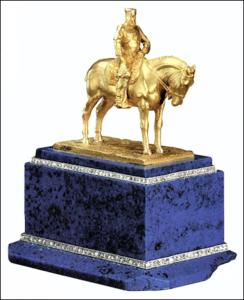
(Muntian, Faberge Easter Eggs, 2003, 56, 59)
Marks: Fabergé
Materials: Egg – platinum, portrait diamond, rose-cut diamonds, rock crystal | Miniature statue – green gold, lapis lazuli, rose-cut diamonds
Dimensions: Height of egg (incl. Base) – 155 mm. (6 1/8 in.) | Miniature – 50 mm. (2 in.) x 75 mm. (2 15/16 in.)
Description: The egg, containing a green gold replica of the monument to Alexander III by Prince Paolo Trubetskoi (1866-1938), rests on a rectangular base of lapis lazuli bordered by two rows of rose diamonds. The Renaissance-style egg is carved out of rock crystal and cloaked with a platinum lacework strewn with rose-cut diamonds.
A large diamond surmounts the egg and is engraved with the year 1910. The diamond is set in a band of small rose diamonds, with a rosette border of platinum acanthus leaves. The two platinum double-headed eagles on the sides of the egg have diamond crowns. The surface of the egg between the eagles is engraved with branching patterns that are joined at the bottom. The lower hemisphere of the egg serves as a platform for the replica of the monument and is supported by cast platinum cherubs coiled into position on a base of crystal, which is shaped like a four-petaled rosette (Brezzo et al., 1989).
Background Notes: This Easter egg was described by A. Kenneth Snowman as “one of the most beautifully designed of all.” It is indeed unfortunate that the workmaster of this simultaneously grave and delicate egg is unknown. It continues the series of memorial eggs made for the Dowager Empress Marie and may be the fourth to pay tribute to her late husband, Tsar Alexander III, the others being the 1896 Alexander III Portraits Egg, the 1902 Empire Nephrite Egg, and the missing 1909 Alexander III Commemorative Egg.
The colossal work by Trubetskoi, on which the miniature is based, had been dogged by controversy as the unusual design “depicted the bulky figure of the Emperor on horseback” (Korneva & Cheboksarova, Empress Maria Feodorovna’s Favorite Residences in Russia and in Denmark (St. Petersburg, 2006). The Dowager Empress Marie Feodorovna visited Trubetskoi’s studio, endorsed his designs, and the Imperial family stood by him and the work. Indeed the dowager empress was said to have kept the model of the statue in her private apartments. This loyalty may have been misplaced. Trubetskoi apparently remarked privately “I just depicted one animal on top of another” (George and George, St. Petersburg: Russia’s Window to the Future: The First Three Centuries (Oxford, 2003). The statue was unveiled on May 23, 1909 (OS) and before the October Revolution of 1917, it stood in St. Petersburg’s Znamenski Square. It has since been relocated to a place of prominence in front of the Marble Palace.
The profuse use of platinum in the Alexander III Equestrian Egg may be misleading; platinum in Russia at that time was not regarded with the esteem reserved for gold. This situation was to change dramatically after the First World War, when the price of Russian platinum soared (Larsons, M. J., An Expert in the Service of the Soviet, London, 1929). (Editor’s note: This author also used the names S. M. Larsons, Maurice Laserson, and Mosei Jäkovlevich Lazerson.)
Fabergé, Proler, & Skurlov cite the invoice for this egg in Fabergé Imperial Easter Eggs (London, 1997):
Platinum may not have been as highly regarded as gold in Russia at this time, but the bill still came to 14,700 rubles. This egg is listed in both the 1917 or 1922 inventories of confiscated Imperial treasure, although the platinum setting is erroneously described as silver. An expert valuation was made of this egg in 1927. Found by Fabergé, Proler, & Skurlov, the valuation noted that one corner of the lapis lazuli pediment had been knocked off. The egg was valued at 28,042 rubles, probably because the valuers realized that platinum and not silver had been used in its construction, and the value of platinum in Russia had, by this time, begun to rise sharply. The egg has no official state mark, probably because platinum had no hallmark in Russia at this time. It is most likely the work of Henrik Wigström.
Provenance:
- April 18 (OS), 1910. Would have been presented Marie Feodorovna, a gift from Nicholas II; cost 14,700 rubles. Housed in the Anichkov Palace
- September 16-20 (OS), 1917. One of forty or so eggs sent to the Armoury Palace of the Kremlin in Moscow by the Kerensky Provisional Government for safekeeping
- February-March 1922. Transferred to the Sovnarkom, the Council of People’s Commissars
- June 17, 1927. One of sixteen eggs returned to the Armoury from the Foreign Currency Fund of the Narkomfin (Finance Ministry); given inventory no. 17545
- Retained in the Armoury Museum of the Kremlin, Moscow
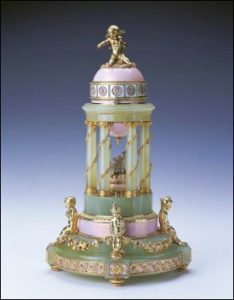
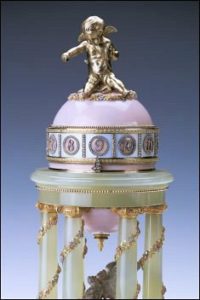
Colonnade Egg by Fabergé
(Royal Collection Trust © Her Majesty Queen Elizabeth II, 2013)
Marks: Fabergé in Cyrillic, H. W., 56, kokoshnik
Materials: Bowenite, quatre-couleur gold, rose-cut diamonds, silver-gilt, platinum, opalescent pale pink and translucent white enamel
Dimensions: Height of egg – 286 mm. (11 1/4 in.)
Description: Conceived as an Arcadian Temple of Love, this rotary clock egg commemorates the birth of the long-awaited heir to the throne in 1904. A silver-gilt cupid, an allegorical representation of the tsesarevich, surmounts the gold egg, which is enameled opalescent pale pink on an engraved ground and is encircled by the broad band of a translucent white enameled dial set with rose-cut diamond numerals; a diamond-set pointer projects from the colonnade in pale green bowenite, which supports the egg. The base of this colonnade consists of six gold-mounted Ionic columns of bowenite. It is set with colored gold chiseled mounts and a broad band of pink enamel.
Four silver-gilt figures, representing the tsar’s four daughters, are seated at intervals around this elaborate base and are linked by floral swags chiseled in quatre-couleur gold. Two cast and chased platinum doves are perched on a white enamel plinth, raised within the circle of columns. The English art historian Sir Sacheverell Sitwell suggested the design for this egg derives from Charles Eisen’s illustrations to the 1770 edition of Les Baisers by Claude-Joseph Dorat (Snowman, Fabergé: 1846-1920, London, 1977).
Background Notes: There had been some confusion over whether or not this egg was a companion piece for the 1907 Love Trophies Egg; both were thought to celebrate the birth of the tsesarevich, with one egg for the tsarina and the other for the dowager empress.
However, Marina Lopato’s research (Apollo, February 1991), demonstrates that the Colonnade Egg was presented in 1910 and given to Tsarina Alexandra. Lopato cites a photograph album of Alexandra’s Easter eggs from 1907 onward, and although the pictures have been removed, the captions, with dates, remain. Photographs taken in 1913 are extant, showing the Colonnade Egg in a cabinet in Alexandra Feodorovna’s favorite Mauve Sitting Room in the Alexander Palace.
A prominent figure in the avant-garde art movement of the late nineteenth century, Alexander Benois, told A. Kenneth Snowman in 1953 that he had prepared drawings at Fabergé’s request “for a clock embellished with cherubs for Alexander III”. There had been some speculation in the literature by Snowman, Carl Fabergé-Goldsmith to the Imperial Court of Russia (London, 1979) and von Habsburg & von Solodkoff, Fabergé: Court Jeweler to the Tsars (New York, 1979) that Benois was referring to the Colonnade Egg and was confused for which tsar it had been made. A more likely alternative is that Alexander Benois helped design the clock made by Fabergé for presentation to Tsar Alexander III and Marie Feodorovna on the occasion of their twenty-fifth wedding anniversary in November 1891. Indeed, Eugène Fabergé, in a letter dated March 19, 1952, says Alexander Benois “produced a drawing for the nephrite clock adorned by amorini, which latter [sic] were modeled by Aubert, a Frenchman.”
This is indeed the 25th Wedding Anniversary Clock (Editor’s note: Sold by Christie’s, New York, on April 18, 1996, for $1,652,000, and now part of the Hermitage Museum Collection).
The Colonnade Egg demonstrates the importance of the tsesarevich to the Romanov dynasty. After the death of his mother, Catherine the Great, Tsar Paul I had decreed that women could no longer inherit the throne. Had Nicholas II and Alexandra failed to have a son, Nicholas’s younger brother Michael would have become tsar. (Editor’s note: In fact he did so for one day after Nicholas II’s abdication. Michael himself yielded the throne on March 3 (OS), 1916.) The silver-gilt cupid representing the tsesarevich sits atop the egg complete with wings (i.e., he will reach great heights). His four sisters, represented by the silver-gilt figures, are in a subservient position, and without wings. This reflects the reality within the Imperial family, where the Tsesarevich Alexei was all but worshipped by his sisters and his mother. Alexei did virtually anything he liked and would answer only to his father. A profile of the young tsesarevich’s personality can be found under the entry for the 1912 Tsesarevich Egg. The allegorical references in this egg were readily understood by the Imperial family. Indeed the photograph album cited above has as part of the caption for this egg, this sentence:
Caroline de Guitaut in Fabergé in the Royal Collection (London, 2003) says the description of the Colonnade Egg in the memoirs of François Birbaum states the Tsesarevich held a silver-gilt ribbon-tied staff or rod in his right hand to indicate the time. This is confirmed by early photographs of the egg and by the description of it in the album of the Tsar Imperial Eggs presented to Alexandra Feodorovna between 1907 and 1916. By the time H.C. Bainbridge’s Peter Carl Fabergé was published in 1949, the staff had been replaced by an enamelled rose. Both the staff and the rose have since disappeared.
The 1922 inventory of confiscated Imperial treasure has the following entry, which is probably the Colonnade Egg – “Desk clock in the form of a summer-house, in gold setting with roses”. Curiously, Fabergé’s original invoice is not dissimilar:
Fabergé’s chief designer, François Birbaum, also describes the egg as a summerhouse in his memoirs.
Provenance:
- April 18 (OS), 1910. Would have been presented to Alexandra Feodorovna, a gift from Nicholas II; cost 11,600 rubles
- 1913-1916. Housed in Alexandra Feodorovna’s Mauve Sitting Room in the Alexander Palace
- September 16-20 (OS), 1917. One of forty or so eggs sent to the Armoury Palace of the Kremlin in Moscow by the Kerensky Provisional Government for safekeeping
- February-March 1922. Transferred to the Sovnarkom, the Council of People’s Commissars
- ca. 1925. Transferred to the Antikvariat (Trade Department)
- ca. 1927. One of nine Imperial eggs sold by the Antikvariat, Moscow, to Emanuel Snowman of Wartski, London
- 1931. Acquired by Queen Mary and given to King George V
- 1953. Inherited by Queen Elizabeth II
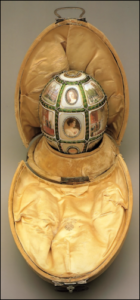
Egg with Original Presentation Case
(Forbes and Tromeur-Brenner, Fabergé: The Forbes Collection, 1999, 59)
Marks: H. W., 72, kokoshnik and Fabergé twice in blue enamel on ribbons under the dates
Materials: Gold, translucent green enamel, opaque white enamel, opalescent oyster enamel, diamonds, rock crystal, watercolor on ivory
Dimensions: Height of egg: 132 mm. (5 1/8 in.) | Height of case – 213 mm. (8 3/8 in.)
Description: The red gold shell of the egg is chased and enameled with a trellis of green laurel set with rose-cut diamond ties at the intersections. It is divided into eighteen panels in three tiers, set with sixteen miniatures, scenes from the life of Nicholas II and portraits of him and his family, painted on ivory by Vasilii Zuiev and framed behind rock crystal. The portraits of the tsar, tsarina, their four daughters and their son are framed in rose-cut diamonds on panels of translucent pale pinkish-blue enamel.
The larger panels intersecting them vertically are, from top to bottom and rotating clockwise after the portrait of the tsar:
Procession to the Uspenski Cathedral
- Opening of the Alexander III Bridge in Paris
- Huis ten Bosch, the Hague
- Reception for the members of the first State Duma at the Winter Palace, St. Petersburg
- Unveiling of the monument commemorating the Bicentenary of the Battle of Poltava
- Unveiling of the statue of Peter the Great at Riga
- Moment of Coronation
- Removal of the remains of the saint, Serafim Sarovski
Below the portraits of the tsar and tsarina are the dates 1894 and 1911, roses and blue ribbons, each signed: Fabergé. The top of the egg has the tsarina’s cipher in black on gold beneath a portrait diamond; the base is set with a rose-cut diamond. The egg sits on a gold stand made before 1916. The tsar is wearing a guard’s uniform and the ribbon of the Order of St. Andrew. The names and dates of the birth of the children appearing on the egg are: Olga, 1895, Tatiana, 1897, Marie, 1899, Anastasia, 1901, and Alexei, 1904. The egg retains its original velvet case, the lining of which is stamped in black with the Imperial Eagle, Fabergé, and “St. Petersburg/Moscow/London” (Waterfield & Forbes, 1978).
Background Notes: This egg chronicles some of Nicholas II’s achievements as tsar, but it also contains elements of the downfall of the Romanov dynasty:
- Nicholas II attended the opening of the Alexander III Bridge over the Seine between the Place Concorde and Les Invalides in Paris. It was a symbol of the strengthening ties between Russia and France, which helped bring Russia into World War I.
- The Huis ten Bosch was the site of the first peace conference, which took place in May 1899. The conference resulted from a note to European governments from Nicholas II in 1898 lamenting the arms race; the participants were to agree on rules of warfare and establish a permanent court of arbitration, which still exists today. But the conference failed to avert the arms build-up in the years before World War I.
- The first State Duma (Editor’s note: Parliament) was elected in May 1906, but their demands for universal suffrage, radical land reform, release of prisoners, and the election of ministers acceptable to the Duma, were intolerable to the tsar, who dismissed them.
- Poltava is the chief city in the rich wheat-growing area of the Ukraine, and it was here that Peter the Great defeated Charles XII of Sweden in 1709. His decisive battle gained him control over the Balkan states.
- Serafim Sarovski (1759-1833) was the last saint canonized in Russia. That event, due largely to the efforts of the deeply religious Alexandra Feodorovna, took place in 1903. It was to him that the tsarina prayed for a son after delivering four daughters. (Editor’s note: Her next child was the hemophilic Tsesarevich Alexei, born in 1904.) Serafim reputedly predicted that his relics (or remains) would disappear and Russia would then be plunged into a dark abyss. The story says he also claimed his remains would be rediscovered and Russia would awaken to a new time of enlightenment. Serafim’s remains disappeared about 1918 and were found in 1990.
Fabergé’s invoice, quoted by Fabergé, Proler, & Skurlov in Fabergé Imperial Easter Eggs (London, 1997), says in part, “Large gold egg, Louis XVI style, opalescent white enamel with green enamel garlands, 929 rose-cut diamonds, 1 diamond, 1 large rose-cut diamond. 16 miniatures by Zuiev.”
The tsarina kept this egg in a corner cabinet of her Mauve Sitting Room at the Alexander Palace at Tsarskoe Selo, along with most of the other eggs made for her after the troubles of 1904-05. There appears to be no clear evidence this egg was among those in the 1917 and 1922 inventories of confiscated Imperial treasure. But the egg is clearly visible in a photograph of a Bolshevik committee formed to value and dispose of Imperial treasures (Fabergé, Proler, & Skurlov, Fabergé Imperial Easter Eggs, London, 1997, 68).
The intriguing journey of the 15th Anniversary Egg from the former Soviet Union to the United States has yet to be fully publicly documented. It may have been a personal gift in the late 1950s from a high-ranking Soviet politician to a longtime American friend of the Soviet Union, or it may have been purchased by Hammer Galleries or its associates in the late 1930s through Anastas Mikoyan, the Soviet trade minister. Later, this egg would be purchased by Malcolm Forbes and would become his favorite among the twelve Tsar Imperial Fabergé eggs he eventually owned. The Forbes Magazine Collection was the first collection to contain two Tsar Imperial eggs given in the same year, namely, the Orange Tree Egg and the 15th Anniversary Egg, given to Marie Feodorovna and Alexandra Feodorovna, respectively, in 1911.
Provenance:
- April 10 (OS), 1911. Would have been presented Alexandra Feodorovna, a gift from Nicholas II; cost 16,600 rubles
- 1911-1916. Housed in Alexandra Feodorovna’s Mauve Sitting Room in the Alexander Palace
- Acquired by A La Vieille Russie, New York
- 1962. Private collection, possibly Alexander Schaffer
- November 1966. Sold by A La Vieille Russie for $111,447 to Forbes Magazine Collection, New York
- February 2004. Sold privately as part of the Forbes Magazine Collection, New York, to Viktor Vekselberg, Moscow, for just over $100 million, according to the purchaser
- November 19, 2013. The Fabergé Museum St. Petersburg, Russia
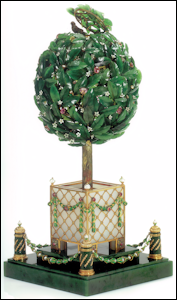
Orange Tree Egg
(Courtesy The Link of Times Collection)
Marks: Fabergé, 1911 on front bottom edge of tub, 2990 & kmmm II scratched on egg
Materials: Egg- gold, translucent green and opaque white enamel, nephrite, diamonds, rubies, pearls, white Mexican onyx | Miniature songbird – feathers
Dimensions: Height of egg – 273 mm. (10 1/2 in.) | Height of egg (open) – 300 mm. (11 3/4 in.) | Height of case – 327 mm. (12 7/8 in.)
Description: The tree has four main branches that rise from the naturalistically chased gold trunk and divide into smaller branches to hold the nephrite leaves, each finely carved with veining and with a socket at the back into which fits the gold twig. The flowers of white enamel have diamond centers; the buds, rose-cut diamonds; and the fruits are pale rubies and champagne diamonds.
The top third of the tree contains the movement for the singing bird, which emerges from the top of the tree when a jeweled fruit is pressed. It then moves its head from side to side, flaps its wings, and opens its beak. The bird returns to a gold filigree recess inside the top of the egg. The leaves fit together to disguise the opening when it is closed. Of the four main branches arising from the trunk, three are soldered, but the fourth is fitted into a specially made groove. This last branch can be removed but to take it out, it is also necessary to remove the leaves, the flowers, and the fruit from this segment. This exposes the bird mechanism housed in a spherical case concealed in the top of the tree. The upper branch rises when the bird is to perform his little concert and falls back over him when he is finished. The tub is of white Mexican onyx overlaid by a gold trelliswork enriched with enameled green swags set with cabochon rubies and pearl finials at the corners. The whole stands upon a nephrite base, the nephrite posts at the corners being applied with spiral bands of gold foliage and connected by free-swinging swags of enameled green husks and pearls (Chapuis & Droz, 1949; Waterfield & Forbes, 1978; Fabergé, Proler & Skurlov, 1997).
The egg has a fitted red morocco case, the exterior of which is stamped in gold with the initials A. G. H. (Editor’s note: Allan G. Hughes, one of the early post-Romanov owners).
Background Notes: This egg is among Fabergé’s most astonishing pieces. It is based on a mechanical tubbed orange tree made by the eighteenth-century jeweler Richard of Paris and sold from the collection of the Earl of Rosebery at the Sotheby Parke-Bernet, Mentmore Towers auction on May 18, 1977. However, the Fabergé piece is by far the superior of the two, being more esthetically pleasing, more neatly balanced, and, not surprisingly, technically superior.
Fabergé, Proler, & Skurlov cite the official invoice in Fabergé Imperial Easter Eggs (London, 1997):
This egg has had immense popular appeal, as witnessed by the fact that it has been owned by more people than any other Fabergé egg, Imperial or otherwise. It has had almost a dozen known owners in its time. Its early description as a bay tree in the Belgrave Square Exhibition catalog of June 4, 1935, was changed to orange tree in the Sotheby’s (London) Auction catalog, Catalogue of Valuable Jewels, Jewellery, Etc….An Imperial Russian Easter Gift by Fabergé, of July 10, 1947. However, Fabergé’s original bill indicates incorrectly that it is a miniature bay tree. (More details, Faberge Research Newsletter, Spring and Summer 2017)
George W. Terrell Jr., professor of history and geography at Gadsden State Community College, Alabama, advises that a similar piece was held at Hvidøre, the seaside estate near Copenhagen in Denmark owned jointly by the Dowager Empress Marie Feodorovna and her sister, Queen Alexandra of England. Marie, a former Danish princess, lived at Hvidøre after she left Russia. This egg is readily identifiable in both the 1917 and 1922 inventories of confiscated Imperial treasure.
Provenance:
- April 10 (OS), 1911. Would have been presented to Marie Feodorovna, a gift from Nicholas II; cost 12,800 rubles. Probably housed at the Anichkov Palace
- September 16-20 (OS), 1917. One of forty or so eggs sent to the Armoury Palace of the Kremlin in Moscow by the Kerensky Provisional Government for safekeeping
- February-March 1922. Transferred to the Sovnarkom, the Council of People’s Commissars
- ca. 1925. Transferred to the Antikvariat (Trade Department)
- ca. 1927. One of nine Imperial eggs sold by the Antikvariat, Moscow, to Emanuel Snowman of Wartski
- May 11, 1928. Released from the State Repository as a prospective gift for the Shah of Persia. Returned the following September
- March 12, 1934. Transferred from Wartski, Llandudno, Wales for Wartski, London, valued at £950
- 1934. Sold by Wartski for £950, probably to Allan G. Hughes
- June 1935. Owned by Allan G. Hughes, London
- November 20, 1935. Sold to collector Arthur E. Bradshaw with eight other Fabergé pieces for a collective total of £2,550
- Owned by W. Magalow
- July 10, 1947. Lot 53 sold by Sotheby’s (London) from the Collection of Lilian, Lady Cadman, widow of British Petroleum executive Sir John Cadman, to buyer’s agent Collins for £1,650 (£1,500 plus 10 percent buyer’s premium); $6,600. Collins acted on behalf of Wartski, London
- 1949. Owned by Maurice Sandoz, Switzerland
- June 1958. Collection of the late Maurice Sandoz
- Acquired by A La Vieille Russie, New York from Sandoz heirs
- 1962. Private collection, United States (Editor’s note: Kaplan?)
- Owned by Mildred Kaplan, New York
- July 1965. Sold by Mildred Kaplan for $150,000 to Forbes Magazine Collection, New York
- February 2004. Sold privately as part of the Forbes Magazine Collection, New York, to Viktor Vekselberg, Moscow, for just over $100 million, according to the purchaser
- November 19, 2013. The Fabergé Museum St. Petersburg, Russia
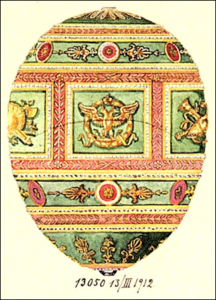
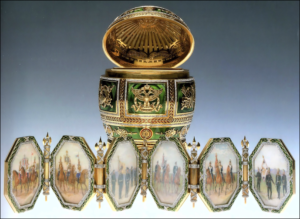
(Tillander-Godenhielm, Fabergén suomalaiset mestarit, 2011, 120-121)
Marks: Fabergé, H. W., 56, kokoshnik
Materials: Egg – yellow gold, translucent emerald green, and ruby red enamel, rose-cut diamonds, velvet, satin | Miniature screen – yellow gold, rose-cut diamonds, platinum, translucent emerald green, and opaque white enamel, gouache on ivory
Dimensions: Height of egg – 117 mm. (4 5/8 in.) | Diameter of egg: 89 mm. (3 1/2 in.)
Description: In the French Empire-style, this green and yellow gold Easter egg is divided by six vertical and four horizontal double fillets of rose-cut diamonds, between which run bands of gold laurel leaves and rosettes on a ground of ruby guilloché enamel. The central design of the egg is formed of six panels bearing alternating applied cast and chased gold appliqués of the Romanov double-headed eagle crest and military trophies. Above and below are secondary designs bearing rosettes of rose-cut diamonds alternating with roundels of strawberry red enamel separated by conventionalized leaf and scroll appliqués.
A golden diamond-set sunburst centered by a portrait diamond displaying the crown and cipher of the Dowager Tsarina Marie Feodorovna surmounts the egg. The lower terminal is similarly set with a smaller portrait diamond displaying the date 1912. The egg opens to reveal a six-panel octagonal folding screen bearing portraits by the court miniaturist Vasilii Zuiev, signed and dated 1912, showing members of the tsarina’s regiments, details of which are inscribed on the back of each panel. The panels are framed by diamond-bound laurel leaves and have hinges of ax-shaped fasces (Editor’s note: Roman symbols of authority) bound with diamonds. The reverse of each panel is enameled in translucent opalescent white over an engine-turned sunburst, trimmed in green enamel, and centered with a crowned Cyrillic script cipher of the dowager tsarina (Brezzo et al., 1989). The egg retains its original velvet case.
Background Notes: This magnificent egg commemorates the 100th anniversary of the War of the Motherland waged against Napoleon and in particular, the victory at Borodino in 1812.
Her Majesty’s Eleventh Eastern Siberian Rifles
Eleventh Chuguevski Ulans
Second Pskov Dragoons
Fleet of the Imperial Guard
Imperial Guard Cuirassiers
Regiment of the Chevaliers’ Guard
Marie was popular with the troops, who regarded her as a true tsarina of Russia. They did not view Alexandra in the same light.
This is one of only two Imperial Easter eggs for which design drawings have so far been found, the other being the 1909 Standart Egg. According to plans discovered in Henrik Wigström’s stock book and cited by Ulla Tillander-Godenhielm in von Habsburg & Lopato, Fabergé: Imperial Jeweller (London, 1993), the enamel was originally meant to be a bluish green, rather than empire green. Otherwise, the egg was made exactly as the drawing suggested. A color reproduction of the drawing showing the difference in shading is on pp.82-83 of Tillander-Godenhielm et al., Golden Years of Fabergé: Drawings and Objects from the Wigström Workshop (New York, 2000).
Fabergé, Proler, & Skurlov advise, in Fabergé Imperial Easter Eggs (London, 1997), that no invoices could be found for 1912, 1914, 1915, and 1916. This was because documents of the Household Division of His Imperial Majesty’s Cabinet for 1912 and 1917 were not deposited in the archives on the Fontanka, opposite the Anichkov Palace. After the October Revolution of 1917, the Cabinet documents were transferred to the Tsentarkhiv, and while they were being sorted between 1918 and 1939 a large part of them were unaccountably destroyed, leaving only some isolated documents, including the invoice for the eggs made in 1913. However, other account books and correspondence survive that indicate the two Easter eggs produced for 1912 together cost 50,897 rubles, 50 kopecks. As a note of caution, this total probably includes other, smaller, unspecified items included in Fabergé’s bill. But an article published by Tatiana Muntian in December, 2013, to mark the 400th anniversary of the Romanov dynasty, included material from newly-discovered documents about the individual Imperial Easter Eggs for 1912, 1914, and 1915. The Napoleonic Egg was given to his mother by Nicholas II on March 24 (OS) 1912, the Tsar paying Fabergé’s bill of 22,300 rubles on June 26, 1912. Carl Fabergé himself delivered this egg to the Dowager Empress Marie Feodorovna. This Egg is included in the 1922 inventory of confiscated Imperial treasure.
It was stolen while on exhibition at the Paine Art Center and Arboretum in Oshkosh, Wisconsin, in October 1980. It was recovered soon after, following a high-speed police pursuit, during which it was jettisoned with two other Tsar Imperial eggs, the 1890 Danish Palaces Egg and the 1893 Caucasus Egg.
Provenance:
- March 25 (OS), 1912. Would have been presented to Marie Feodorovna, a gift from Nicholas II; cost 22,300 rubles. Housed in the Anichkov Palace
- September 16-20 (OS), 1917. One of forty or so eggs sent to the Armoury Palace of the Kremlin in Moscow by the Kerensky Provisional Government for safekeeping
- February-March 1922. Transferred to the Sovnarkom, the Council of People’s Commissars
- Transferred to the Moskovskoye Yuvelirnoye Tovarishchestvo (the Moscow Jewelers’ Union, or M.Y.T.)
- June 27, 1927. One of eight eggs returned from the M.Y.T. to the Armoury; given inventory no. 17557
- April 30, 1930. One of twelve eggs selected for export sale
- June 21, 1930. Transferred from the Armoury to the Antikvariat (Trade Department)
- 1930. One of ten Imperial eggs sold by the Antikvariat, Moscow, to Hammer Galleries, New York, for 5,000 rubles (ca. $2,500)
- August 1935. Advertised by Hammer Galleries
- May 1936. Advertised by Hammer Galleries
- July 17, 1937. In a private collection
- March 1951. Owned by Matilda Geddings Gray, oil heiress of Lake Charles and New Orleans, Louisiana
- June 8, 1971. Collection of the late Matilda Geddings Gray
- 1972. Matilda Geddings Gray Foundation, New Orleans, Louisiana
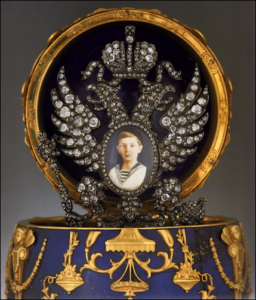
(Courtesy Virginia Museum of Fine Arts)
Marks: Fabergé, H. W.
Materials: Egg – gold, lapis lazuli, portrait diamond, brilliant diamond | Frame surprise – platinum, lapis lazuli, rose-cut diamonds, watercolor on ivory
Dimensions: Height of egg – 125 mm. (4 15/16 in.) | Diameter of egg – 89 mm. (3 1/2 in.)
Description: Designed in the style of Louis XV, this egg is carved from a block of lapis lazuli of superb quality and is enclosed in an elaborately carved and chased gold cage-work composed of conventionalized motifs, including scrolls, shells, baskets of flowers, winged cherubs, and the Imperial double-headed eagle beneath a canopy hanging from a fretted arch. The crowned Imperial monogram AF (Editor’s note: Alexandra Feodorovna) and the year 1912 are shown under a rectangular portrait diamond surmounting the egg; a large brilliant diamond is set in the base.
Inside the egg, a crowned double-headed Imperial eagle in platinum is richly set back and front with 2,000 rose-cut diamonds. It frames a miniature portrait of the tsesarevich, which is supported on a diamond-set lapis lazuli base with four diamond leaves, curled to serve as feet. The reverse side frames a miniature showing the back of the seven-year-old tsesarevich. Here in this whole composition is a striking instance of the beauty of the frame, surpassing by far the picture it holds, for it must be confessed that the miniature portrait, which is understandably not signed, provides in its weakness of execution, a melancholy anticlimax to a good design (Snowman, 1962).
David Curry in Fabergé: Virginia Museum of Fine Arts (Richmond, 1995) says the miniature portrait has been replaced because of damage. The stand of silver-gilt is modern and is a copy of the 15th Anniversary Egg’s stand. An archival black and white photograph of the egg with its original stand was published in A. Kenneth Snowman, Art of Fabergé (London, 1953). The photograph shows the feet of the original stand turned inward in a Greek key pattern.
Background Notes: The hemophilia of their only son, kept secret from the Russian people, was a great personal blow to Nicholas II and Alexandra and influenced considerably the last twelve years of the tsar’s reign. Alexandra would devote the rest of her life to protecting her son, clutching at any hope offered by anyone, including Grigorii Rasputin:
Writing just three years after the Imperial family was shot, Pierre Gilliard, the tsesarevich’s French tutor, was kinder:
But in the autumn of 1912, while the Imperial family was at the hunting lodge at Spala in Poland, the tsesarevich suffered a severe hemorrhage in his thigh and groin that almost killed him. It had been brought on by a fall some weeks before. Gillard, who had just begun teaching the tsesarevich, was a first-hand witness to the drama which unfolded. The first lesson was on October 2, with the tsarina present. But, Gillard said:
Bulletins were issued about his state of health, without saying exactly what was the cause of the problem. During this eleven-day period in October, 1912, gray appeared in the thirty-nine-year-old tsarina’s golden hair. The last sacrament was administered, and a notice announcing Alexei’s death was prepared. Then Alexandra called on Rasputin, who told her not to grieve: “The little one will not die.” Rasputin was a peasant, born in 1872 in the west Siberian village of Pokrovsko. A starets (unordained holy man) and strannik (pilgrim sustained by the charity of others), Rasputin first appeared in St. Petersburg in 1903 and was introduced to the Imperial family by Anastasia and Militsa, the daughters of the King of Montenegro. The tsarina, desperate for a son after four daughters, sought help from any source, including Rasputin, to fulfill this desire. Their relationship cooled after several Rasputin prophecies failed to come true. It was the Spala crisis that brought Rasputin back into Imperial favor and gave him unparalleled influence with the tsarina.
Eugène Fabergé recalled in a letter written to H. C. Bainbridge on June 5, 1934, that on March 13 (OS), 1912, he had delivered the egg in person:
The official invoice for this egg has been lost. However, other account books and correspondence survive that indicate the two Easter eggs produced for 1912 together cost 50,897 rubles, 50 kopecks. As a note of caution, this total probably includes other, smaller, unspecified items included in Fabergé’s bill. An expert valuation was made of this egg in 1927. Located by Fabergé, Proler, & Skurlov, the valuation noted that one rose-cut diamond was missing. The egg was valued at 14,205 rubles.
In Quest of the Romanoff Treasure (New York, 1932), Armand Hammer claimed Fabergé spent three years designing and contemplating this egg. In 1936, Hammer maintained it was worth 100,000 gold rubles (about $50,000). Russian official records reveal Hammer paid just 8,000 rubles (about $4,000) for the egg six years before. When the Virginia Museum of Fine Arts, Richmond, received the Egg after the death of Lillian Thomas Pratt it sat in a gilded silver stand which was not the original. An early photograph indicated the Egg was cradled in a three-legged, diamond-studded stand with inward turned Greek key pattern feet. In 2012, the Virginia Museum of Fine Arts had the original stand replicated in bronze and painted to look like gold. This stand now supports the Tsesarevich Egg. (Further details on the stand “1912 Tsesarevich Egg and Its Stands through the Ages” Faberge Research Newsletter, Winter 2014)
Provenance:
- March 25 (OS), 1912. Would have been presented to Alexandra Feodorovna, a gift from Nicholas II; cost 28,597 rubles
- 1912-1916. Housed in Alexandra Feodorovna’s Mauve Sitting Room in the Alexander Palace
- September 16-20 (OS), 1917. One of forty or so eggs sent to the Armoury Palace of the Kremlin in Moscow by the Kerensky Provisional Government for safekeeping
- February-March 1922. Transferred to the Sovnarkom, the Council of People’s Commissars
- June 17, 1927. One of sixteen eggs returned to the Armoury from the Foreign Currency Fund of the Narkomfin (Finance Ministry); given inventory no. 17547
- April 30, 1930. One of twelve eggs selected for export sale
- June 21, 1930. Transferred to the Antikvariat (Trade Department)
- 1930. One of ten Imperial eggs sold by the Antikvariat, Moscow, to Hammer Galleries, New York, for 8,000 rubles (ca. $4,000)
- January 1933. Exhibited by Hammer Galleries, New York
- September 1933-May 1934. Purchased by Lillian Thomas Pratt, later of Fredericksburg, Virginia
- July 21, 1947. Collection of the late Lillian Thomas Pratt, willed to Virginia Museum of Fine Arts, Richmond
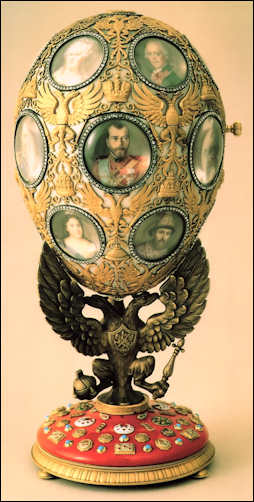
(Fabergé, Proler, and Skurlov, The Fabergé Imperial Easter Eggs, 1997, 213)
Marks: Fabergé in Cyrillic, H. W., 1913, 72, kokoshnik
Materials: Egg – gold, silver, portrait diamonds, rose-cut diamonds, turquoise, rock crystal, purpurine, translucent white enamel, opalescent white enamel, watercolor on ivory | Miniature globe – steel, varicolored gold, dark blue enamel
Dimensions: Height of egg – 190 mm. (7 1/2 in.) | Diameter of egg – 78 mm. (3 1/16 in.)
Description: This egg, one of Fabergé’s most astonishing pieces, commemorates 300 years of Romanov rule. Enameled translucent white on a guilloché gold field, it is decorated with a pattern of chased gold, double-headed eagles and ancient and contemporary Romanov crowns, framing-at intervals-miniatures of all eighteen Romanov rulers, within rose-cut diamond borders. The miniatures, painted on ivory, are by Zuiev. The inside of the egg is covered with opalescent white enamel on a guilloché ground. The egg, which is removable, rests on a pedestal in the form of a three-sided Imperial eagle in pale gold, the three talons holding respectively, the scepter, orb, and Romanov sword. Supporting this, the circular gem-set purpurine base, mounted in gold, represents the Russian Imperial shield.
Within the egg is a rotating steel globe, enameled dark blue and divided into two halves. One hemisphere shows a map of the Russian Empire in 1613, the other, in 1913. The blue enamel represents the sea, and the land masses are described in colored golds. Portrait diamonds are set at either end of this egg, the one on the top covering the dates 1613 and 1913, while the triangular diamond at the base covers the tsarina’s monogram (Snowman, 1979; Fabergé, Proler, & Skurlov, 1997).
Background Notes: As if saying a last farewell, Nicholas II and Alexandra Feodorovna made a pilgrimage in the tercentenary year, retracing the journey made by Michael Romanov on his way to the throne. In fact, the celebrations across Russia were sustained, extravagant, and, judging by photographs, well attended by the masses. Not surprisingly, the Imperial couple completely misread the mood of the nation. Alexandra in particular, would find it difficult to believe the events that would overwhelm them in just three years’ time. She believed to the end that the Russian peasants worshipped Nicholas and herself.
In its own way, this egg-which is the epitome of autocratic Imperial power – indicates how little Russia had changed in 300 years under Romanov rule. It also makes an interesting comparison with the Winter Egg and shows Fabergé’s flexibility in his work: one egg delicate and subtle, the other conveying overt power and majesty. Tatiana Muntian in Fabergé Easter Gifts (Moscow, 2003) notes that the members of the Romanov dynasty are arranged in chronological order, with one exception. The portrait of Nicholas II is placed so that Peter the Great is at the center, and not the reigning Tsar. She says this was certainly not done at the instigation of Nicholas II, who was known to have “an aversion towards the great reformer” (Editor’s note: Peter the Great) which “was deep-seated.” See Background Notes for the 1903 Peter the Great Egg.
The official invoice quoted by Fabergé, Proler, & Skurlov, in Fabergé Imperial Easter Eggs (London, 1997), says:
The Romanov Tercentenary Egg is listed in the 1922 inventory of confiscated Imperial treasure. An expert valuation was made of this egg in 1927. Found by Fabergé, Proler, & Skurlov, the valuation estimated the egg’s worth at 17,484 rubles.
Provenance:
- April 14 (OS), 1913. Would have been presented to Alexandra Feodorovna, a gift from Nicholas II; cost 21,300 rubles
- 1913-1916. Housed in Alexandra Feodorovna’s Mauve Sitting Room in the Alexander Palace
- September 16-20 (OS), 1917. One of forty or so eggs sent to the Armoury Palace of the Kremlin in Moscow by the Kerensky Provisional Government for safekeeping
- February-March 1922. Transferred to the Sovnarkom, the Council of People’s Commissars
- June 17, 1927. One of sixteen eggs returned to the Armoury from the Foreign Currency Fund of the Narkomfin (Finance Ministry); given inventory no. 17548
- Retained by the Armoury Museum of the Kremlin, Moscow
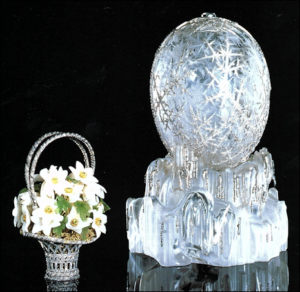
(Fabergé, Proler, and Skurlov, The Fabergé Imperial Easter Eggs, 1997, 210)
Marks: Egg – no marks apparent | Miniature basket – Fabergé 1913 on bottom of flower basket
Materials: Egg – rock crystal, platinum, rose-cut diamonds, brilliant diamonds, moonstone | Miniature basket – platinum, gold, white quartz, nephrite, demantoid (green) garnets | Base – rock crystal
Dimensions: Overall height – 142 mm. (5 5/8 in.) | Height of egg – 102 mm. (4 in.) | Height of surprise – 82 mm. (3 3/16 in.)
Description: The egg is set on a rock crystal base formed as a block of melting ice, applied with platinum-mounted rose-cut diamond rivulets. The hinged, rock-crystal egg is detachable and is held vertically above by a pin. The egg has rose-cut, diamond-set platinum borders, graduated around the hinge and enclosing at the top, a cabochon moonstone painted on the reverse with the date 1913. The thinly carved transparent body of the egg is finely engraved on the interior to simulate ice crystals, while the outside is further engraved and applied in carved channels with similar rose-cut diamond-set platinum motifs.
The egg opens vertically to reveal the surprise-a platinum, double-handled trelliswork basket, set with rose-cut diamonds and full of wood anemones, suspended from a platinum hook. Each flower is realistically carved from a single piece of white quartz (Editor’s note: Bainbridge believed the flowers were carved from cacholong, a milky opal) with a gold wire stem and stamens, the center set with a demantoid (green) garnet, some carved half open, or in bud, the leaves delicately carved in nephrite, emerging from a bed of gold moss. The base of the basket is engraved “Fabergé 1913.”
Background Notes: This is another Tsar Imperial egg that disappeared from public view for some decades, and happily reemerged in early 1993, when it was found in a shoebox under a bed in London’s Belgravia. It reputedly had sat on a bedroom table in the same apartment in 1979, left undisturbed when the flat was burgled.
If the House of Fabergé was often derivative, occasionally it could be brilliantly original. So it was with the Winter Egg, without doubt one of the most creative and technically challenging of all the Easter eggs Fabergé made for the tsar. It symbolizes the transition from winter to spring, the seed emerging into new life, the Resurrection. The spring flowers appear as if through a frosty mist inside the winter ice of the egg, before the egg is opened to reveal the surprise. Only in the First Tsar Imperial Egg, the Hen Egg of 1885, the 1885-89 Imperial Resurrection Egg, and the 1915 Tsar Imperial Red Cross Egg Triptych Egg is the Easter message so clearly illustrated. But none of these has the degree of delicacy achieved in the Winter Egg.
Many of Fabergé’s Imperial eggs rely on standard rococo and neoclassical motifs, albeit superbly executed in gold and enamel, for their effect, but Alma Theresia Pihl, the designer of the Winter Egg, broke away from these conventional elements to produce a magical work of genius. The story goes that Alma’s design was inspired by icicles that she noticed on a window pane. This winter motif became the basis for the many snowflake brooches and other items made by Fabergé for Dr. Emanuel Nobel, a wealthy industrialist, to give to friends. The design is also used in a different form in the 1910-14 Nobel Ice Egg.
According to the original Fabergé invoice, dated “13 April 1913,” which is now in the Russian State Historical Archives in Moscow, the price of the Winter Egg was 24,600 rubles, one of the highest figures for a Tsar Imperial egg produced by Fabergé. The Winter Egg is described on the invoice as follows:
The skill of the Holmström workshop in mounting the rock crystal is highlighted by François Birbaum in his memoirs:
The method by which the rose-cut diamond-set platinum ice crystals are attached to the rock crystal shell of the Winter Egg is not apparent. They do not appear to be pinned, and the only suggestion is that they were glued into channels carved in the rock crystal beneath. According to Bainbridge, the only work for which the Holmströms were not responsible in this egg, was that of the lapidaries on the egg, pedestal, and cacholong flowers, and the engraving of the internal frost-flowers. It seems highly likely that the lapidary work for the Winter Egg was executed in the Fabergé workshop of Petr Kremlev and probably by Kremlev himself. It is significant that, in this twenty-seventh year of supplying the Imperial family with Easter eggs, Fabergé, rather than resting on past glories, pressed on to new triumphs and applications, using technical secrets which still remain secret. The egg is described in the 1922 inventory of confiscated Imperial treasure. It is egg is unmarked, probably because Russia had no hallmark for platinum at this time.
The Winter Egg changed hands several times at auction after its rediscovery in the early 1990s. In 2002, Sheikh Saud Al-Thani of Qatar, a cousin of the ruling Emir, bought the egg for a world record price of nearly $9.6 million. But by March 2005, Sheikh Saud was under house arrest for misappropriating public funds. He was removed as Chairman of the oil-rich state’s National Council of Culture, Arts and Heritage, which was then restructured. His brother, Sheikh Hassan Al-Thani was appointed vice-president of the newly formed Authority of Museums of Qatar. The president was the ruling Emir’s daughter, Sheikha Al Mayassa. The scandal was exposed in a series of articles by the plain-speaking London-based The Art Newspaper beginning in March 2005.
Provenance:
- April 14 (OS), 1913. Would have been presented to Marie Feodorovna, a gift from Nicholas II; cost 24,600 rubles (Editor’s note: $299,173 in 2014 dollar terms). Apparently housed in the Anichkov Palace
- September 16-20 (OS), 1917. One of forty or so eggs sent to the Armoury Palace of the Kremlin in Moscow by the Kerensky Provisional Government for safekeeping
- February-March 1922. Transferred to the Sovnarkom, the Council of People’s Commissars
- ca. 1925. Transferred to the Antikvariat (Trade Department)
- ca. 1927. One of nine Imperial eggs sold by the Antikvariat, Moscow, to Emanuel Snowman of Wartski, for £450
- March 12, 1934. Transferred from Wartski London
- March 8, 1934. Sold to Lord Alington [sic], London landowner, UK, for £1500
- June 1935. Owned anonymously
- May 10, 1948. Owned by the late Sir Bernard Eckstein, sugar & cotton millionaire, UK
- February 8, 1949. Lot 128 sold by Sotheby’s (London) from the Collection of the late Sir Bernard Eckstein, UK, to Arthur Bryan Ledbrook, UK, for £1,870 (£1,700 plus 10 percent buyer’s premium); $5,236 (Editor’s note: About $299,173 in 2014 terms. Bryan Ledbrook was, according to A. Kenneth Snowman, “a magpie collector who used to keep the Egg in his Pimlico, London, garage.” The Winter Egg disappeared about 1975 after Mr. Ledbrook died.)
- 1993. Located in a shoebox under a bed in London’s Belgravia by a Sydney-based fine arts dealer
- November 16, 1994. Only lot sold by Christie’s (Geneva) on behalf of an Australian syndicate headed by Melbourne jeweler, Roy Martin to telephone bidder, Gary Hansen of St. Louis, Missouri, acting for a U.S. buyer, for SFr 7,263,500; $5,587,308; £3,560,539
- April 19, 2002. Lot 150 sold by Christie’s (New York) on behalf of an anonymous U.S. vendor to Sheikh Saud Al-Thani of Qatar for $9,579,500, including a buyer’s premium
- 2009. Owned by the Qatar Authority of Museums
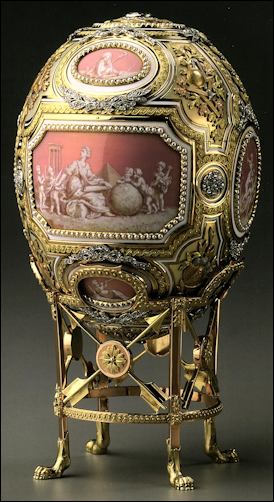
(Tillander-Godenhielm, Fabergén suomalaiset mestarit, 2011, 123)
Marks: Fabergé under lid
Materials: Egg – quatre-couleur gold, pink grisaille and opaque white enamel, portrait diamonds, rose-cut diamonds, seed pearls, velvet lining | Automaton surprise – gold, enamel, probably diamonds
Dimensions: Height of egg – 121 mm. (4 3/4 in.) | Height with stand – 171 mm. (6 3/4 in.) | Diameter of egg – 89 mm. (3 1/2 in.)
Description: Of Louis XV style, set at the front and back with two large rectangular panels painted by Vasilii Zuiev in camaieu rose with allegories of science and art, respectively, in the manner of François Boucher within borders of seed pearls and opaque white enamel. Two additional oval panels above and below and to the sides are similarly painted and then framed with two-color gold borders with diamond-set bowknots at the top and sprays of leaves at the bottom. The oval panels contain representations of cupids, each typifying a season. The side panels depict trophies of the arts of peace. Spandrels are chased in four-color gold with musical trophies and laurel leaves on a matt gold ground. On the top and bottom of the egg are rosettes of leaves and berries carved in varicolored gold. The top rosette centers a portrait diamond with the cipher of the Dowager Empress Marie Feodorovna. The rosette at the bottom has another portrait diamond with the date 1914. The frames of the rosettes have rows of pearls and outer borders of white enamel. The egg opens to show a lining of velvet for the Easter surprise, now missing (Ross, 1965; von Habsburg & Lopato, 1993).
Background Notes: Marvin Ross (Art of Karl Fabergé and His Contemporaries Oklahoma, 1965) speculated that the possible surprise for this egg, variously called the Catherine the Great, Grisaille, or Pink Cameo Egg, may have been an incomparable necklace of pink pearls. However, Alexander von Solodkoff, in Art of Carl Fabergé (London, 1988), quotes a letter from Marie to her sister, Queen Alexandra of England, which partly solves the puzzle:
von Solodkoff continues:
The director of Hillwood Museum at the time, Roy Betteley, took the Catherine the Great Egg to New York to try this sedan chair inside it, but the fit was too tight. The sedan chair was, at the time, for sale and the museum was thinking of bidding for it. A. Kenneth Snowman told Professor George W. Terrell Jr., of Gadsden State Community College, that he was almost sure he had at one time seen a Fabergé sedan chair, which had its original box. It therefore would not have been the surprise from a Tsar Imperial Easter Egg. (Editor’s note: This item would have been the Clore chair described above. The Clore automaton sold for SFr 1,430,000, or about £500,000, in 1985).
On page 26 of the January 19, 1928, edition of the weekly newspaper, The Queenslander, a photo-spread of Fabergé items includes a sedan chair. The nature of the accompanying text suggests, without actually saying, the items were in the inventory of Armand Hammer. If this is so, it may well the second, smaller sedan chair which accompanied this Egg and which had also been acquired by Hammer. Unpublished notes made by Léon Grinberg, a fine arts dealer specializing in Fabergé who fled Paris for New York early in World War II, indicate that the mechanism for the automaton for this egg was made by Andrei Plotnitskii, whose skills in this area were used by Fabergé on other occasions. Plotnitskii was reported to have worked on a number of other Tsar Imperial eggs as well, although the notes regrettably do not go into detail.
Tatiana Muntian, in von Solodkoff, Fabergé: Juwelier des Zarenhofes (Hamburg, 1995), has confirmed that the egg and its surprise had already been separated by the time the egg reached the Kremlin in 1917. The 1917 inventory of confiscated Imperial treasure lists this egg without mentioning the surprise, but the following appears in the 1922 inventory, “1 gold and enamel sedan chair with 2 blackamoor bearers.” (Fabergé, Proler, & Skurlov, Fabergé Imperial Easter Eggs, London, 1997)
A 1927 Armoury description of this egg says its surprise was missing when it arrived at the Kremlin. The description noted the egg was decorated with about 937 rose-cut diamonds and 500 pearls and had with it a silver stand. The Fabergé invoice for the Tsar Imperial Easter eggs for 1914 appears lost. However, other account books and correspondence survive that indicate the two Easter eggs produced for 1914 together cost 59,452 rubles. As a note of caution, this total probably includes other, smaller, unspecified items included in Fabergé’s bill. But an article published by Tatiana Muntian in December, 2013, to mark the 400th anniversary of the Romanov dynasty, included material from newly-discovered documents about the individual Imperial Easter Eggs for 1912, 1914 and 1915. The Catherine the Great Egg had cost 26,800 rubles.
The Hillwood Museum says there are a number of references in Mrs. Marjorie Merriweather Post’s handwriting, stating that her daughter Eleanor Barzin bought the egg for her in 1931. Other references to a 1936 acquisition by Mrs. Post, however superficially convincing, are incorrect.
Provenance:
- April 6 (OS), 1914. Would have been presented to Marie Feodorovna, a gift from Nicholas II; cost 26,800 rubles. Housed in the Anichkov Palace
- September 16-20 (OS), 1917. One of forty or so eggs sent to the Armoury Palace of the Kremlin in Moscow by the Kerensky Provisional Government for safekeeping
- February-March 1922. Transferred to the Sovnarkom, the Council of People’s Commissars
- Transferred to the Moskovskoye Yuvelirnoye Tovarishchestvo (the Moscow Jewelers’ Union, or M.Y.T.)
- June 27, 1927. One of eight eggs returned from the M.Y.T. to the Armoury; given inventory no. 17558
- April 30, 1930. One of twelve eggs selected for export sale
- June 21, 1930. Transferred from Armoury to the Antikvariat (Trade Department)
- 1930. One of ten Imperial eggs sold by the Antikvariat, Moscow, to Hammer Galleries, New York, for 8,000 rubles (ca. $4,000)
- Advertised by Hammer Galleries for $18,500
- 1931. Bought by Eleanor Barzin as a gift for her mother, Marjorie Merriweather Post, for $12,500
- 1935. Owned by Mrs. Post as Mrs. Joseph E. Davies
- 1958. Owned by Mrs. Post as Mrs. Herbert May
- September 12, 1973. Collection of the late Marjorie Merriweather Post, at Hillwood Museum, Washington, D.C.
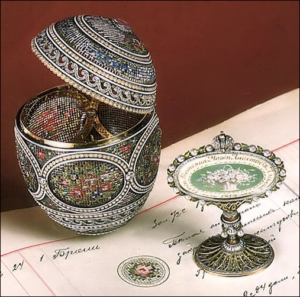
Mosaic Egg with Surprise on Albert Holmström Stock Book
(de Guitaut, Fabergé in the Royal Collection, 2003, 34)
Marks: C. Fabergé, G. [sic] Fabergé, 1914, A. F. (Alexandra Feodorovna)
Materials: Egg – yellow gold, platinum, brilliant diamonds, rose-cut diamonds, rubies, emeralds, topazes, sapphires, garnets, half-pearls, moonstone, white enamel, opaque pink enamel | Pedestal surprise – gold, pearls, rose-cut diamonds, green garnets, translucent green, opaque white, opalescent pale pink, pale green and pale sepia grisaille enamel
Dimensions: Height of egg – 95 mm. (3 5/8 in.) | Diameter of egg – 70 mm. (2 3/4 in.) | Height of miniature – 79 mm. (3 1/8 in.) | Diameter of miniature – 55 mm. (2 3/8 in.) | Depth of miniature – 29 mm. (1 3/8 in.)
Description: An Easter egg, the skeleton of which consists of a system of yellow gold belts, to which is applied a platinum network partially pavé-set with diamonds and colored gems, including sapphires, rubies, emeralds, topaz quartz, and demantoid (green) garnets in flower patterns. This technique gives the look of petit point tapestry work, partly completed. The egg is divided into five oval panels by these gold belts, which are set with half-pearls within lines of opaque white enamel. Five brilliant diamonds are set at each intersection; it is further decorated by grilles of rose-cut diamond scrolls, and the rounder end is set with a moonstone beneath, through which may be seen the gold initials of the tsarina in Russian characters, inlaid in an opaque, pale pink enameled plaque serving as a foil.
The surprise, concealed inside and held in place by two gold clips, consists of a gold, pearl, and translucent green and opaque white enameled pedestal set with diamonds and green garnets and surmounted by a diamond Imperial crown, supporting an oval plaque. On one side is painted in pale sepia grisaille enamel, the profiles of the five Imperial children against a background of engraved vertical parallel lines enameled opalescent rose-pompadour. The reverse is enameled with a pale sepia basket of flowers against a pale green background, around which the year 1914 and the names of the children are painted in sepia on the opaque white enameled border.
Designed as a jewel, this beautiful egg was made in Holmström’s workshop and is engraved with Fabergé’s name in Cyrillic characters, but underneath the pedestal, in addition to the sun-in-splendor design, the words G. Fabergé, 1914 have been engraved, presumably by a later misguided hand (Snowman, 1979). Fabergé, Proler, & Skurlov in Fabergé Imperial Easter Eggs (London, 1997), believe the G. Fabergé was Carl Fabergé’s way of marking the 100th anniversary of his father, Gustav Fabergé’s, birth.
Background Notes: We now know that Alma Theresia Pihl, who was responsible for the Winter Egg, also designed the tapestry flower detail that has so effectively been translated to the Mosaic Egg. The design books of Albert Holmström record this central motif of the panels in a brooch dated “July 24 (OS), 1913” (Snowman, Fabergé: Lost and Found, London, 1993). Alma was the daughter of another Fabergé workmaster, Oskar Pihl. He had been apprenticed to August Holmström and became a master in 1887. He died in 1897. Alma survived the turbulent times ahead, dying in 1976, at age eighty-eight. Caroline de Guitaut in Fabergé in the Royal Collection (London, 2003) says Alma told a niece that inspiration for the design of the Mosaic Egg came during a quiet evening with her husband Nikolai Klee and her mother-in law, early in 1913:
Hans Nadelhoffer points out in Cartier: Jewelers Extraordinary (New York, 1984) that a mosaic tapestry motif was used by the French jewelry firm two years earlier, but Cartier had used only colorless diamonds, so the full effect of a mosaic pattern was not realized.
In some ways, the Fabergé story of the Tsar Imperial Easter eggs ends here. Within months, the cataclysm of World War I would begin, and with it would end the era of privilege and luxury so exactly reflected in Fabergé’s master works. The firm would continue to produce Tsar Imperial Easter gifts for three more years, but the cost of the war would mean grim austerity for Russia, the tsar and Fabergé. The war would call many of his craftsmen to arms, and soon the company would be making utilitarian items as part of the war effort. This was the last Easter gift made without the constraints of a menacing outside world. It seems appropriate that it should be something as beautiful and original as the Mosaic Egg is. (See Royal Collection Trust video)
The official invoice for the 1914 Tsar Imperial Easter eggs appears lost. However, other account books and correspondence survive that indicating that the two Easter eggs produced for 1914 together cost 59,452 rubles. As a note of caution, this total probably includes other, smaller, unspecified items included in Fabergé’s bill. But an article published by Tatiana Muntian in December, 2013, to mark the 400th anniversary of the Romanov dynasty, included material from newly-discovered documents about the individual Imperial Easter Eggs for 1912, 1914 and 1915. The Mosaic Egg cost 28,300 rubles, making it the second most expensive Imperial Easter Egg made by Fabergé (after the 12 Tsesarevich Egg). The 1922 inventory of confiscated Imperial treasure lists 1 gold egg as though embroidered on canvas, with diamonds, rose-cut diamonds and colored gemstones, containing a portrait screen with rose-cut diamonds and pearls.
An expert valuation was made of this egg in 1927. Found by Fabergé, Proler, & Skurlov, the valuation estimated the egg’s worth at 30,096, the second most valuable of the sixteen eggs in the list. The 1906 Moscow Kremlin Egg was given the highest value-46,400 rubles.
Provenance:
- April 6 (OS), 1914. Would have been presented to Alexandra Feodorovna, a gift from Nicholas II; cost 28,300 rubles
- 1914-1916. Probably housed in Alexandra Feodorovna’s study at the Winter Palace
- September 16-20 (OS), 1917. One of forty or so eggs sent to the Armoury Palace of the Kremlin in Moscow by the Kerensky Provisional Government for safekeeping
- February-March 1922. Transferred to the Sovnarkom, the Council of People’s Commissars
- June 17, 1927. One of sixteen eggs returned to the Armoury from the Foreign Currency Fund of the Narkomfin (Finance Ministry); given inventory no. 17549
- Transferred to the Antikvariat (Trade Department)
- 1933. Sold by the Antikvariat to an unrecorded buyer for 5,000 rubles (ca. $2,500) after an initial Armoury valuation of 20,000 rubles
- May 22, 1933. Bought by King George V from Cameo Corner, London, probably as a birthday present for Queen Mary (whose birthday was May 26) for “half cost” of £250. Queen Mary may have paid the balance
- 1953. Inherited by Queen Elizabeth II
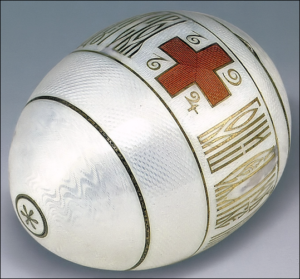

Curry, Fabergé: Virginia Museum of Fine Arts, 1995, 85, 88-89
Marks: Fabergé 1915, H. W., 65, illegible
Materials: Egg – silver, gold, opalescent white and translucent red enamel | Miniature screen – gold, mother of pearl, watercolor on ivory
Dimensions: Height of egg – 76 mm. (3 in.) |Diameter of egg – 60 mm. (2 3/8 in.)
Description: Opalescent white guilloché enamel covers a chased silver ground on this egg. Two opposing red enamel crosses bear the dates 1914 and 1915. A Russian inscription, in stylized gold enamel script in a band around the egg reads: “Greater love hath no man than this, that a man lay down his life for his comrades.” On the top of the egg is the crown and monogram of the Dowager Empress Marie in silver, while at the bottom is a six-petal rosette. The egg contains a hinged, folding screen of five oval miniature portraits, each set in an opalescent white enameled panel mounted in gold. The portraits, by Vasilii Zuiev, are of:
Grand Duchess Olga Nicolaievna, his eldest daughter
Tsarina Alexandra Feodorovna
Grand Duchess Tatiana Nicolaievna, the tsar’s second daughter
Grand Duchess Marie Pavlovna, the tsar’s first cousin
Each wears the uniform of the Red Cross, whose symbol surmounts the individual panels. Each miniature is backed with mother of pearl and has the monogram of the person whose painting appears on the front (Snowman, 1962; Lesley, 1976).
Background Notes: This egg pays tribute to the service rendered to the Red Cross by Marie Feodorovna, first as tsarevna (crown princess) during the Russo-Turkish War of 1877, and then as president of the organization from the beginning of her reign until the fall of the Romanov dynasty. On March 25 (OS), 1915, Marie wrote to her daughter Olga:
Marie Feodorovna and other Romanov women did not shirk their wartime duty. The dowager empress opened a hospital in the Anichkov Palace and she made bandages. As well, she made gifts and sorted sheets for sickbeds in a palace dining room; she paid for two military trains and visited hospitals in Petrograd and Kiev. In a letter dated December 15 (OS) 1914 to Grand Duchess Nicholas Michaelovich, Marie wrote:
The invoice for the 1915 Tsar Imperial Easter eggs appears lost. But an article published by Tatiana Muntian in December, 2013, to mark the 400th anniversary of the Romanov dynasty, included material from newly-discovered documents about the individual Imperial Easter Eggs for 1912, 1914, and 1915. The Red Cross Portraits Egg had cost just 3,875 rubles.
The 1917 inventory of confiscated Imperial treasure records, “Gold [sic] egg, covered with white enamel and a red cross, on small stand, containing a small, mother-of-pearl white enamel screen and with portraits of Imperial personages in a gold setting.” (Fabergé, Proler, & Skurlov, Fabergé Imperial Easter Eggs, London, 1997)
An expert valuation was made of this egg in 1927. Found by Fabergé, Proler, & Skurlov, the valuation estimated the egg’s worth at just 1,632 rubles-less than a tenth of the average value of the other fifteen eggs on the list. This was the first of five Imperial Easter eggs to be purchased by Lillian Thomas Pratt, wife of a General Motors executive, of Fredericksburg, Virginia.
Provenance:
- March 22 (OS), 1915. Would have been presented to Marie Feodorovna, a gift from Nicholas II; cost 3,875 rubles. Apparently housed in the Anichkov Palace
- September 16-20 (OS), 1917. One of forty or so eggs sent to the Armoury Palace of the Kremlin in Moscow by the Kerensky Provisional Government for safekeeping
- February-March 1922. Transferred to the Sovnarkom, the Council of People’s Commissars
- June 17, 1927. One of sixteen eggs returned to the Armoury from the Foreign Currency Fund of the Narkomfin (Finance Ministry); given inventory no. 17550
- April 30, 1930. One of twelve eggs selected for export sale
- June 21, 1930. Transferred from the Armoury to the Antikvariat (Trade Department)
- 1930. One of ten Imperial eggs sold by the Antikvariat, Moscow, to Hammer Galleries, New York, for 500 rubles (ca. $250)
- October 31, 1933. Purchased by Lillian Thomas Pratt, later of Fredericksburg, Virginia
- July 21, 1947. Collection of the late Lillian Thomas Pratt, willed to Virginia Museum of Fine Arts, Richmond
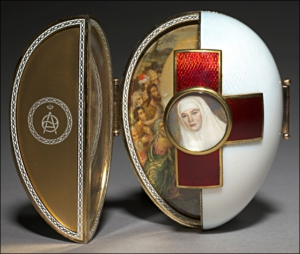
(Courtesy Cleveland Museum of Art)
Marks: Fabergé, H. W., 72, kokoshnik, lower case alpha in script
Materials: Silver, gold, opalescent white, and translucent red enamel, watercolor on gold, glass
Dimensions: Height of egg – 86 mm. (3 3/8 in.) | Diameter of egg – 63 mm. (2 1/2 in.)
Description: In opalescent white enamel on an engraved silver-gilt ground, this gold-mounted egg is emblazoned with a translucent bold red enamel cross on either side. The center of each cross is set with circular painted miniature portraits of, respectively, the Grand Duchess Olga and the Grand Duchess Tatiana in Red Cross uniforms. They were the first two daughters of Tsar Nicholas II and Alexandra Feodorovna. The front cross with the portrait of Tatiana serves as a clasp securing the double-opening doors. The front of the egg divides into two quarters when opened, revealing a triptych within. The central scene is the Harrowing of Hell. Christ stands in the center atop the doors of Hell, which he has just broken down. He grasps Adam by his right hand, and he is surrounded by patriarchs and prophets. The Harrowing of Hell is the customary method of representing the Resurrection in the Orthodox Church. Saint Olga, the founder of Christianity in Russia, is represented on the left wing of the triptych, the Martyr Saint Tatiana, on the right. (Editor’s note: These are the name saints of Nicholas II’s first two daughters.) The central scene is painted in natural colors, but a general golden tonality, traditional for such subject matter, has been used. The wings are decorated in natural colors on gold grounds.
According to A. Kenneth Snowman, the interior miniatures were executed by Adrian Prachov, who specialized in icons. The two remaining panels of the doors are inscribed, one with the crown monogram of the tsarina, and the other with the year 1915. The borders and major inscriptions are in opaque white enamel. According to Snowman, only the mounts of this egg are of gold. As with its companion piece for Marie Feodorovna, the cost was held down as a wartime economy measure. The egg retains its original velvet case, although the accompanying stand is modern (Hawley, 1967; Snowman, 1977). The miniature portraits of the two grand duchesses are probably by the court painter Vasilii Zuiev, who did the miniatures for the companion Red Cross Portraits Egg. This is one of the few Tsar Imperial Easter eggs which opens vertically. The 1913 Winter Egg is another.
Background Notes: This appears to be the one time when the eggs for the two tsarinas in the same year could be regarded as obvious companion pieces. (Editor’s note: There is a more subtle connection between the 1916 eggs. Nicholas II had been awarded the Cross of the Order of St. George in October 1915. The orange and black ribbon of the Order is used on the outside of Marie Feodorovna’s 1916 Easter egg, the Order of St. George Egg, while the colors appear as part of the surprise in Alexandra Feodorovna’s 1916 egg, the Steel Military Egg.) Olga, Tatiana, their mother the tsarina, and other Imperial Romanov women worked in a field hospital set up in the huge Catherine Palace at Tsarskoe Selo, where the wounded from the front were brought to recover. Russia sustained massive losses in the first five months of World War I, with one million dead, wounded, or taken prisoner. The women daily tended to battle casualties, some of the men having sustained appalling injuries. Alexandra did not spare herself. Her companion Anna Vyrubova wrote of seeing Alexandra in the operating room taking from the hands of busy surgeons amputated legs and arms, removing bloody and even vermin-infested field dressings, enduring all the sights and smells and agonies of the most dreadful of all places, a military hospital in the midst of war. (Massie, Nicholas and Alexandra, London, 1992) And her daughters were not spared, either. Alexandra wrote to Nicholas at the front:
David Curry in Fabergé: Virginia Museum of Fine Arts (Richmond, 1995) says there was keen competition from Lillian Thomas Pratt for this egg, as a companion piece for the other Red Cross Egg of 1915, which Mrs. Pratt had purchased ten years earlier. However, Mrs. India Early Minshall, widow of an oil executive of Cleveland, Ohio, was the eventual buyer. There is a curious discrepancy here. Files in the Cleveland Museum of Art, Ohio, show that Mrs. Minshall purchased this egg on March 6, 1943, from A La Vieille Russie. Yet Alexander Schaffer had written to Lillian Thomas Pratt on December 8, 1941:
The solution may be that the Red Cross Triptych Egg was sold by Schaffer to A La Vieille Russie, from where Mrs. Minshall eventually bought it. The exact business arrangements between Schaffer, Léon Grinberg, and Jacques Zolotnitsky at this time are not clear. Grinberg and Zolotnitsky fled Europe because of World War II, and eventually Schaffer joined them in the jewelry retail firm A La Vieille Russie of New York. Of course, there could also have been another private owner before Mrs. Minshall, or Mrs. Minshall may have bought it in installments.
The invoice for the 1915 Tsar Imperial Easter eggs appears lost. But an article published by Tatiana Muntian in December, 2013, to mark the 400th anniversary of the Romanov dynasty, included material from newly-discovered documents about the individual Imperial Easter Eggs for 1912, 1914 and 1915. The Red Cross Triptych Egg had cost just 3,600 rubles. The 1922 inventory of confiscated Imperial treasure includes a brief description of this egg.
Provenance:
- March 22 (OS), 1915. Would have been presented to Alexandra Feodorovna, a gift from Nicholas II; cost 3,600 rubles. Apparently housed in Alexandra Feodorovna’s study in the Winter Palace
- September 16-20 (OS), 1917. One of forty or so eggs sent to the Armoury Palace of the Kremlin in Moscow by the Kerensky Provisional Government for safekeeping
- February-March 1922. Transferred to the Sovnarkom, the Council of People’s Commissars
- Transferred to the Moskovskoye Yuvelirnoye Tovarishchestvo (the Moscow Jewelers’ Union, or M.Y.T.)
- June 27, 1927. One of eight eggs returned from the M.Y.T. to the Armoury; given inventory no. 17559
- April 30, 1930. One of twelve eggs selected for export sale
- June 21, 1930. Transferred from the Armoury to the Antikvariat (Trade Department)
- 1930. Sold by the Antikvariat, Moscow, to an unrecorded buyer, possibly Alexander Schaffer or Jacques Zolotnitsky, for 500 rubles (ca. $250)
- March 6, 1943. Bought by India Early Minshall, widow of Pocahontas Oil Company founder, T. Ellis Minshall, of Cleveland, Ohio, from Zolotnitsky of A La Vieille Russie, New York for $4,400
- December 11, 1965. Collection of the late India Early Minshall, willed to the Cleveland Museum of Art, Ohio
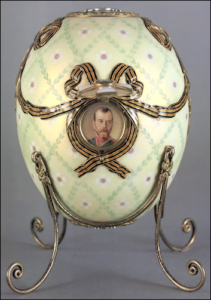
(Forbes and Tromeur-Brenner, Fabergé: The Forbes Collection, 1999, 63)
Marks: Fabergé on medallion
Materials: Silver, gold, translucent orange, opalescent white, opaque rose, pale green white, and black enamel, rock crystal, watercolor on ivory
Dimensions: Height of egg – 90 mm. (3 5/16 in.) | Height with stand – 105 mm. (4 1/8 in.) | Height of case – 184 mm. (7 1/4 in.)
Description: Although less extravagant and perhaps less ingenious than its predecessors, the simple silver egg commemorating the recent presentation of the Cross of the Order of St. George to Nicholas II still reflects Fabergé’s unerring sense of design. Enameled matt opalescent white over a ground trellised with laurel garlands that form frames for paintings of the Cross of St. George, the shell is further decorated with gold ribbons and bows enameled in the Order’s colors, black and orange, and seemingly pendent from the raised chased silver wreath surrounding the dowager empress’s similarly executed cipher. The base is likewise applied with the date.
The surprises are contained behind two medallions tied to the egg with bows of enameled ribbon. Behind the badge of the Order of St. George, a miniature of the tsar is revealed when a small button below the badge is depressed. A miniature of the tsesarevich, who was also awarded a lower grade of the Order of St. George, is similarly revealed from behind a silver St. George medal depicting Nicholas II, when a second button is depressed. Writing to her son after the last untroubled Easter, the dowager empress commented:
The egg retains its original velvet case, stamped inside with a gold eagle and “K. Fabergé/Petrograd/Moscow/ Odessa. London.”
Background Notes: It was the dowager empress’s separation from the tsar and his family that was to make possible her eventual escape from Russia three years later. The Order of St. George Egg left Russia with the seventy-two-year-old Marie Feodorovna when she reluctantly boarded the British battleship Marlborough in the Crimea on April 11, 1919, with her two daughters. On board, the dowager empress wrote in her diary:
She would not see Russia again. Tradition has it that this was the only Tsar Imperial Easter egg that Marie took with her, but the authors have their doubts. (Editor’s note: More information in New Research by Will Lowes in the chapter entitled “Fabergé, the Tsarinas, and the Easter Eggs” published in Lowes and McCanless, Fabergé Eggs: A Retrospective Encyclopedia, 2001)
The Order of St. George was created by Catherine the Great in 1769 to be awarded by the army and not the sovereign, for bravery in battle and was regarded as the highest award in the Russian army. The tsar received his Cross of the Order of St. George on October 25 (OS), 1915. He recorded in his diary that day:
Made of cacholong, it was found hidden in the bathroom of the house owned by the merchant N. N. Ipatiev in Ekaterinburg, where Nicholas II and his family were murdered on the night of July 16-17, 1918. A little more than three centuries earlier at a religious center called the Ipatiev Monastery, 170 miles northeast of Moscow, Michael Romanov had received the news that he had been chosen unanimously to be tsar of all the Russias. The invoice for the 1916 Tsar Imperial Easter eggs has been lost. However, other account books and correspondence survive that indicate that the two Easter eggs produced for 1916 together cost 13,347 rubles. As a note of caution, this total probably includes other, smaller, unspecified items included in Fabergé’s bill.
Provenance:
- April 10 (OS), 1916. Would have been presented to Marie Feodorovna, a gift from Nicholas II; exact cost unknown
- April 11, 1919. Left Russia with Dowager Empress Marie Feodorovna, traveling to Hvidøre, Denmark
- October 13, 1928. Inherited by Dowager Empress Marie Feodorovna’s daughter, Grand Duchess Xenia Alexandrovna, Windsor, England
- April 1960. Inherited by Grand Duchess Xenia Alexandrovna’s son Prince Vasilii Romanov, Woodside, California
- November 27, 1961. Lot 170 sold by Sotheby’s (London) from the Collection of Prince Vasilii Romanov of Woodside, California for £11,000; $30910, to Lumley (Editor’s note: Probably Tom Lumley of Sotheby’s [London] acting as agent for the cosmetics firm, Fabergé, Inc.)
- Fabergé, Inc.
- Acquired by A La Vieille Russie, New York
- March 1976. Sold by A La Vieille Russie for $142,000 to Forbes Magazine Collection, New York
- February 2004. Sold privately as part of the Forbes Magazine Collection, New York, to Viktor Vekselberg, Moscow, for just over $100 million, according to the purchaser
- November 19, 2013. The Fabergé Museum St. Petersburg, Russia
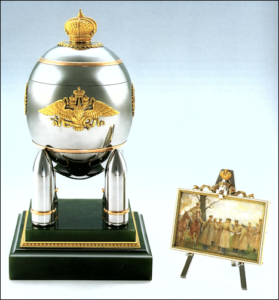
(Muntian, Fabergé Easter Gifts, 2003, 66)
Marks: Fabergé, H. W., 72, kokoshnik
Materials: Egg – gold, steel, jade, white enamel, silk, velvet | Easel surprise – steel, gold, opaque black, orange, and white enamel, watercolor on ivory | Base – gold, steel, nephrite
Dimensions: Height of egg and stand – 167 mm. (6 1/2 in.) | Height of egg – 101 mm. (4 in.) | Height of easel – 65 mm. (2 9/16 in.)
Description: This steel egg, surmounted by a gold Imperial crown and decorated with appliqués of the emblem of the Russian Empire, rests on four artillery shells. It is divided into three sections by two smooth horizontal lines. In the middle section, in inlaid gold, is an image of George the Conqueror in a diamond shaped frame outlined in laurel leaves; the date 1916 encircled by a laurel wreath; Moscow’s coat of arms, consisting of a double-headed eagle beneath three crowns; and the monogram of Tsarina Alexandra Feodorovna, also encircled by a laurel wreath. The egg is surmounted by a golden crown surrounded by a gold wreath. The four steel artillery shells supporting the egg are set on a dual-level square nephrite base. A steel easel in the form the monogram of the tsarina, fits into the egg. The easel supports a gold and white enamel frame displaying the emblem of the Order of St. George surmounted by a golden crown. The frame encloses a miniature painting on ivory by Vasilii Zuiev, depicting Tsar Nicholas II and the tsesarevich at the front during World War I (Brezzo et al., 1989).
Background Notes: H. C. Bainbridge in Peter Carl Fabergé (London, 1949) has left us this moving account of the last Imperial Easter egg received by the Tsarina Alexandra Feodorovna:
The egg now has a polished, silvery look rather than the original dull blackened steel finish. It is possible the finish of the egg may have deteriorated during the years in storage in the Armoury and that it was polished to arrest further deterioration. According to Fabergé, Proler, & Skurlov, in Fabergé Imperial Easter Eggs (London, 1997), the egg was designed by Gustav Shkilter, a relative of Carl Fabergé’s, and made by the Putilovskii steel plant, which was renowned for its high-quality steel.
Alexandra sent a telegram to Nicholas II at the front, which said in part:
This was one of the tsarina’s few positive missives at this time to her husband. By now almost totally under the influence of Rasputin, she was writing frantic letters to Nicholas, imploring him to dismiss one minister of state after another. Most times, Nicholas agreed and did so, but Alexandra’s advice was disastrous to the tsar’s-and Russia’s-cause. Rumors spread that Rasputin, a starets or an unordained holy man, was the tsarina’s lover, that she was in league with German spies, and that she was betraying her adopted country. None were true. Within months the murdered Rasputin’s body would be pulled from the frozen Neva, and the tsarina would drift into a world of hazy sadness and resignation, a world her husband would largely share with her.
The invoice for the 1916 Tsar Imperial Easter eggs has been lost. However, other account books and correspondence survive that indicate that the two Easter eggs produced for 1916 together cost 13,347 rubles. As a note of caution, this total probably includes other, smaller, unspecified items included in Fabergé’s bill.
An expert valuation was made of this egg in 1927. Found by Fabergé, Proler, & Skurlov, the valuation noted that the artillery shells were rusty. The valuation assessed the egg’s worth at 14,205 rubles. George W. Terrell Jr., professor of history and geography at Gadsden State Community College, Alabama, has drawn to the attention of the authors a certain irony regarding the first and last Tsar Imperial Easter eggs given to Alexandra Feodorovna. The first egg, the 1895 Rosebud Egg, was decorated with arrows, and the last, the 1916 Steel Military Egg, rested on artillery shells. How very different was the symbolism inferred by these two types of weapons!
So, incongruously, thirty years of Tsar Imperial Easter gifts, most of them works of great artistry and technical merit, would end with this, an object described by A. Kenneth Snowman as “a banal example of Kitsch” (Snowman, Carl Fabergé Goldsmith to the Imperial Court of Russia, London, 1979). Not only had a glorious Easter tradition ended, but so too, had a great epoch in the history of the decorative arts.
Provenance:
- April 10 (OS), 1916. Would have been presented to Alexandra Feodorovna, a gift from Nicholas II; exact cost unknown
- September 16-20 (OS), 1917. One of forty or so eggs sent to the Armoury Palace of the Kremlin in Moscow by the Kerensky Provisional Government for safekeeping
- February-March 1922. Transferred to the Sovnarkom, the Council of People’s Commissars
- June 17, 1927. One of sixteen eggs returned to the Armoury from the Foreign Currency Fund of the Narkomfin (Finance Ministry); given inventory no. 17551
- Retained by the Armoury Museum of the Kremlin, Moscow
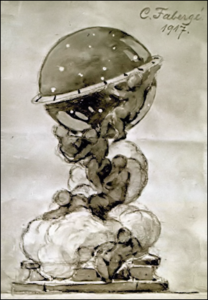
Design Sketch
(Courtesy Tatiana Fabergé)
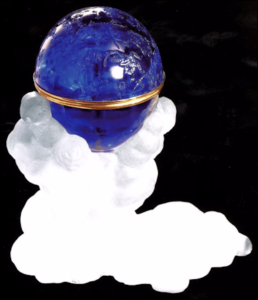
Unfinished Blue Tsesarevich Constellation Egg
(Courtesy Fersman Mineralogical Museum, Moscow)
Marks: Apparently none on those elements have survived
Materials: Egg – dark blue glass, rose-cut diamonds, diamonds and probably silver | Cloud Base – opaque rock crystal | Pedestal – nephrite
Dimensions: Egg (globe) diameter – 77 mm. (3 1/16 in.) | Cloud base height – 110 mm. (4 5/16 in.) | Assembled together height – 220 mm. (8 5/8 in.)
Description: Research in Russia by Tatiana Muntian and Marianna Chistyakova has solved, in part, one of the most intriguing questions surrounding the Tsar Imperial Easter Eggs: what happened to the 1917 eggs in production for Easter? They were never presented because of the February Revolution and the events which followed. In the January 2003 issue of Apollo, Muntian, keeper of the Fabergé collection in the Kremlin Museum, and Chistyakova, keeper of the collection of artistic and precious stones of the Moscow Mineralogical Museum, published details of the Blue Tsesarevich Constellation Egg’s discovery. Major components of the egg, being made for the Tsarina Alexandra, were found in the A.F. Fersman Collection held in the Mineralogical Museum in Moscow.
A letter in the files of Tatiana Fabergé, the great-granddaughter of Carl Fabergé, also sheds light on the 1917 Easter egg, which was in production when Tsar Nicholas II abdicated on March 2 (OS), 1917. The letter is from Fabergé’s chief designer, François Birbaum, to Fabergé’s eldest son, Eugène, and was written in August 1922. In part it says:
One thing I remember for certain is the order of an egg for the Tsar by Ivashev (Editor’s note: A designer in Fabergé’s St. Petersburg headquarters ca. 1898-1918) and Carl Gustavovich. This, you may remember, is an egg of dark blue glass incrusted with the constellation of the day of the Tsarevich’s birth. The egg is supported by silver cherubs and clouds of opaque rock crystal. Unless I am mistaken, the egg contained a clock with a revolving face. The execution of this egg was interrupted by the war. The cherubs and the clouds were finished, but the egg itself with its incrustation and the pedestal were not finished. Where all this has disappeared to I have no idea, and when I visited the House after the raid, I found no trace of this article. (Fabergé, Proler, & Skurlov, Fabergé Imperial Easter Eggs, London, 1997)
Birbaum then goes on to describe what may well be the Karelian Birch Egg being made for the Dowager Empress Marie Feodorovna in 1917. He concludes:
Eugène Fabergé had apparently written to Birbaum for details of these eggs after receiving a letter from Henrik Wigström in Finland, seeking payment for work on the two eggs. Wigström was Fabergé’s senior workmaster at the time.
Muntian and Chistyakova uncovered the unpolished clouds of rock crystal, together with the two halves of the egg, cut from an evenly shaded and intensely colored blue glass. The two halves are hollow, which they say “can be explained by the fact that they would have been needed to contain a (clock) mechanism”. Muntian and Chistyakova speculate that it is “possible the sphere held by the cherubs would have rotated”. Apart from the constellation indicating the Tsesarevich’s birth date, the globe is also engraved with several other constellations “including Cygnus, the Serpent, the Great and the Little Bear, Lyra, Hercules, Orion and the Northern Crown” (Muntian & Chistyakova, Apollo, January 2003).
The silver cherubs mentioned by Birbaum and depicted in the 1917 drawing of the egg, are not in the Fersman Collection. However, pencil marks are visible in the opaque cloud formation, which may indicate where the cherubs were to be fixed. The nephrite pedestal on which the egg was to stand, and which had not been completed, is also not in the collection. Muntian and Chistyakova add:
Background Notes: Nothing was known about the Tsar Imperial provenance of this egg until research was published by Fabergé, Proler, & Skurlov, in Fabergé Imperial Easter Eggs (London, 1997). It had been widely assumed that the Twilight Egg, which made a sudden appearance at a Christie’s auction in Geneva in November 1976, was the Easter gift being made for Alexandra Feodorovna.
A drawing of what is now known as the Blue Tsesarevich Constellation Egg was first published in A. Kenneth Snowman, Art of Carl Fabergé (London, 1953), plate 355. Now, Muntian and Chistyakova have pieced together when and how the unfinished Tsar Imperial egg came to be the Fersman collection. The Mineralogical Museum inventory includes “a blue cut-glass globe of a base of crystal. Work by Fabergé.” (Muntian and Chistyakova, Apollo, January 2003)
The inventory notes that these pieces were presented by Agathon Carlovich Fabergé (1876-1951), the second son of Peter Carl Fabergé. (Editor’s note: For more detail on Agathon Fabergé see “Who Was Who in the House of Fabergé” in Lowes and McCanless, Fabergé Eggs: A Retrospective Encyclopedia, 2001.) Agathon knew Alexander Fersman (1883-1945) well and probably entrusted these items and other important Fabergé articles to his care. Shortly after, Agathon fled Russia, never to return. Remarkably, it seems he never told his brothers of his actions.
Tatiana Muntian has summarized the Blue Tsesarevich Constellation Egg thus:
However, there is another claimant to be the Blue Constellation Tsesarevich Egg. The London-based The Art Newspaper reported in its June 30, 2005, issue about two eggs which had been put on show in Moscow. One of them was the 1917 Karelian Birch Egg, the other purportedly was the Blue Constellation Tsesarevich Egg. While some Fabergé experts are prepared to endorse the former, few are prepared to believe the latter egg is genuine. This egg is intact, complete with a nephrite base, and is owned by the Russian National Museum. Its director, Alexander Ivanov, claimed his version of the Blue Constellation Tsesarevich Egg was authentic, and the other endorsed by Muntian and Chistyakova was not. The latter, he said, was originally designed by Fabergé as “a lighting fixture.”
Ms. Muntian told The Art Newspaper:
Valentin Skurlov says he has not seen the Ivanov version, and cannot comment. The Art Newspaper quoted Peter Schaffer of A La Vielle Russie, New York, as being “equally mystified.”
The item is possibly based on the clock in the form of a celestial globe supported on a circular plinth, the hours and minutes shown on a revolving band. The item is of gilt-bronze, the globe of matt blue enamel, with an ebony plinth decorated with boullé marquetry, surmounted by a flying cupid. 65 cm. high, it was made by Martin of Paris, ca. 1720, and is in the Bowes Museum, County Durham, UK. This museum is also home to the famous automated silver swan by James Cox, on which the 1906 Tsar Imperial Swan Egg is based.
It would appear that for the last Tsar Imperial egg, like the very first, Fabergé took a design from an earlier century and, as he done in the past, adapted and improved the technical quality, balance and aesthetics of the piece.
Provenance:
- 1917. In production for presentation to Alexandra Feodorovna on April 2 (OS), Easter Sunday. Never presented; the unfinished egg apparently remained at Fabergé’s premises until removed by Agathon Fabergé
- 1925. Elements of the egg presented to Alexander F. Fersman of the Moscow Mineralogical Museum by Agathon Fabergé
- 2002. Discovered in the Fersman Moscow Mineralogical Museum
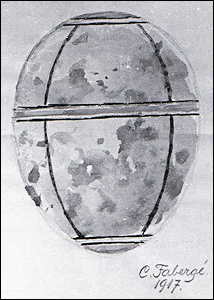
(Fabergé, Tatiana, Proler, Lynette G.
and Valentin V. Skurlov. The Fabergé
Imperial Easter Eggs, 1997, 63)
Henrik Wigström, Fabergé’s senior workmaster at the time of the October Revolution of 1917, had apparently written to Eugène Fabergé from Finland, seeking payment for work on this egg and its companion piece for Alexandra Feodorovna, the Blue Tsesarevich Constellation Egg.
Tatiana Fabergé also found a box of old photographic glass negatives, which included drawings of Fabergé eggs dated 1917. One was immediately recognizable as the Blue Tsesarevich Constellation Egg, while the second “matched Wigström’s description of a simple wooden egg, which was probably made of Karelian birch. The drawing clearly shows that the shell of the egg was designed in two halves which could be opened to reveal a surprise.” (Fabergé, Proler, & Skurlov, Fabergé Imperial Easter Eggs, London, 1997)
Tatiana Fabergé also found an intriguing entry in an inventory made of treasures taken from the palace of the late Grand Duke Vladimir Alexandrovich, brother to Alexander III, just five days after the October Revolution of 1917: “Wooden egg in gold setting, inside and elephant, mechanical, silver and gold, with rose-cut diamonds.” (Fabergé, Proler, & Skurlov, Fabergé Imperial Easter Eggs, London, 1997).
This surprise could have represented the Danish Elephant Order, and of course, the Dowager Empress Marie Feodorovna had been born the Danish Princess Dagmar. Fabergé had used the elephant motif in the 1892 Diamond Trellis Egg for Marie. Why he would elect to repeat such a theme is unknown. Another unresolved question is how did a supposedly unfinished or at least undelivered Tsar Imperial Easter Egg come to be among the Imperial treasure?
However, Birbaum, in his August 1922 letter to Eugène Fabergé, sounds a note of caution, saying that since he did not design the 1917 Easter eggs he could not say anything about them. There is also an element of irony here. Grand Duke Vladimir Alexandrovich, brother of Tsar Alexander III, acted as adviser in regard to the very first egg (First Hen Egg), presented to Marie Feodorovna in 1885 and the last egg meant for her, the Karelian Birch Egg, thirty-two years later.
- 1917. In production for presentation to Marie Feodorovna on April 2 (OS), Easter Sunday. Never presented; the unfinished Egg apparently remained at Fabergé’s premises.
- 2015. Whereabouts unknown

